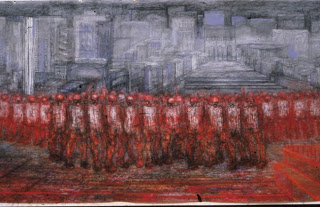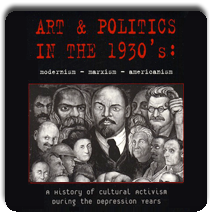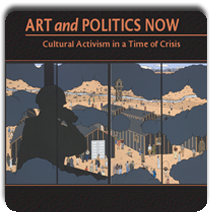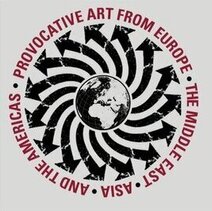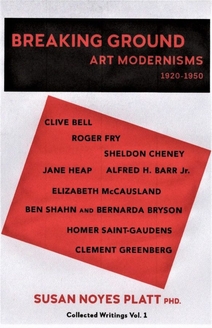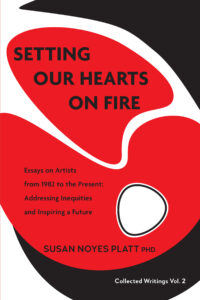Port Townsend marks its history with Indigenous groups
And what a horrifying history it is ! The čičməhán (Chetzemoka) Trail. named after čičməhán(Cheech-ma-han) the great leader of the Klallam tells that story in all its vivid detail. Here is an overview of part of the trail. It includes most of the sites that we found ( we were driving and walking). But aside from the natural beauty of Port Townsend, it was quite a revelation to read this history.
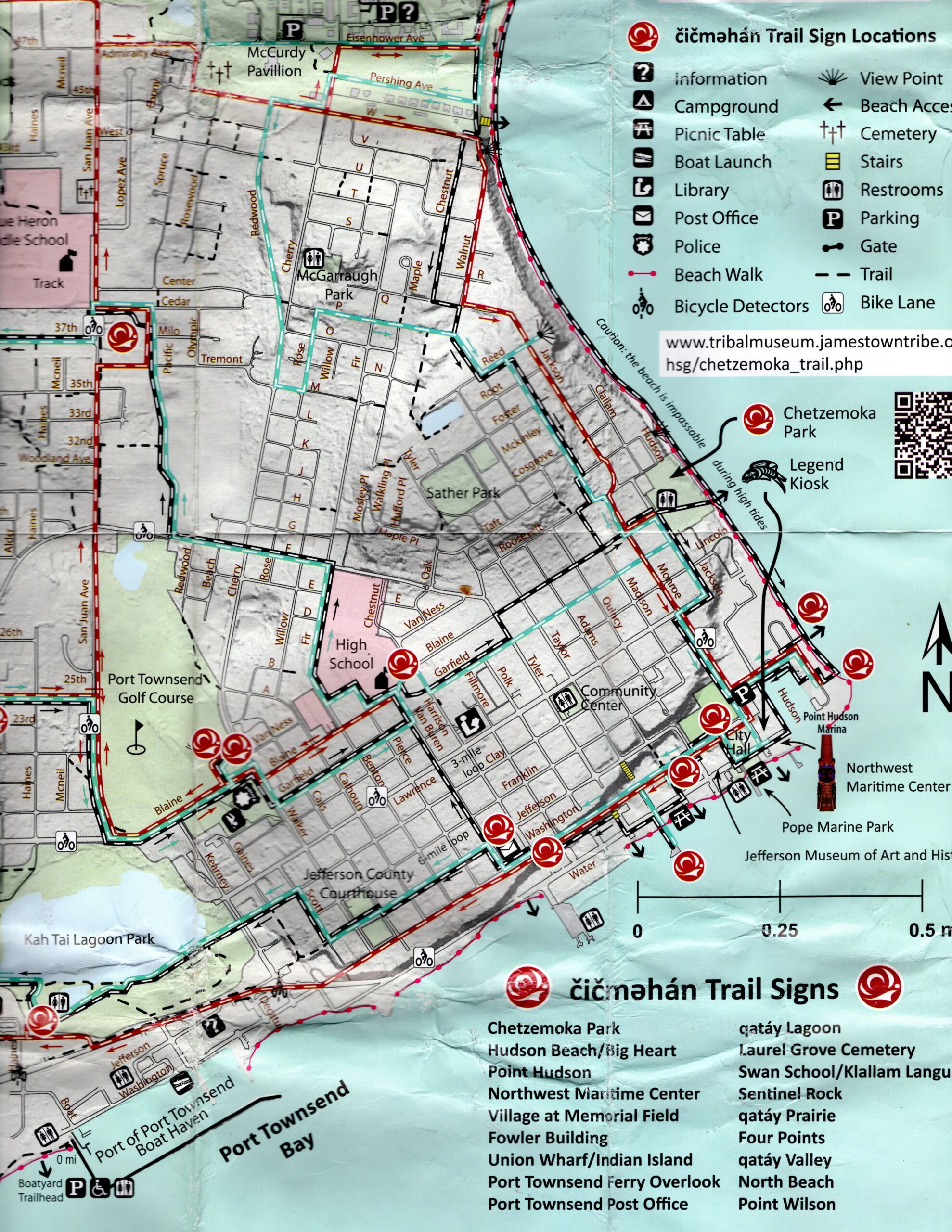
The first site we went to was at the North end of downtown Port Townsend
It told the story of “Chetzemoka’s Big Heart, a story by Mary Ann Lambert of the Jamestown S’Klallam Tribe’s Lambert/ Reyes family (1879-1966, also the author of The 7 Brothers of the House of Ste-Tee-Thlum). It illustrates Chetzemoka’s heart, and the power and respect he commanded.”
An army garrison was built on this site in 1856 ( see next sign, this was one year after the Treaty of Point No Point) to “quell Indian rioting” As it turned out it was the soldiers who created the problem:
“However, the soldiers were known to frequent the saloons of Port Townsend and overindulge. One day two drunken soldiers, realizing they had overstayed their leave, stole an Indian canoe from the S’Klallam village at Point Hudson, and subsequently drowned when a southeast squall arose across the bay.
Townspeople assumed that the soldiers had been killed by Indians, and when a youth named Tommy Shapkin found one of the soldier’s bodies on the shoreline and donned his cap and jacket, he was accused of murder. He was jailed and a hanging scaffold was built. When the youth was brought to the platform, another S’Klallam youth ran to find Chetzemoka.
Forcing his way through the dumbfounded crowd, Chetzemoka approached the scaffold. Without a word he mounted the steps and reaching into his belt the Duke of York [as he was nicknamed] withdrew a knife, reached up and cut the knotted noose and threw it upon the ground below. Then removing the blindfold from the boy’s eyes, he said “Go, my kinsman. You are free!” Turning and facing the astonished crowd, Chetzemoka said (in Chinook), “Friends, this is Indian Country, our country. There never was a time when it was not our country. We are Klallams. Once we were strong, proud people. Because of sickness and death, we have diminished in numbers until now we are no longer a strong people.
But we are a proud people. We will not be the first to spill Boston blood upon our beloved land. You Bostons are a strong people. Do you wish to be the first to spill Klallam blood upon this soil which once belonged to us? Have you no pride?” “Bostons,” he continued, “We have been friends. Let us remain friends. If this unwise act which you were about to commit is what you call civilization, then give us back our way of life. Oh, White People, our brothers under the skin, do not let this happen again.”
The site where he stood was an Indian village until white men arrived. This sign at the point reads
“Before the shoreline was altered to create the marina, Point Hudson was a popular clamming beach for S’Klallams and a landing point for tribes from locations across the Olympic Peninsula.
Change began as soon as settlers arrived, but grew harsher after čičməhán (Cheech-ma-han) and many other S’Klallam sub-chiefs signed the Treaty of Point No Point in 1855. It was not ratified by Congress until 1859, and through the 1860s, the Natives waited for financial compensation from the government, but they were not paid. In 1867, the City of Port Townsend passed an ordinance prohibiting any Indian housing, tents, mats or fires in the downtown area, and in 1871, their village was destroyed by fire, by order of the Superintendent of Indian Affairs.
In the 1890s, Makah and other Tribes used Point Hudson as a camping site on their way to and from the hops fields near Puyallup, where they were seasonally employed as hops harvesters.” On the link to the text are old photographs of tribal groups camping on the point in the late nineteenth century, after the original village was destroyed by fire.
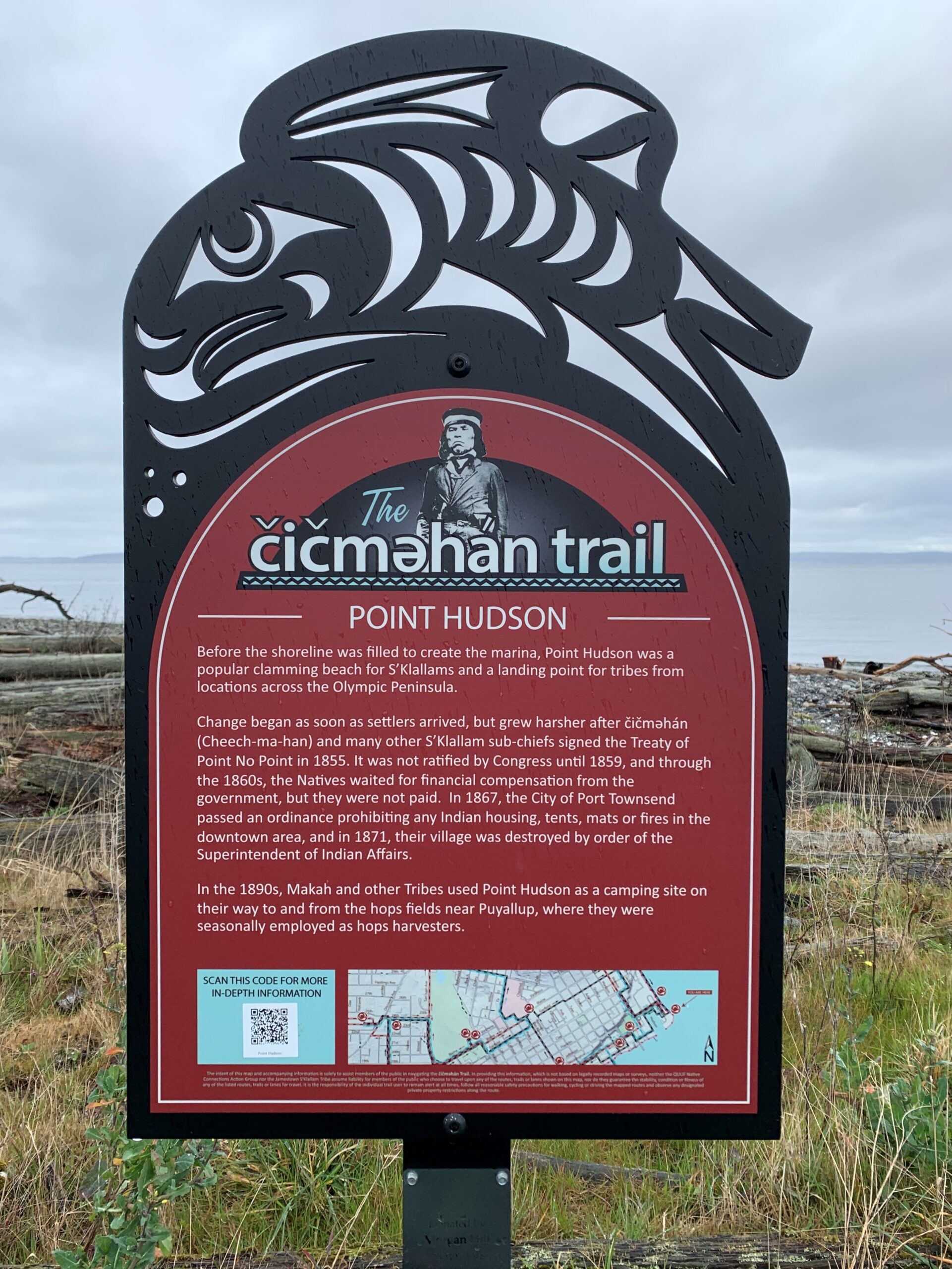
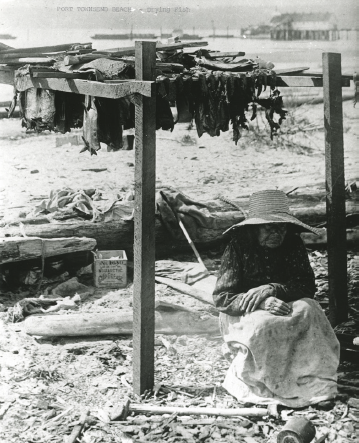
Grandma Newman Drying Salmon at Pt Hudson.
As we headed downtown, we saw a new totem created in honor of the creation of the trail outside the Northwest Maritime Center. It gave a lift to our spirits from the sad story of the destruction of the villages on Hudson Point
Here the sign reads
“The Jamestown S’Klallam Tribe, like the Northwest Maritime Center, is a contemporary organization with a tremendous appreciation of our seafaring history and respect for those who have preserved and shared their knowledge throughout the centuries.
The sea is all around us on the Olympic Peninsula: the sound of the tides and seabirds; the salty aroma in the air; the edible abundance that has sustained us for millennia; the navigable waterways that allowed us to move freely among and between our villages and our neighbors. For the S’Klallam people, the sea is a major character; the backdrop of our lives. And we know that we share that deep sentiment with those who have devoted themselves to creating and sustaining the Northwest Maritime Center
It is with that sentiment of shared vision that the Tribe and the Center agreed that a totem pole and a canoe carved of Western Red Cedar, and an interpretive sign about Coast Salish Canoe Culture were appropriate symbols of our shared interests and ongoing partnership in the 21st century.”
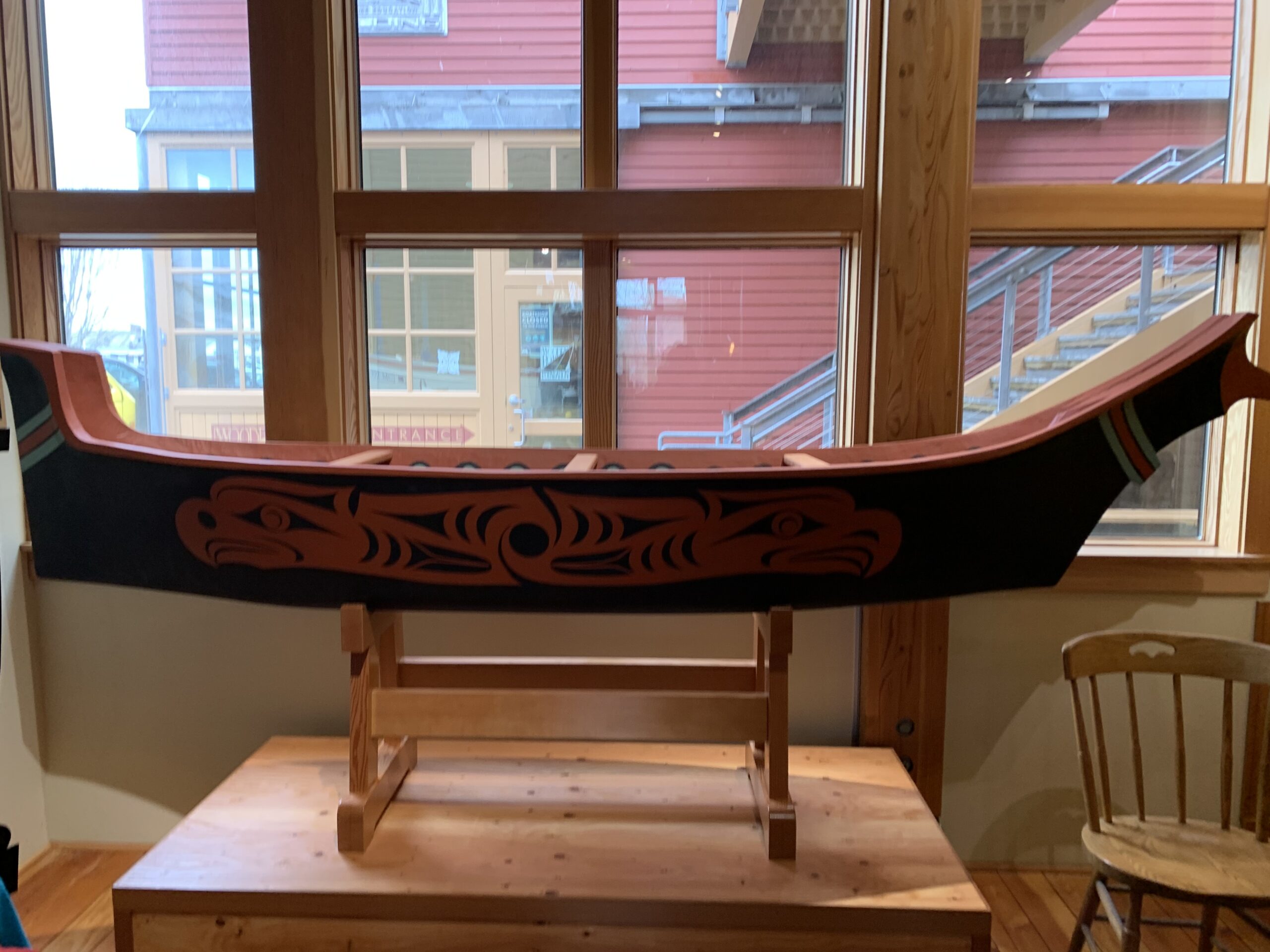
Nootka “Chinook” style canoe created for food and natural resource gathering also for fishing, seal hunting and whaling. Used by many tribes along the coast.
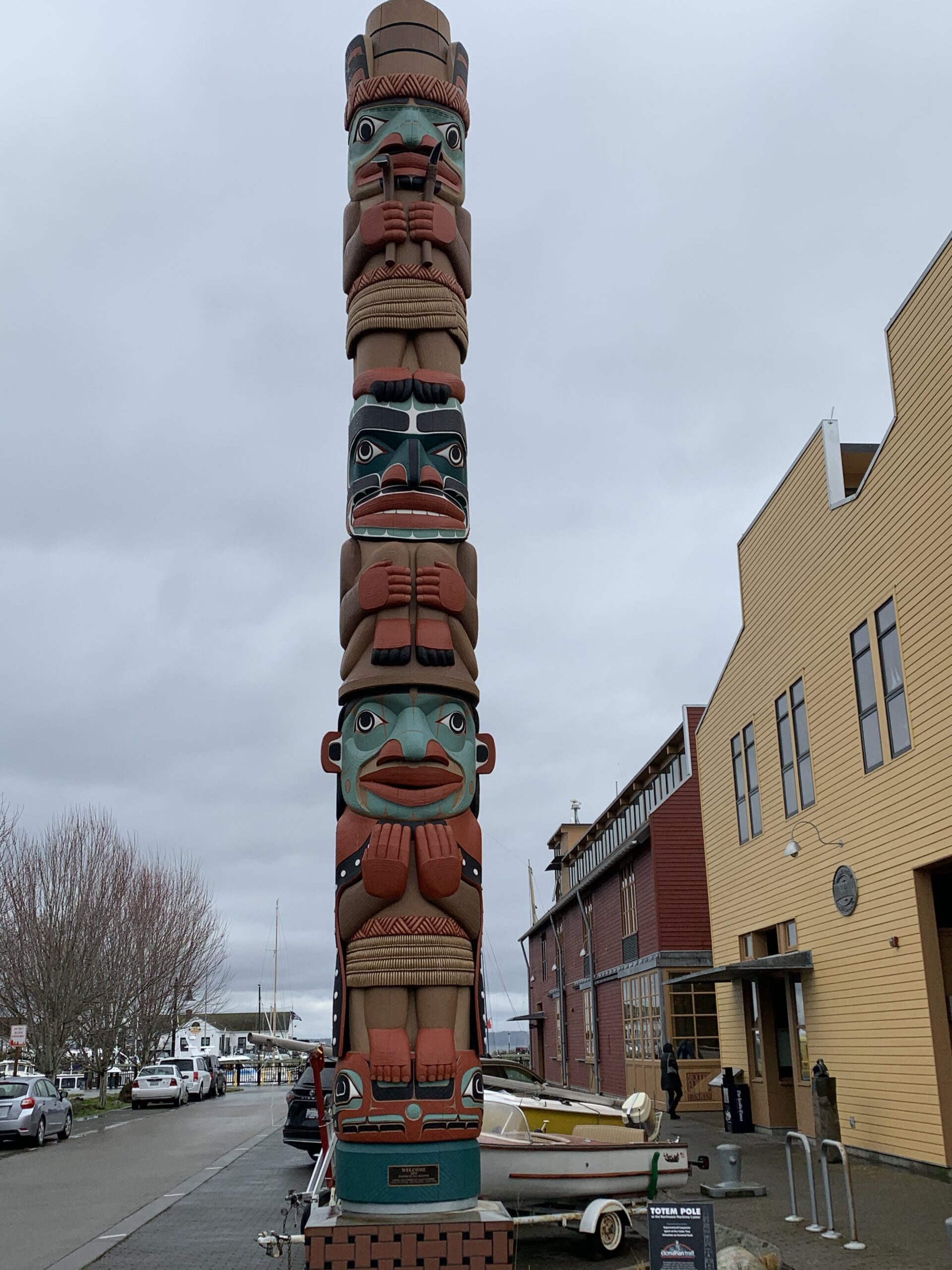
From the website
“Outside the Northwest Maritime Center you will see the 26’ totem pole carved by Dale Faulstich, Andy Pitts, Tyler Faulstich, and Tribal citizen Timothy O’Connell. You will also see the Coast Salish Canoe Culture sign, and a traditional canoe hanging in The Chandlery.
The totem pole pays homage to millennia of finely crafted wooden boats and the artisans who built them. It features, starting at the top, the Supernatural Carpenter, the Spirit of the Cedar Tree, čičməhán with his arms in the welcoming posture, standing on Sentinel Rock.”
The next site was called “The Village at Memorial Field.” Today it is near a playing field. It is the site of the original village
“The village of qatáy once sat near the bluff at what is now the corner of Monroe and Water Streets. It was the principal village of S’Klallam people at the time of the treaty signing, and home to their Chief, čičməhán (Cheech-ma-han).
James Swan’s 1859 census showed “300 whites and 200 Klallams” living in Port Townsend. qatáy village was burned on August 23, 1871 by order of the federal government, prompted by complaints from the settlers. Destruction of the village of qatáy forced many of the S’Klallam to move to the Skokomish Reservation, Port Gamble, Port Discovery, or to join family in Dungeness (stətíɬəm), who would purchase land at Jamestown in 1874. Others, including cicm?hán and his family, moved across Port Townsend Bay to Indian Island, where villages had been located for hundreds of years.
Many S’Klallam adjusted to non-Indian communities, working at local mills, on farms, fishing and providing water transportation to settlers on land and waters that had always been Native homeland.”
For more details on the destruction and removal of the Indians in the village in 1871 see the website. text for this site. It is full of horrifying details as well as photographs of the era.
Nearby is the “Fowler Building.”
“Port Townsend’s first stone building was completed in 1874 for Enoch S. Fowler.
Fowler was a ship captain who transported Governor Stevens and his treaty negotiators from place to place, including Point No Point in 1855, where Stevens, Fowler and čičməhán (Cheech-ma-han) convinced the Natives to trust the whites and affix their “X” mark to the Treaty. Under considerable pressure, the tribes ceded their rights to nearly 440,000 acres of land, receiving in return a 3,480-acre reservation on Hood Canal, the “right of taking fish at usual and accustomed grounds and stations,” and $60,000 payable over 20 years.
When čičməhán died on Indian Island in June 1888, his sons brought his body into town by cedar canoe. Townspeople honored their old friend, who had prevented conflict to save his people, by laying his body in state in the Fowler Building’s main parlor for two days, where settlers paid their respects prior to his burial at Laurel Grove Cemetery.”
But it gets worse. After removing the Indians to Indian Island, they were then removed from Indian Island at the beginning of World War II.
The next stop was called Union wharf/Indian Island
“Looking south, view Kilisut Harbor and Indian Island (now Naval Magazine Indian Island). Archeological evidence shows that Indian Island was an important location to the ancestors of the S’Klallam and Chimacum people for over 1,500 years. For many centuries, sea level was as much as 7 meters lower than today, making the harbor a fertile wetland.
In 1870,čičməhán (Cheech-ma-han) met with a Territorial delegate, asking that the Tribe be given Indian Island as the S’Klallam reservation, but that request was denied.
čičməhán and his family, including his two sons Charlie Swan York and Prince of Wales, moved to the village at the northeast corner of Indian Island called šéʔnəkw, after being forcibly removed to the S’Klallam Indian Agency (the Skokomish Reservation in Hood Canal) from Port Townsend in 1871.
Real estate records show that in 1887, a parcel of land was sold by Catherine McCurdy to pačwíɬəs (Prince of Wales) and Charlie York, the sons of čičməhán, and to James Webster (Chimacum Jim) and his wife Louise, whose descendants are citizens of today’s Port Gamble S’Klallam Tribe. In 1888, pačwíɬəs purchased additional land at šéʔnəkw from Ms. McCurdy and maintained ownership and residency there until 1941.
Indian-owned lands on Indian Island were lost when the federal government took it through the Eminent Domain process in 1939-41, to convert the island into a Naval base.”
It is still a military zone today.
We missed a site downtown here near the ferry dock, but we went to the Post Office where the chief and his family are incised in the capitals of a Richardsonian Romanesque style post office. Here they are from website: 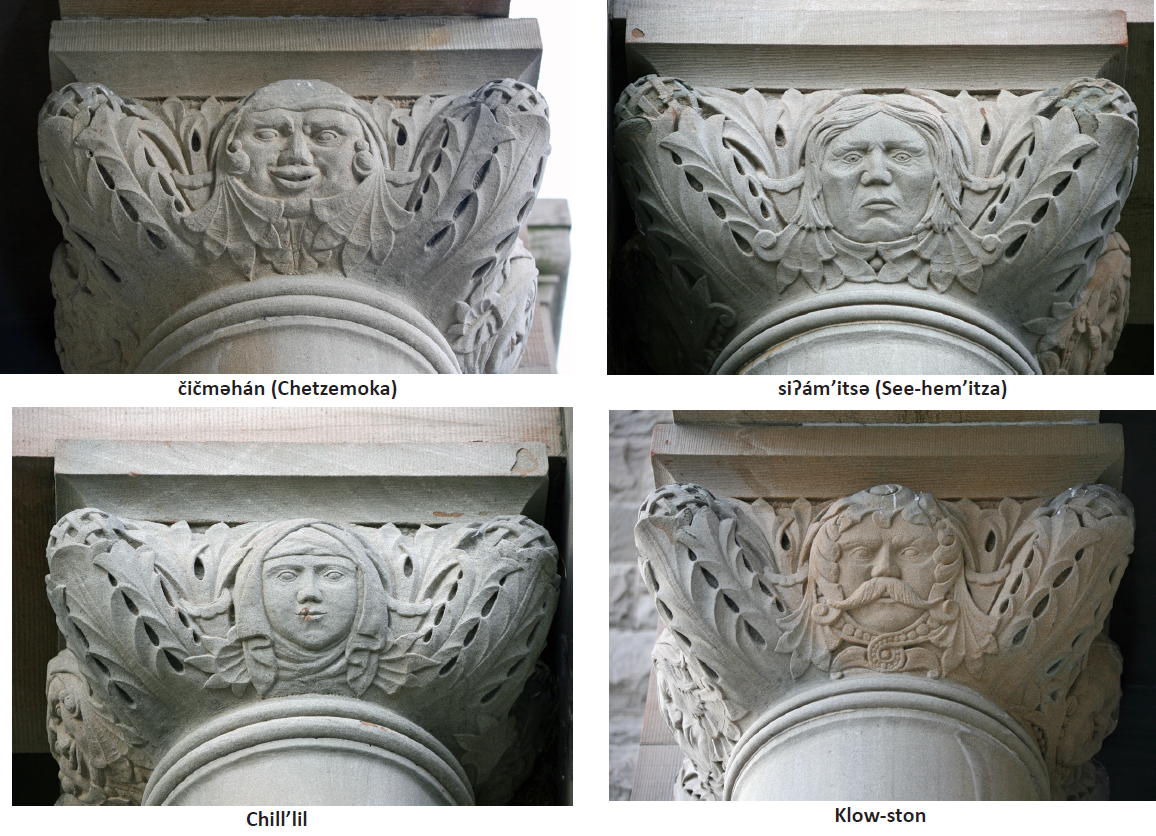
I find this a little grotesque, that after destroying their culture they put them into stone capitals, another form of colonization.
“čičməhán (Cheech-ma-han) inherited his role as chief when his brother Klow-ston left the area, and he was officially recognized as “Chief of the Klallams” by the federal government in 1854.
When settlers Hastings and Pettygrove first arrived in 1851 and met čičməhán, they sent him to San Francisco to reinforce his understanding of coming changes (in population and technology). His tour guide was James G. Swan, with whom he became a lifelong friend. In 1859 Swan wrote that čičməhán returned from San Francisco “with very enlarged views of the number and power of the white man.” The trip provided by the new settlers seemed to sober the Chief, who tried to mediate between the whites and Natives from that point on.”
The post office was built five years after his death. I wonder how much he lived with regrets for trying to “mediate” with whites who betrayed his people over and over.
From downtown we went to Fort Worden, Point Wilson, where Admiralty Inlet and the Straits of Juan de Fuca collide. A dramatic tale of a whirlpool awaited us there.
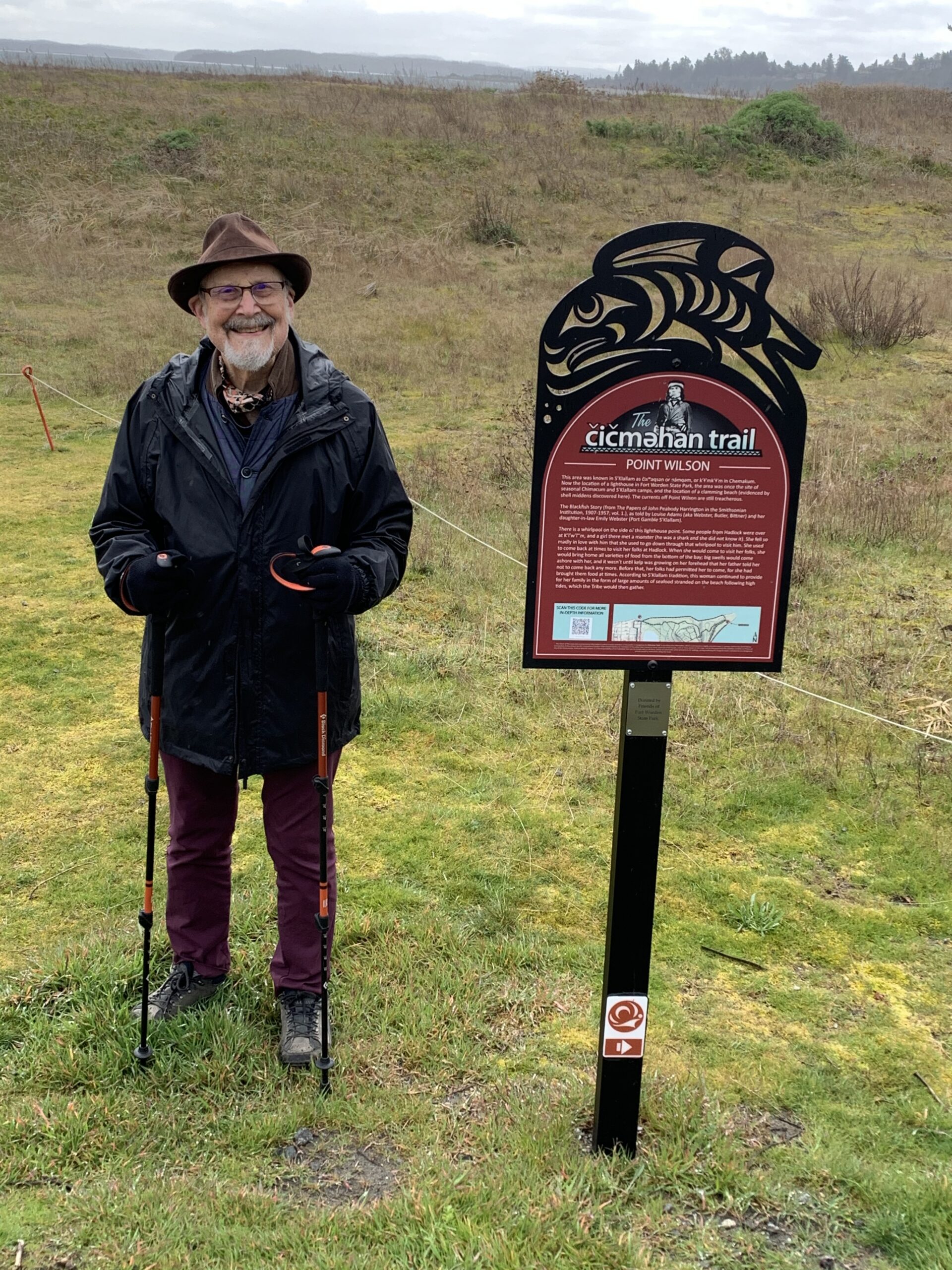
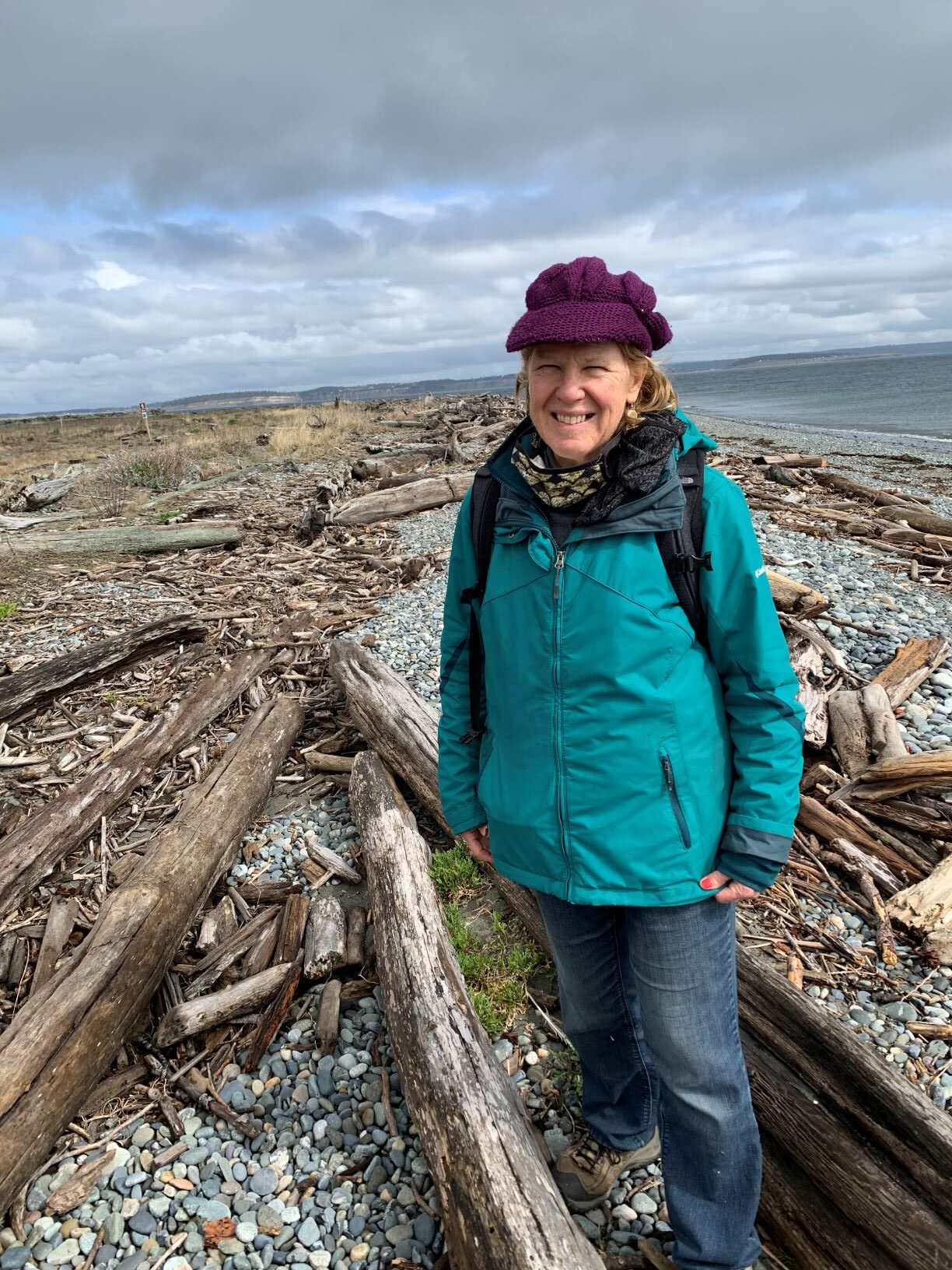
From the sign you see Henry standing near.
“There is a whirlpool on the side of this lighthouse point. Some people from Hadlock were over at K’l’w’l’’m, and a girl there met a monster (he was a shark and she did not know it). She fell so madly in love with him that she used to go down through that whirlpool to visit him. She used to come back at times to visit her folks at Hadlock. When she would come to visit her folks, she would bring home all varieties of food from the bottom of the bay; big swells would come ashore with her, and it wasn’t until kelp was growing on her forehead that her father told her not to come back any more. Before that, her folks had permitted her to come, for she had brought them food at times.”
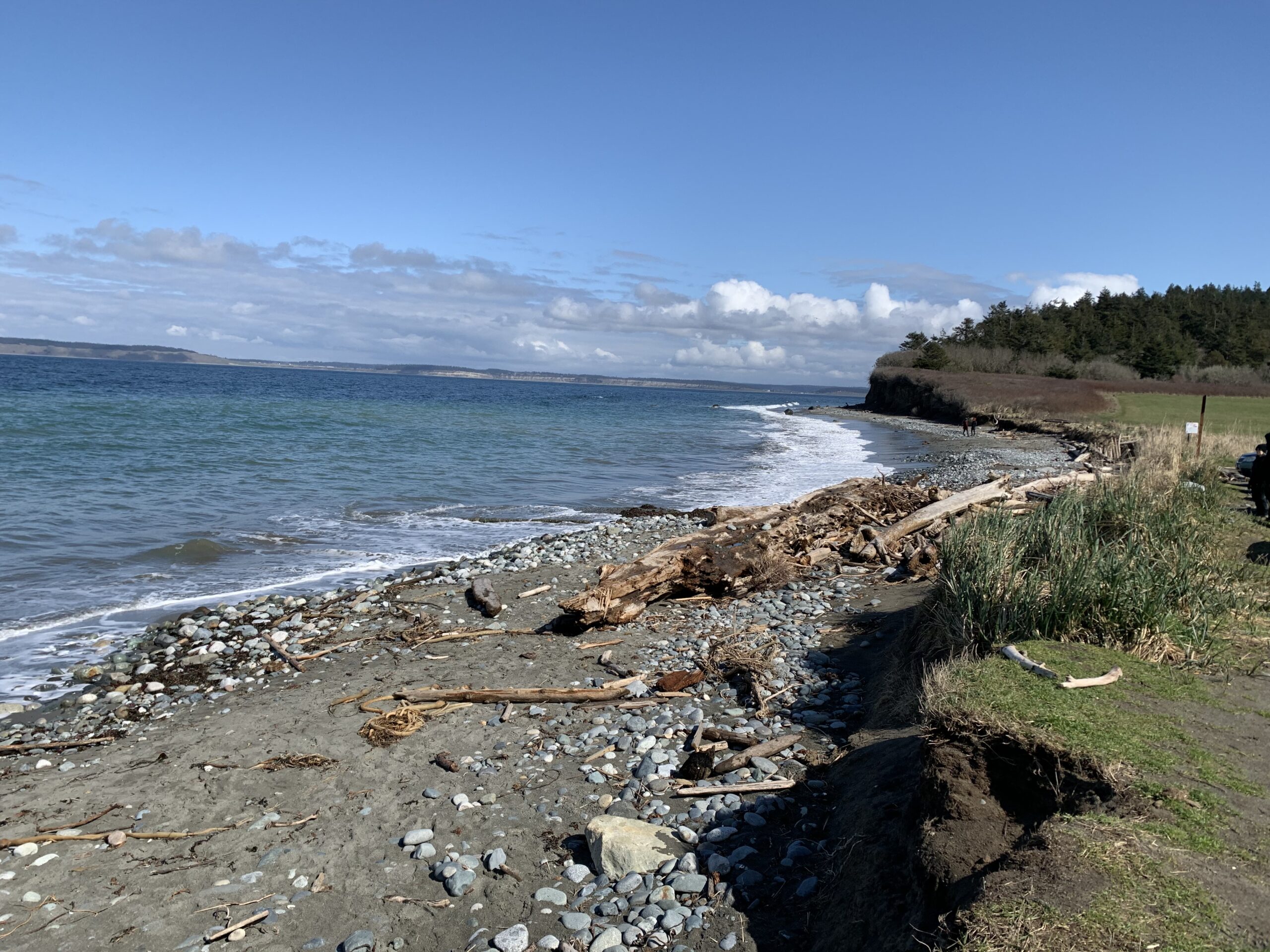
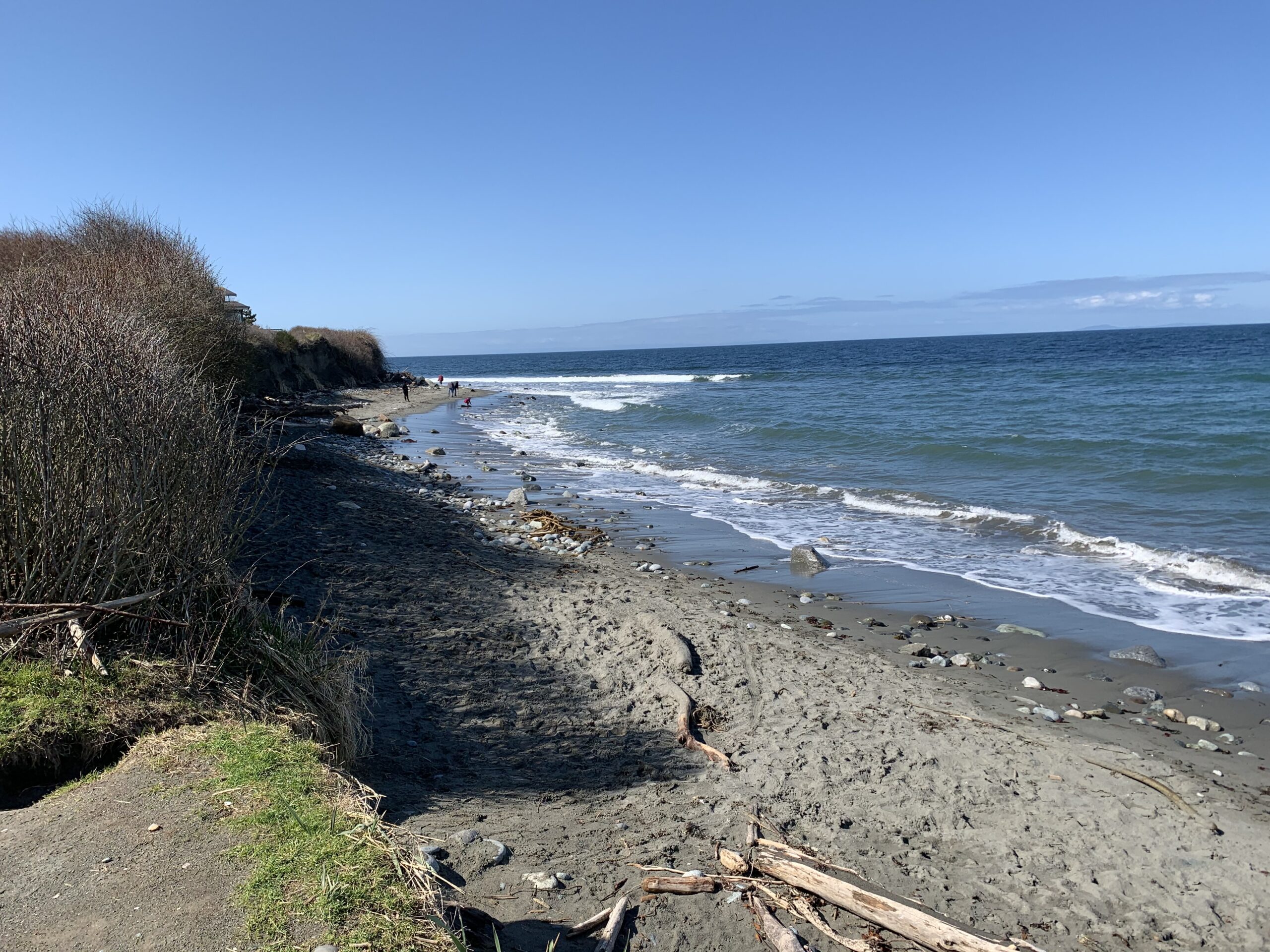
Next we went to North Beach where we had lunch and learned that the Indians carried their canoes around this dangerous point.
The last place we went to was qatáy (kah-tai) Valley,
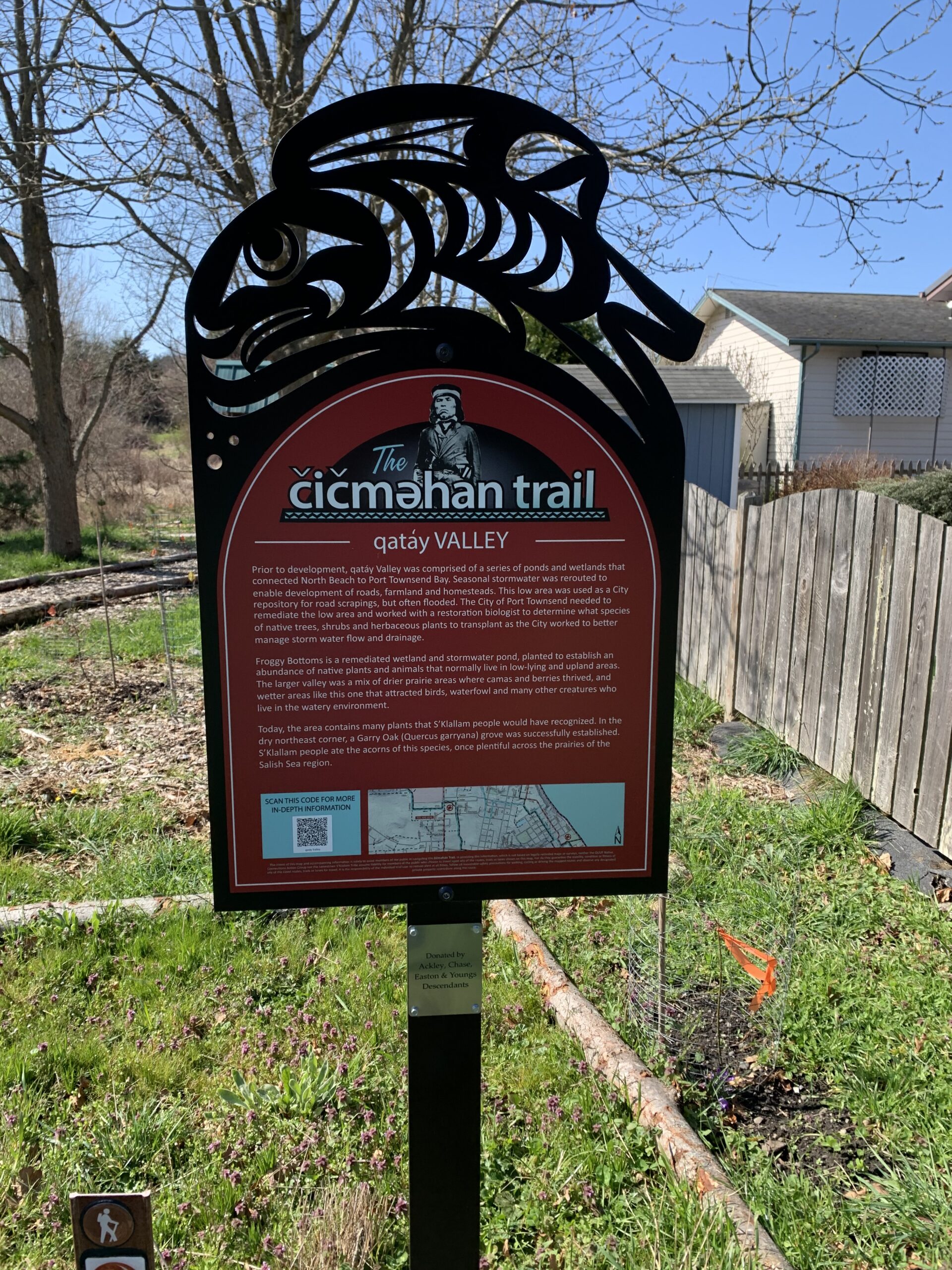
“This site is the last remaining vestige of the natural prairie that spanned the qatáy (kah-tai) Valley, between wetland areas. Relatively dry, upland areas of the valley provided camas bulbs (qwɬúʔi in Klallam and Camassia quamash in Latin) for S’Klallam people to eat. The 1.4-acre camas prairie was officially preserved by the Olympic Peninsula Chapter of the Washington Native Plant Society in 1987.
Camas harvesting was done by women, who broke ground with digging sticks (generally made of fire-hardened Ironwood, or Ocean Spray). They had to be well aware of the difference between blue and white (death) camas, in order to harvest only the edible variety. They turned over a section of ground, pulled out the largest camas bulbs, and returned the earth to its original spot to continue growing.
The bulb of blue camas, a main carbohydrate of the S’Klallam diet, was roasted and ground into a starch that could be stored for winter. Radiocarbon dates from camas ovens at Ebey’s Prairie, on Whidbey Island directly across Admiralty Inlet from Port Townsend, suggests these traditional cooking methods are at least 2,000 years old.”
There were six other sites that we missed for various reasons. You can read about them all on the website.
Over all it is a story of terrible betrayal. I can no longer look at the Victorian architecture of Port Townsend. All I see is the death and destruction of a culture that laid the foundation for the death and destruction of our planet that we are dealing with today. Apparently though Chetzemoka has dozens of descendents today, so the Natives survived through incredible odds. Here is what was placed on his gravestone:
Chetzemoka (Duke of York)
June 21, 1888
The white man’s friend;
we honor his name.
This entry was posted on April 6, 2021 and is filed under Art and Ecology, Art and Politics Now, art criticism, ecology, Indigenous History, Uncategorized.
Selma Waldman More Important Than Ever in 2021
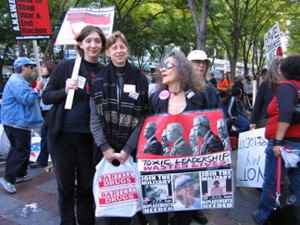
“Lust for power and territory is the same lust that kills man, women, children and the land itself” Selma Waldman 2002
What would Seattle’s deeply political artist Selma Waldman think of our current catastrophes?
On a bitter winter day in January 2008, I accompanied Selma Waldman to the last demonstration that she attended before her death in April. “Shut Down Guantanamo” began with a demonstration of waterboarding. A young man, tied face down on a board, had a wet towel over his face and water poured over his head into a bucket. Even in the simulation, the volunteer felt as though he was about to drown.
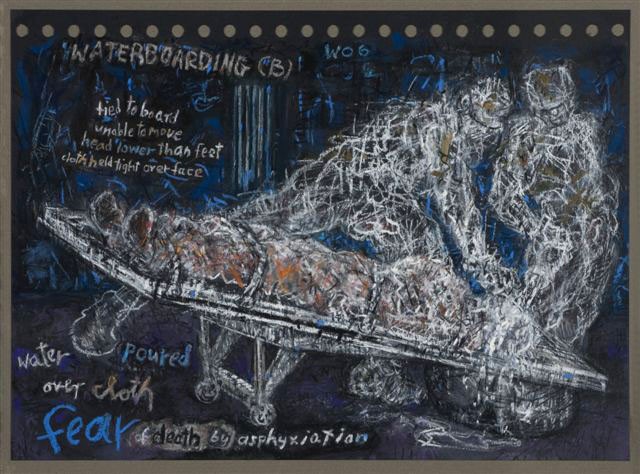
During the speeches that followed by politicians and political activists, we held up enlarged images of one of Selma’s explicit drawings of waterboarding from her long series Black Book of Aggressors. They scrupulously depict in her expressionist drawing technique, several means of waterboarding, with detailed text taken from newspapers. Selma urgently said in my ear, “But it shouldn’t be only Guantanamo, what about the black sites, the other places of torture.” She always understood that one place is connected to so many other places; one manifestation of torture connects to the will to power everywhere, the will to oppress, the desire to destroy the human spirit.
“A Conversation in Time and Space” presents thirteen of Selma Waldman’s monumental drawings at the Center on Contemporary Art partnered with nine brave COCA members responding to her forceful work and statements with their own art and commentaries (all of which can be seen and read on the COCA website https://cocaseattle.org/time-and-space until February 20).
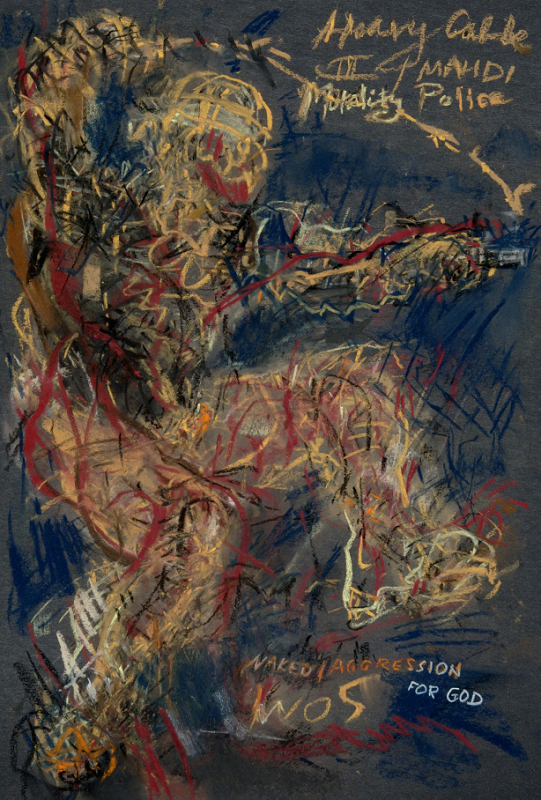
Naked Aggression Heavy Cable
Waldman’s art embraces the classical tradition of Käthe Kollwitz in her expressionist line. The materials of chalk and charcoal were part of her politics as well, a metaphor for the fragility of life.
How ironic that this timely exhibition cannot be visited in person. The current disasters we face, COVID-19, climate change, homelessness and hunger, intersect with the abuses Waldman addresses: torture, detentions, endless wars, starvation.
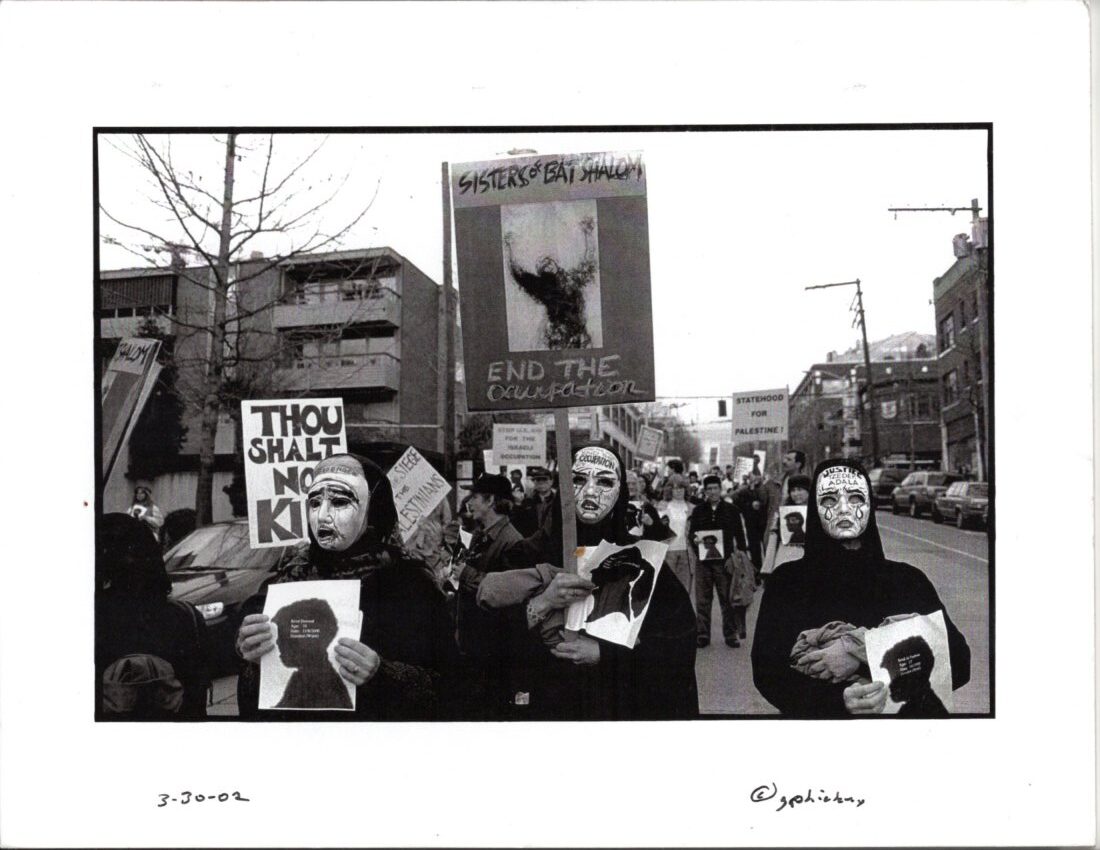
So we can answer the question: she would immediately call attention to these intersections all seated in an obsession with power, what she called “Naked/Aggression.”
Rainer Waldman Adkins carefully selected the works to touch on large themes in his mother’s work: the Holocaust series called Falling Man Suite from 1966, The Man and Bread series, featuring extreme desperation in famine, police brutality in The Thin Naked Line, drawn after the 1999 World Trade protests in Seattle and the aggressions of war, in nine images from the over 80 works in the “Black Book of Aggressors,” in the long cycle called Naked/Aggression-Profile of the Armed Perpetrators first begun in the late 1990s.
Waldman grew up in Kingsville, Texas, deep in South Texas, where everyone was employed by the mighty King Ranch. The giant cattle ranch employed hundreds of Chicano workers. She belonged to the only Jewish family in the town. Although her own family was middle class, she learned about oppression as a way of life in her early years from Chicano/a friends.
When Waldman was on a Fulbright Fellowship in Berlin, she was profoundly affected by the 1960 documentary Mein Kampf. She began a series of drawings of dehumanized and distorted figures based on images and accounts of the Warsaw ghetto. These are the first works on the Nazi holocaust by a Jewish American artist to be acquired by a German museum.
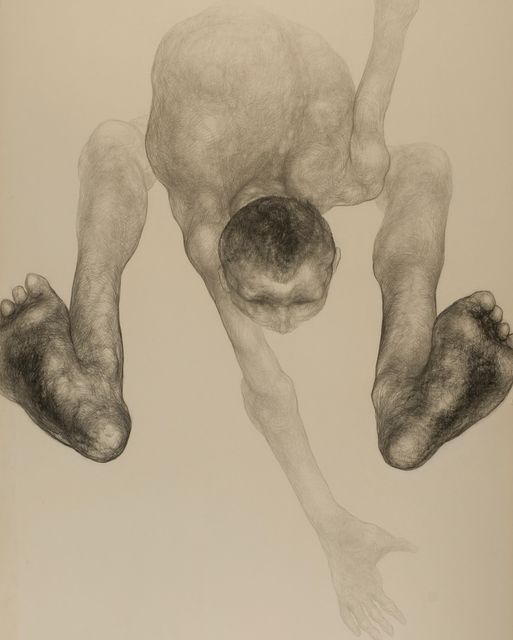
Collectively titled Falling Man, the ninety drawings are near life-size representations that were dramatically hung from the ceiling and stairwell of the Jewish Museum in Berlin. This is the source of the Falling Man Series, represented with one huge drawing at COCA called “The Doll.” The helplessness of the naked figure brings us directly to our current crisis as so many people lose their homes and live in the streets in desperation.
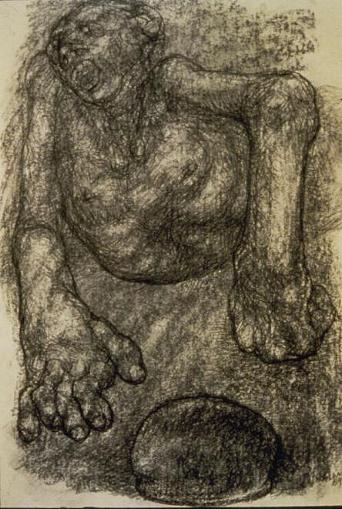
The “Man and Bread” drawings of the late 1960s take the Falling Man series to brother against brother, a fragment of the wretchedness inflicted on so many masses of people. The two Bread drawings in the exhibition come from a group of more than 300 works (of which 25 are in the Collection of the Memorial Terezin Ghetto Museum). Waldman based the imagery on Elie Wiesel’s descriptions in Night (Bantam Books, 1960) of the struggle for food to the death in concentration camps.
On March 21, 1960, Selma Waldman saw the front page photographs of the Sharpeville Massacre, in South Africa. She was so shocked that she decided to more deeply commit her art to a “struggle to end genocide and racism.” We can draw a direct line to our current atrocities in the United States and elsewhere, by the military, the police and most recently armed militias, many of whom are psychologically damaged war veterans.
Police brutality in the large drawing Thin Naked Line, 1999-2002, based on press photographs, gives us the faceless mass of the Seattle riot police who attacked the anti-World Trade Organization demonstrators in 1999. But the drawing refers to mass police assault anywhere. They are dehumanized warriors who advance toward us as a group.
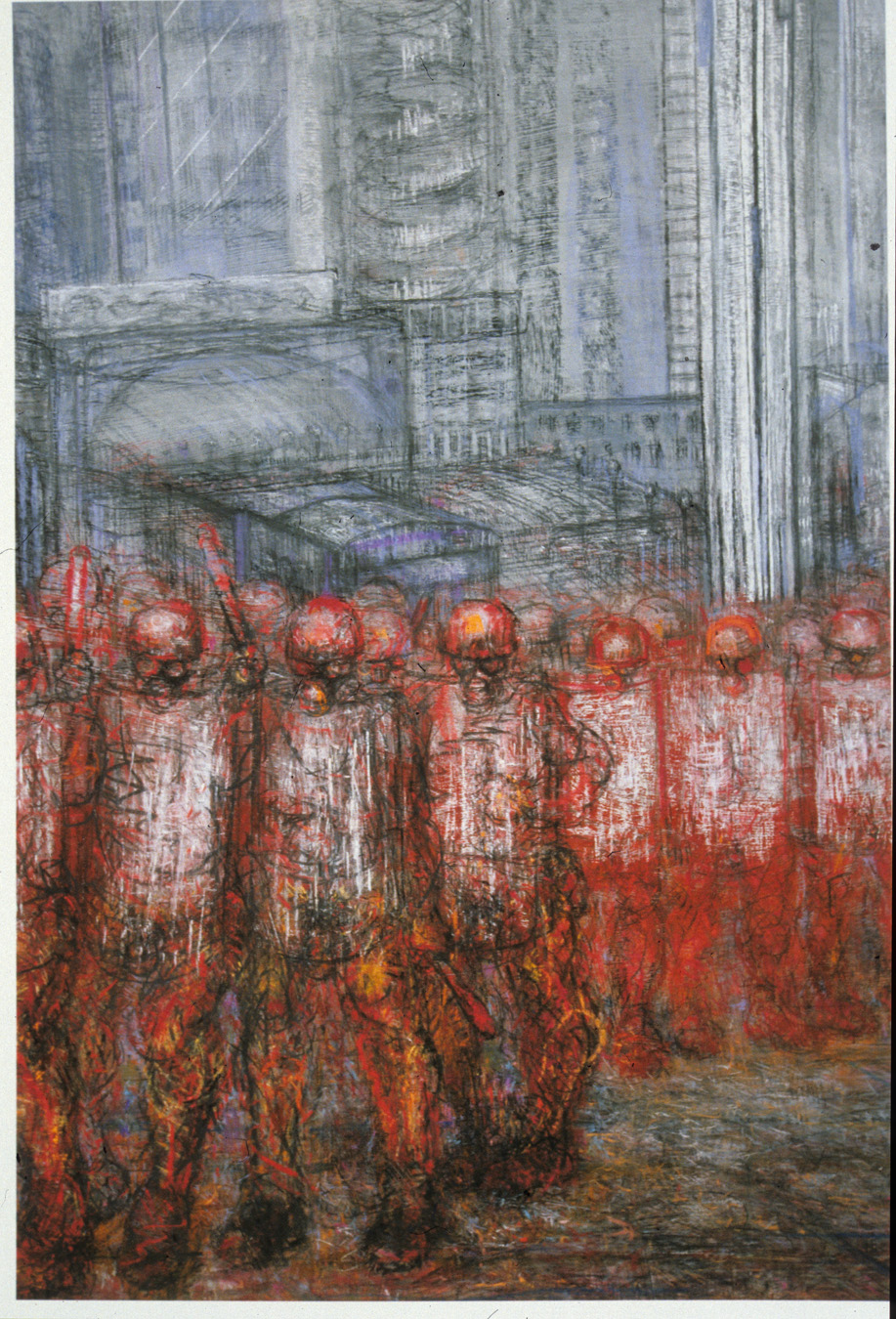
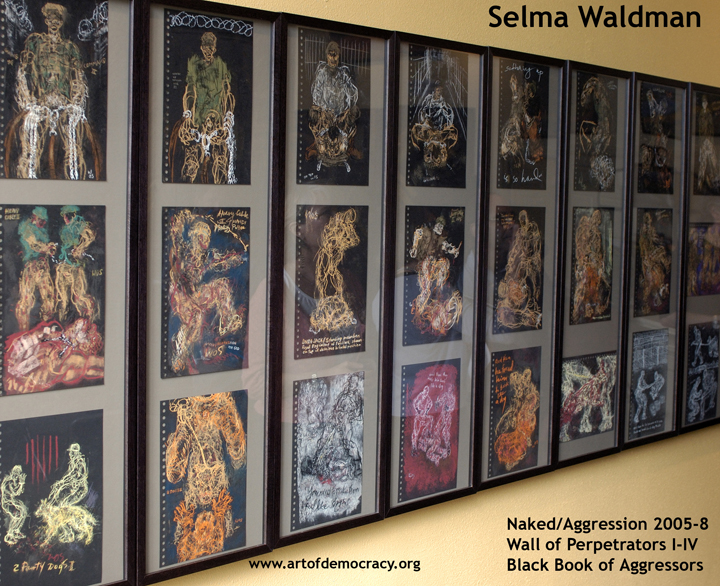
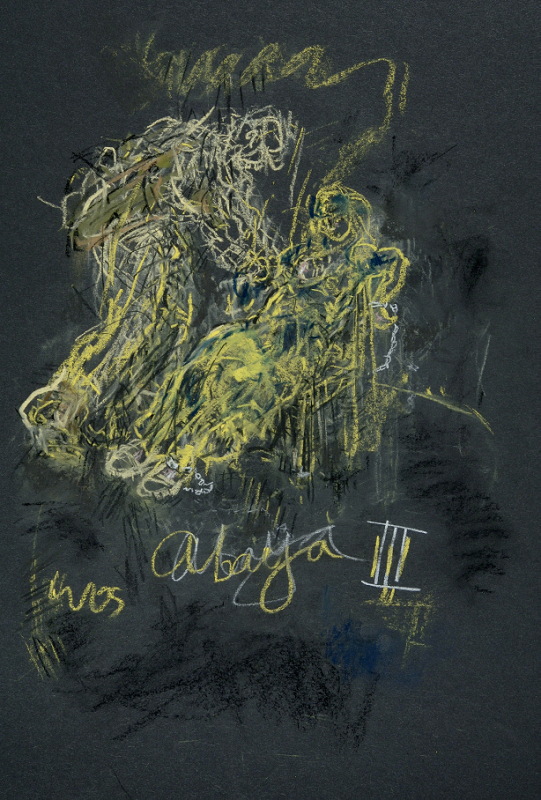
Black Book II 29 Abaya
Finally, her last series Naked /Aggression: Wall of Perpetrators IV-V, The Black Book of Aggressors (I-IV) (2005-2006) bears witness to the degradation of human beings and the systematic abuse of power in Abu Ghraib, Guantanamo, and elsewhere. Left unfinished at the time of the artist’s death in April 2008, the Black Book of Aggressors would have included two hundred drawings and eight walls. For the final wall, she planned to reconfigure Goya’s Saturn Devouring His Son (1820 – 23), The Colossus (1808-1812), and other black paintings, to address atrocities world-wide.
As she wrote
“the cycle ‘corrects’ the mythic profile of the invulnerable warrior-hero, born to fight and trained to win – and reveals it as a reckless existential lie and an obscene fraud without which battles could never be engaged- confirms it as the fool’s proof of manhood, the lifeblood for fascist, the main meat dished out to defense profiteers, and the first refuge for scoundrel fanatics.”
What could be a more timely statement given what we have just witnessed in the US capital!
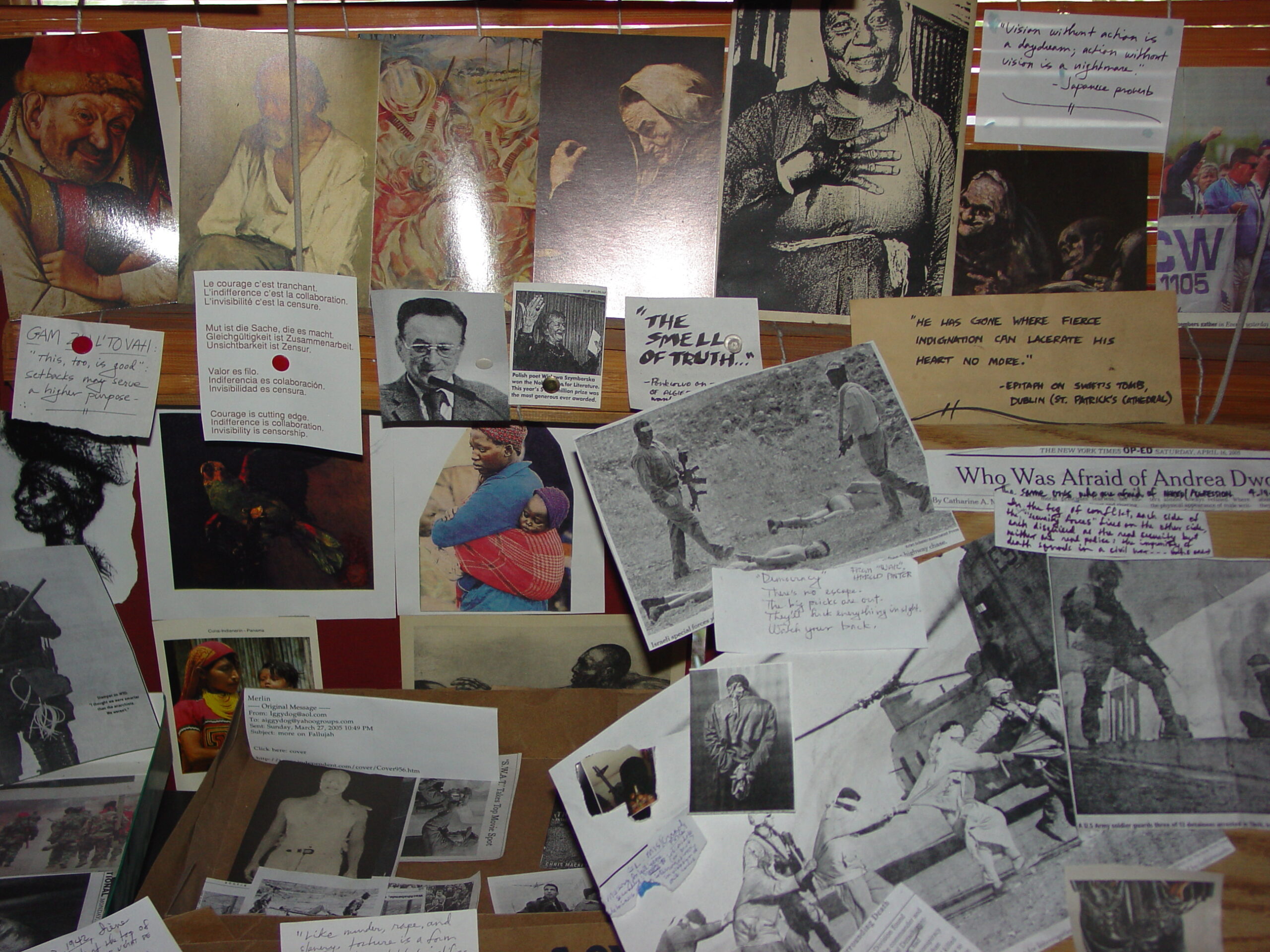
Every detail of Selma Waldman’s life carried her strong spirit of resistance and her belief that creative voices could win over forces of oppression. In her small home in Rainier Valley every wall was covered with art, texts, poems, posters, prints, photographs. There were photographs of singers, dancers, gymnasts, poets, and writers, as well as quotations, and her own writings. Every wall and most of the floor space was filled with books.
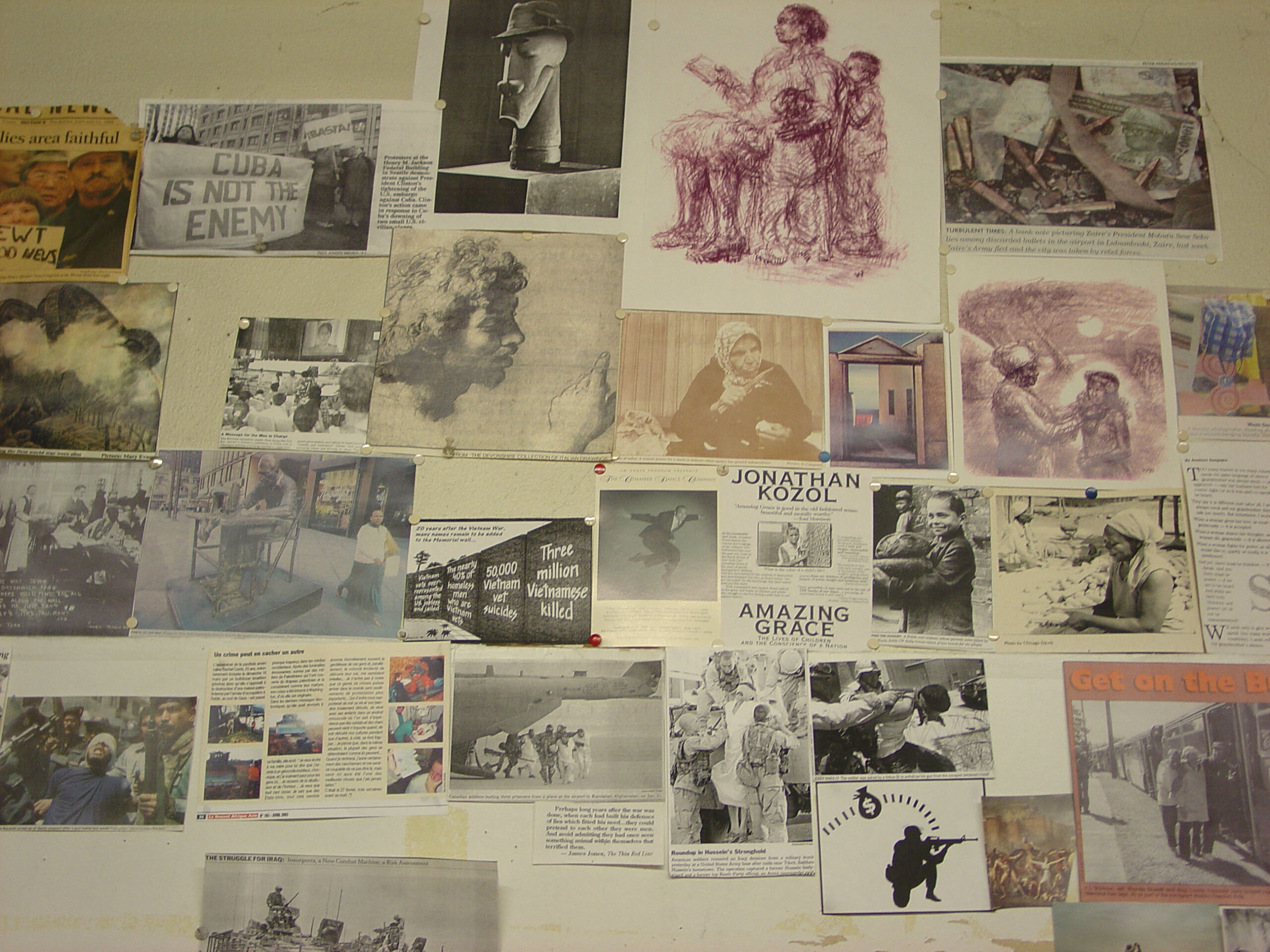
But two facts emerged clearly for me as I spent more time in her house in her last weeks. First, her witness to depravity and the abuse of power was paired with a celebration of the human spirit in all of its glorious powers of creativity and resistance. Second, Selma herself, lucid to the end, was immersed in a continuous remembrance of the holocaust itself, the initial horror that she experienced not first-hand, but deeply, at a critical time in her life.
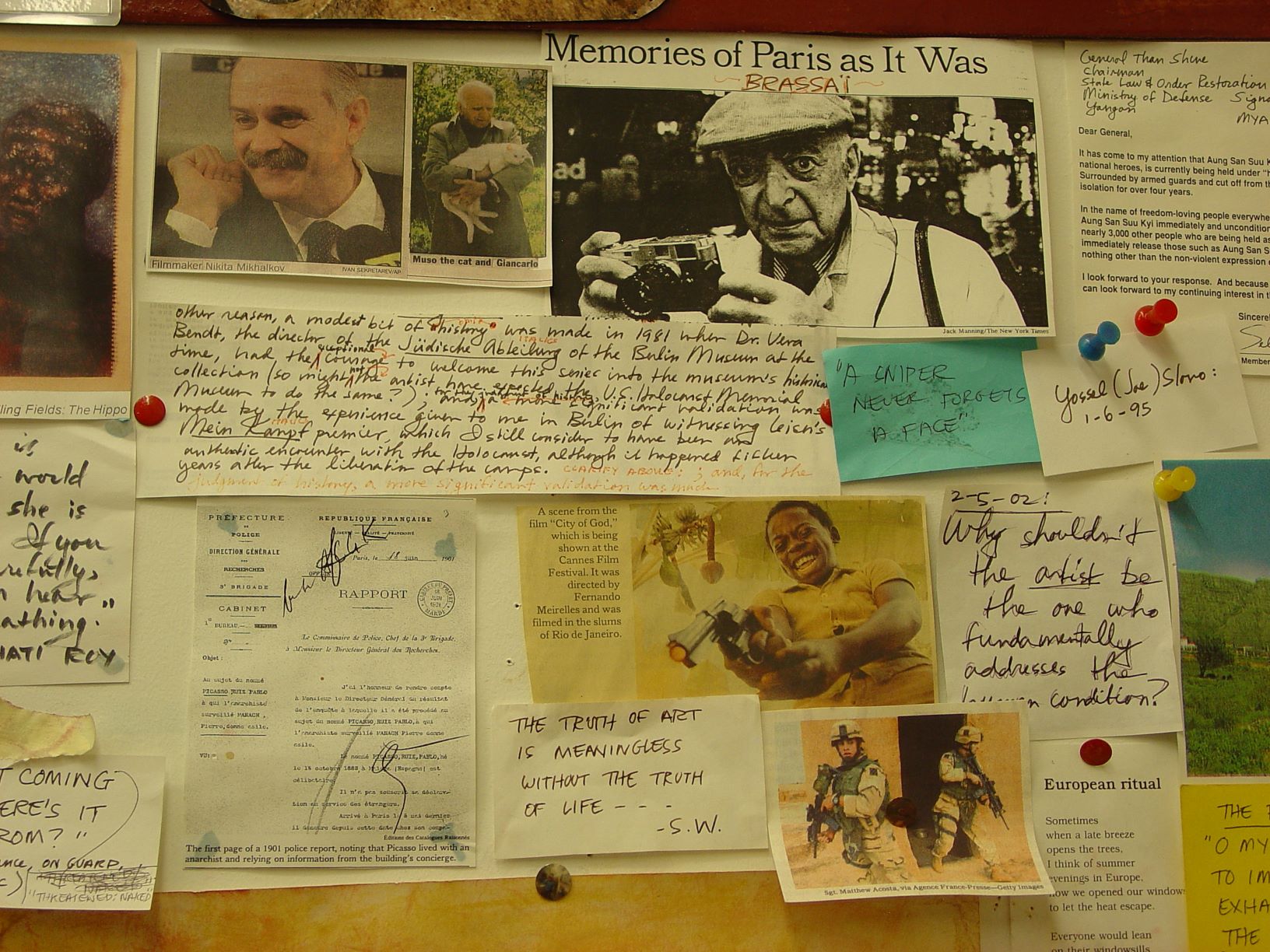
She spent her life searching for archetypes that could represent the underlying loss of humanity that leads to such abuse.
Selma Waldman would answer the question with which I began by speaking of the intersections of past and present, all seated in an obsession with power manifested as racism, fanaticism, and inhumanity.
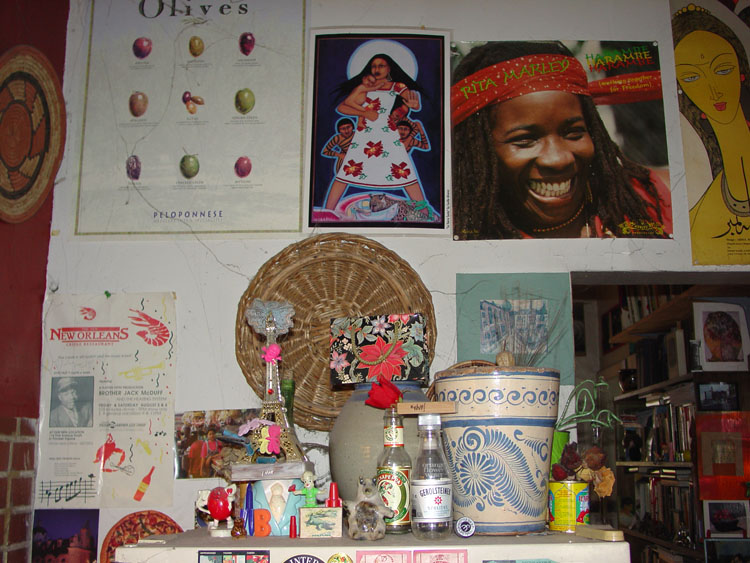
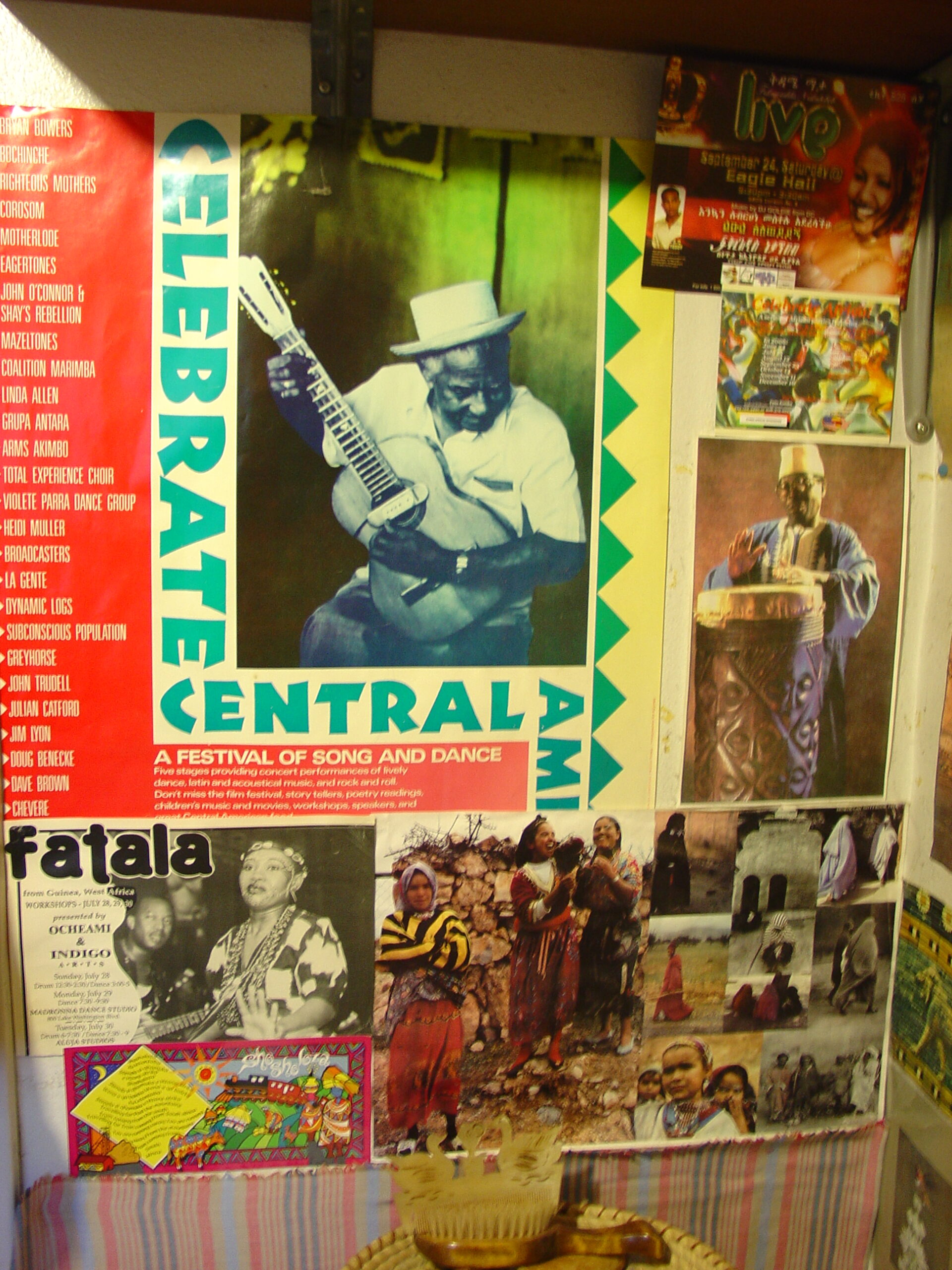
But she always paired her witness to depravity and the abuse of power with a celebration of the human spirit in all of its glorious powers of creativity and resistance.
This entry was posted on February 26, 2021 and is filed under Art and Activism, Art and Politics Now, art criticism, Contemporary Art, Uncategorized.
Iran US Collaboration: Emotional Numbness: The Impact of War on the Human Psyche and Ecosystems
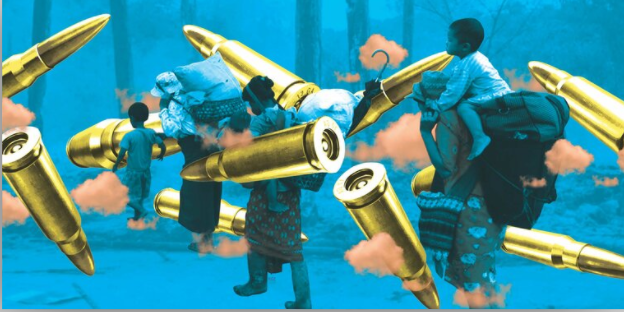
Artists Beyond Boundaries Tribution (Kachin) Myanmar
“Emotional Numbness, the Impact of War on the Human Psyche and Ecosystems”
This exhibition is in Tehran, Iran, but available to see anywhere!
It is a collaboration between US based group WEAD, Women Eco Artists Dialog and artists in Tehran, Iran.
You can see two excellent online tours of the exhibition here is a direct link to one from the WEAD website : a simulation of the gallery that enables you to stop at each work and learn about it, the second is a physical tour of PLATFORM 3 Gallery in Tehran.
Two curators one in Oakland, Minoosh Zomorodinia and one in Tehran, Atefeh Khas, collaborated on the complex logistics required to put the exhibition together. The physical exhibition is in Tehran, the WEAD artists sent their work there, and surprisingly, almost all of them made it through to the show.
“Emotional Numbness” includes over forty artists. Their work is intense, given the theme of the exhibition. They include many two dimensional prints (given the limitations of shipping to Tehran), videos, sculpture and installations.
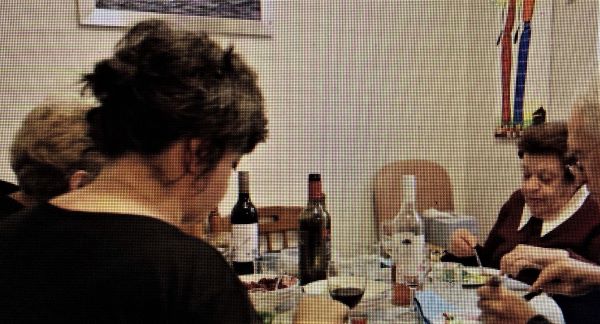
To name just a few: there is an interview with a 95 year old holocaust survivor (Kolya Grokhovsky The Future is Bright). ( the woman on the right in this video screen shot, she tells a story of how she survived barely, when many in her family did not.
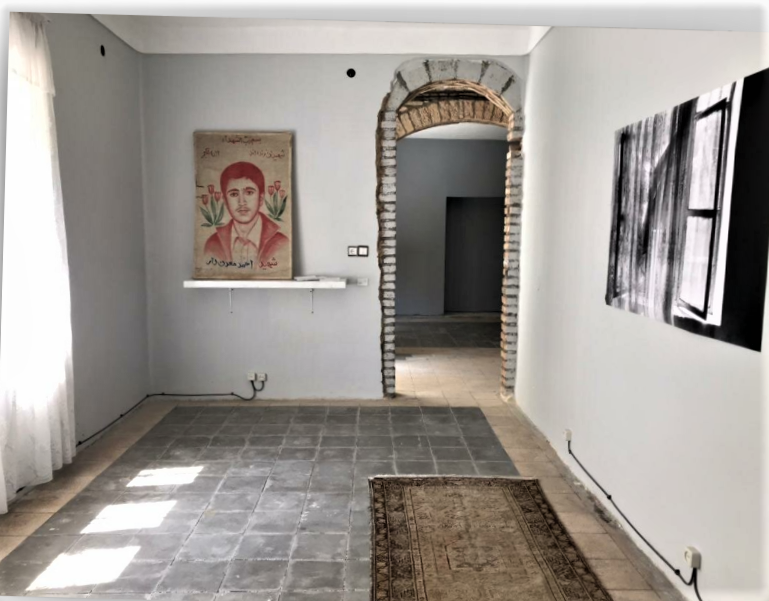
an homage to the artist’s grandmother and a young man who died in the Iran/Iraq war. (Sara Madander In Memory of Aziz). The installation shot here gives the flavor of the Tehran gallery as well as the several parts of this installation which included the carpet and a video as well as an image of a window with a lacey curtain. The video of the full installation is on the artist’s website. Aziz is the artist’s grandmother and the artist’s mother kept her mother’s home just as it had been when she died. The portrait is of the artist’s uncle Ahmed, who disappeared into the war at the age of 17, leaving without saying good-bye after being brainwashed, as the artist suggests, in school.
What we see here is a haunting segment of a recreation of her grandmother’s home.

(Artists Beyond Borders Tribution (Kachin)
Artists Beyond Borders collaborates with other artist in projects world wide that address the impact of war.
Here they present people of Myanmar displaced by war carrying gigantic bullets as they flee. This artist partnership ( Pamela Blotner and Mie Preckler) believe that art must bring more than “Awareness to the table, that if humankind is to take a part in averting war. …we need to have a collective effort”
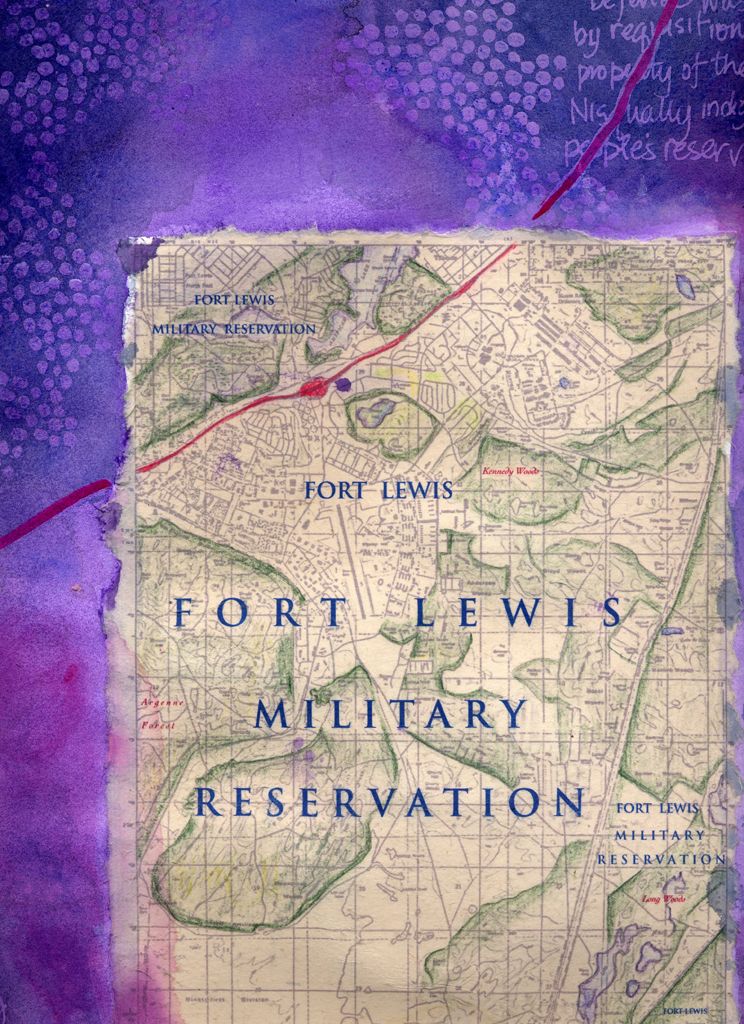

Alice Dubiel Domestic Violence/The War on Terror: Military Archeology 2 (JBLM)
Seattle-based artist Alice Dubiel addreses sexual violence on military bases Alice Dubiel Domestic Violence/The War on Terror: Military Archeology 2 (JBLM);”The US Military maintains over 800 bases world-wide . . . the text consists of geography. social context, history and description of Join Base Lewis McChord. . . reports of detailed domestic violence are particularly graphic. ”
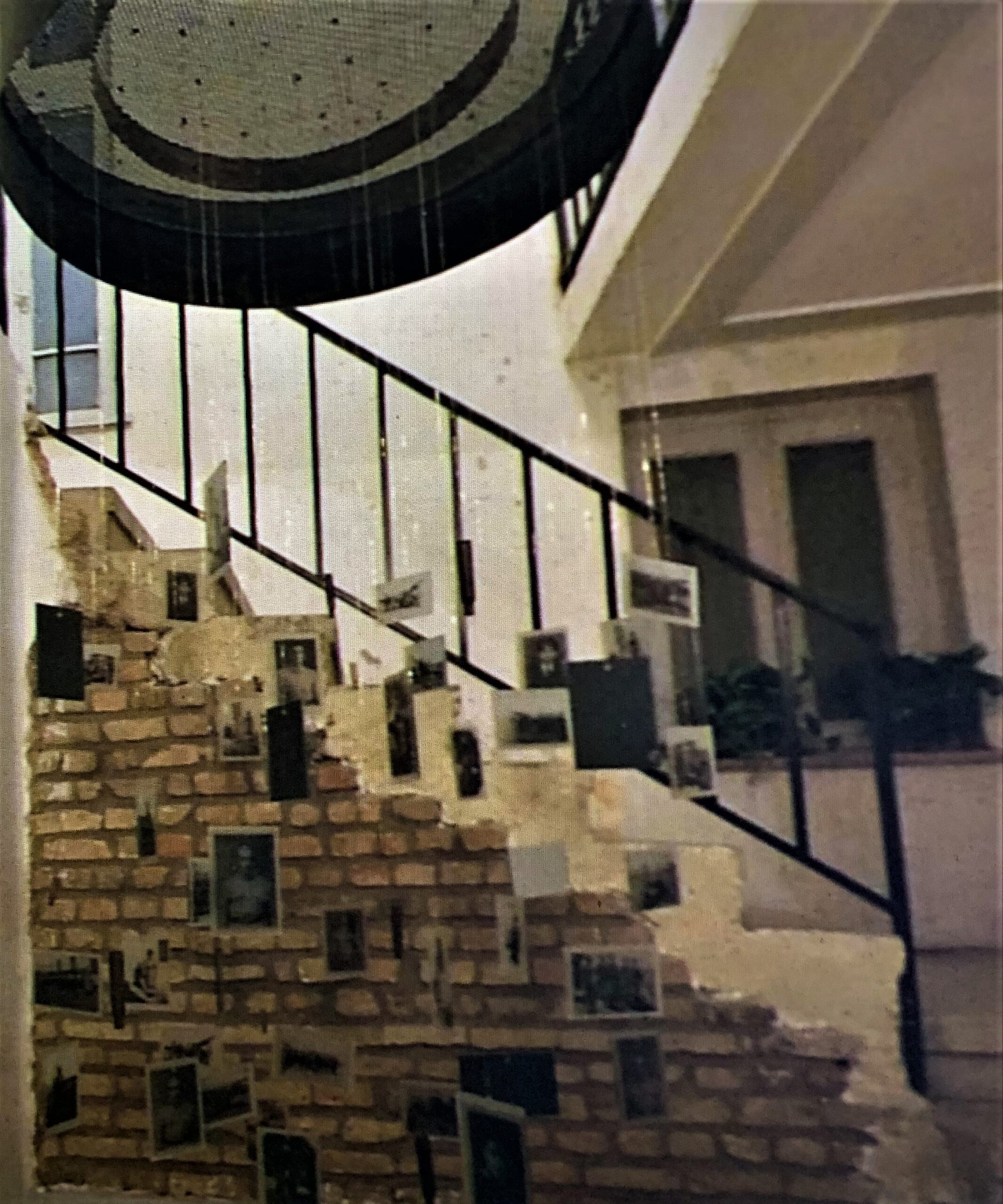
Nazli Abbaspour How many births are we given to die so repeatedly installation in Tehran
Nazli Abbaspour honors soldiers who die in wars.
In the installation video you can see a brief haunting close up of some of the photographs of soldiers taken before they go off to die.
Gazelle Samizay and Labkhand Olfatmanesh in Bepar call attention to the impact of war on children’s play, in this case hopscotch. As a young person tries to play hopscotch, the sounds of war, the impact of war, and the destruction of war surround and overwhelm her. The artists use various metaphors to suggest the violence.
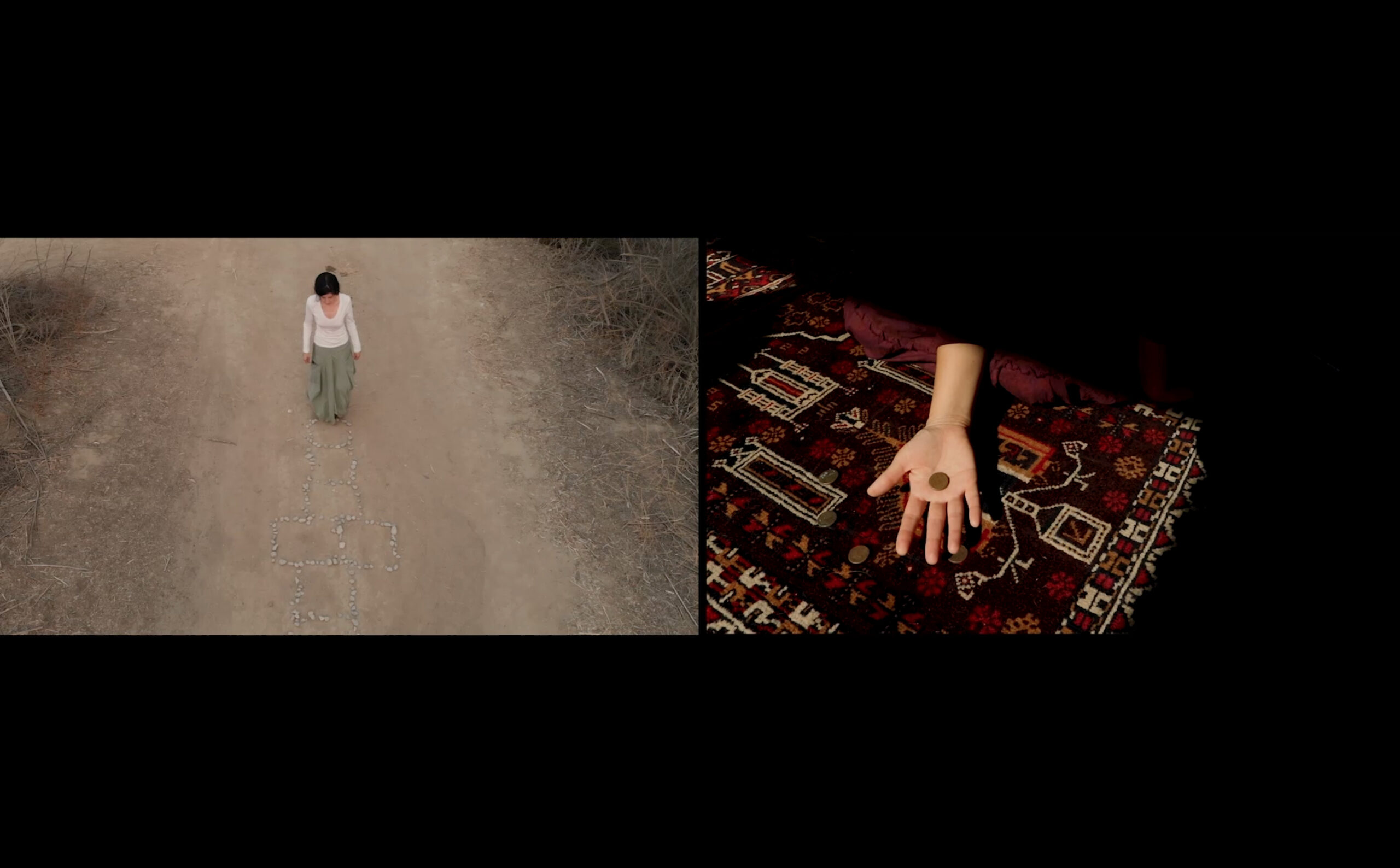
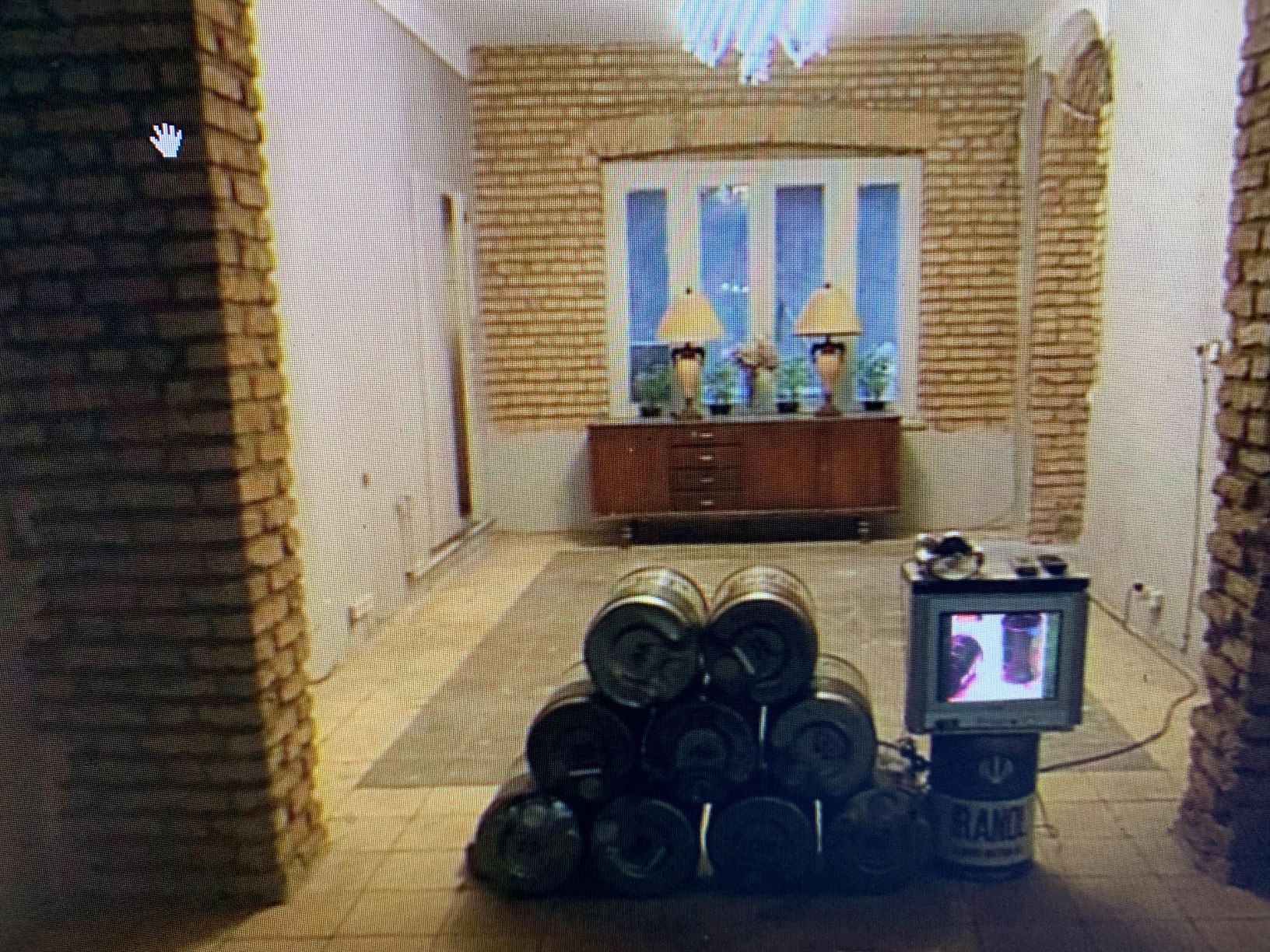
Farzaneh Najafi The War of the Oil installation view in Tehran platform 3 ( screenshot)
Farzaneh Najafi creates this compelling installation of oil drums focusing on “Oil, this black gold is the motive for seizure and plunder of many lands all over the world.” She includes emphasis on the devestation of the environment of Iran, and the related economic impacts of sanctions .
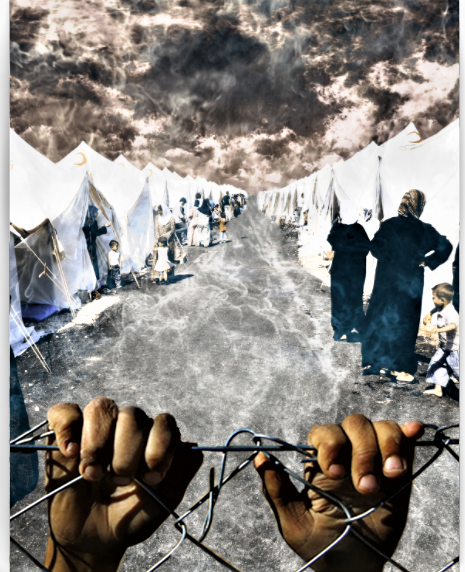
Verona Fonte Syrian Refugee Camp “Escape from Fire: The Migration Crisis of the 21 century”
Verona Fonte’s dramatic image with its hands grasping a wire fence in the foreground conveys to us the desperation of refugees. The lives of these people is hard for us to grasp in its deprivations. “the images reflect the tribulations and tragic circumstances faced by the multitudes of people displaced by war, poverty and global warming” You can see the rest of her series here. https://veronafonte.jimdofree.com/portfolio/fine-art-digital-prints/
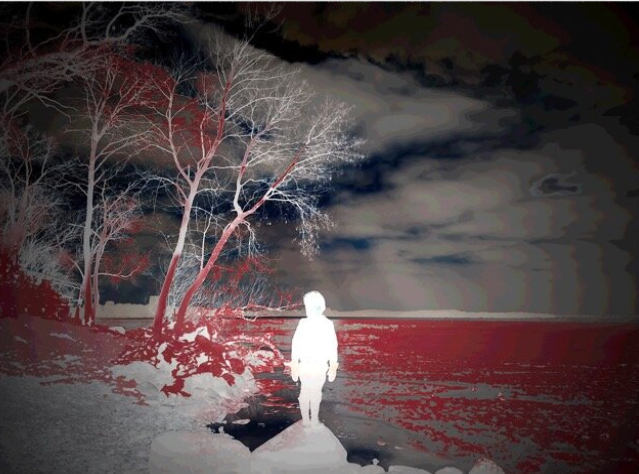
Jeanne Wilkinson Bloodlake 2
Wilkinson speaks forcefully to many of the issues in the show:
I depict a world filled with blood, lit by a sun that has become a source of darkness rather than light . . . a benumbed child stands on rocks that have become cold and sterile under his feet, his world no longer one of sustenance and color, but depleted and drained. This is how I see the earth and our place in it as wars, weapons, pollution and the greed that drives all these forces to grow and proliferate. It’s as if we are filling the earth with our blood while draining our own existence of life and light.”
There are many more incredible works in the show. The range of aesthetic approaches united by this powerful theme tells us the universality of the theme and the nightmare we are in today as Congress passes another 740 billion dollar defense bill that is beyond our understanding in its colossal size. The 908 billion stimulus bill for the current COVID catastrophe is a little larger, but in limbo. Wouldn’t it be exciting of the defense bill monies went to correcting the environmental catastrophes caused by war and specifically the US military.
And as I write the escalation of rhetoric about Iran and military “preparedness” in the Gulf, is also horrifying.
As our public media demonizes Iran, the dialog between these Iranian and American artists on the healing power of art is inspiring. I cannot recall another exhibition that brings together war, the military and violence against both women and the planet.
This entry was posted on December 27, 2020 and is filed under Art and Activism, Art and Ecology, Art and Politics Now, Art in War, ecology, Feminism, Uncategorized.
Cruisin’ the Fossil Coastline at the Burke ( not yet open) and the River of Life
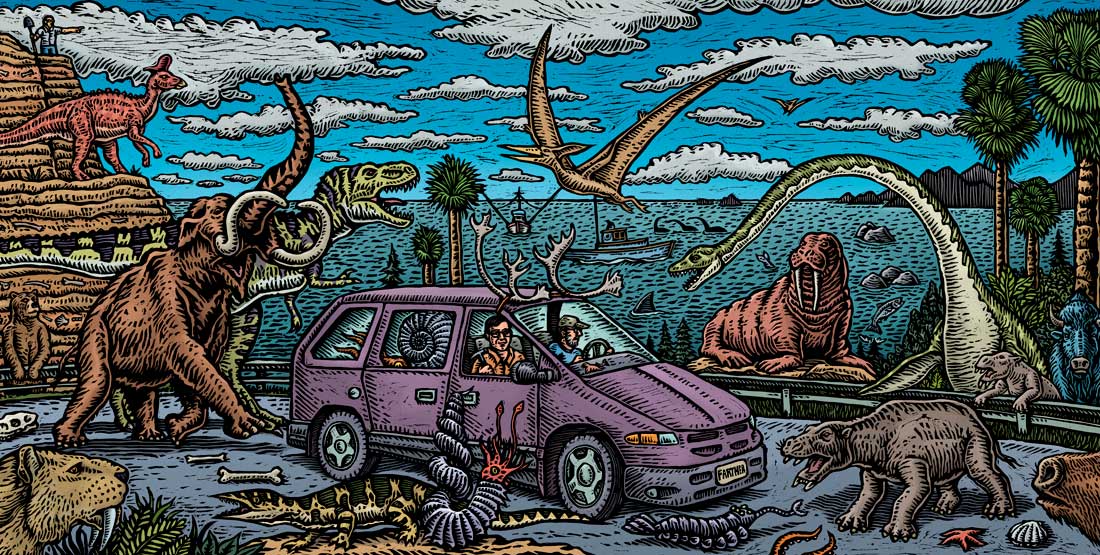
Not yet open at the Burke is Ray Troll’s Cruisin’ the Fossil Coastline exhibition. More about the show in a minute, but meanwhile, I want to give a big hooray to the Paleo Nerd podcast that Ray and his friend David Strassman, a ventriloquest, host. Here is Ray’s own website also.

The podcast is a ton of fun, but also full of a huge amount of information. In fact, I haven’t thought about fossils for awhile – my sister in law lives on the Jurassic Coast in England and works at the local fossil museum, so I have a few ammonites including a stunning necklace.
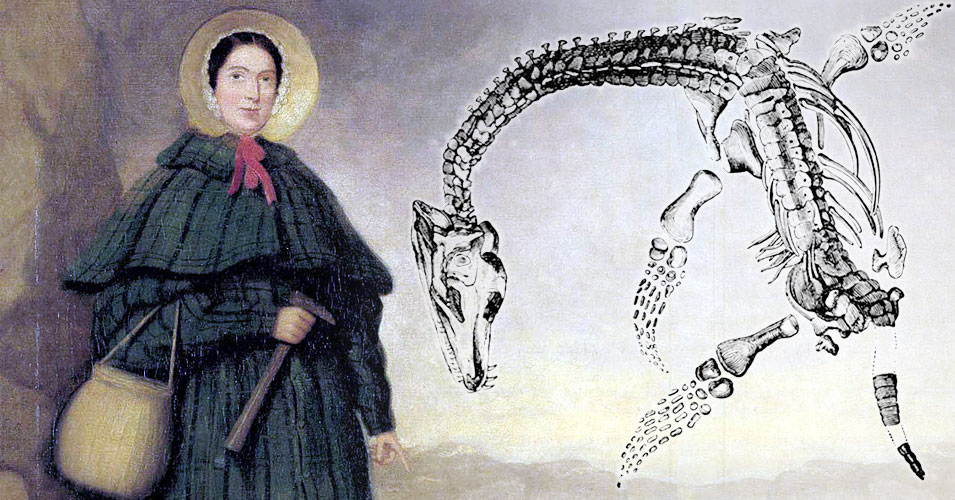
Here is their local celebrity: “Mary Anning (21 May 1799 – 9 March 1847) was an English fossil collector, dealer, and palaeontologist who became known around the world for finds she made in Jurassic marine fossil beds in the cliffs along the English Channel at Lyme Regis ”
So it is a pleasure to think again about fossils.
From the first minutes of this podcast you start to expand your mind, even as you laugh along with them. It is done in a creative way with insertions of weird voices and sounds that interrupt any long windedness that might make our attention wander.
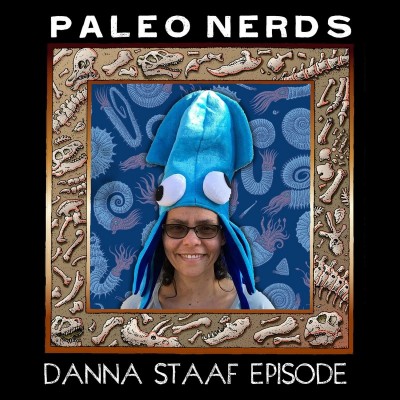
They got my attention when I started listening accidentally at Episode 14, The Flight of the Cephalopods with Danna Staaf
I had no idea that the chambered nautilus was in the same “class” as octopus and squid. Listen to it for more great information!
Then I went back to the first one, which gave some background on how these two became paleo nerds in the first place. What I really like is that they are both incredibly knowledgeable and humble and funny at the same time.
So here is a tidbit to get you started thinking from the first episode. If you want to remember the order of things in the animal kingdom here is a trick from Ray
“King Phillip Can Only Fake Good Sex or
Dumb King Phillip Clearly Only Fears Green Snakes
for
Domain, Kingdom, Phylum, Class, Order, Family, Genus, Species
Paleo Nerds, the podcast talks a lot about geologic time, infinite amounts of time, they stretch our brains and make us realize what a short time we humans have been here in the full scale of time.
As I thought about that, I started re-reading my father’s wonderful 1956 book River of Life. He was a self taught naturalist who wanted to share his wonder at the magic of life, a lot like Ray Troll and his friends want to share the wonder of fossils. The famous artist Bernarda Bryson Shahn illustrated The River of Life. My father focused on how the world has come to look the way it does today ( or as it looked in 1956 when he wrote the book, as much has gone extinct since then)
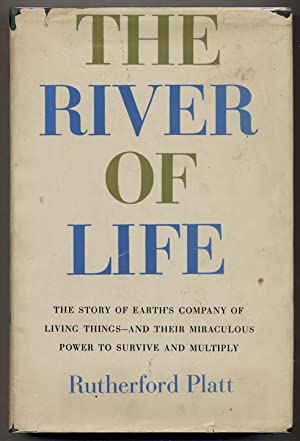
“The story of earth’s company of living things – and their miraculous power to survive and multiply”
He wrote
“life began on earth when a few elements ( principally carbon, oxygen, and hydrogen), cooked by sunlight in warm water gelled to form a peculiar chemical we call protoplasm. ”
“All the teeming world we know is concentrated in a veneer of air, earth, and sea only as thin in proportion to the earth as the coating of wax on the skin of an apple. ”
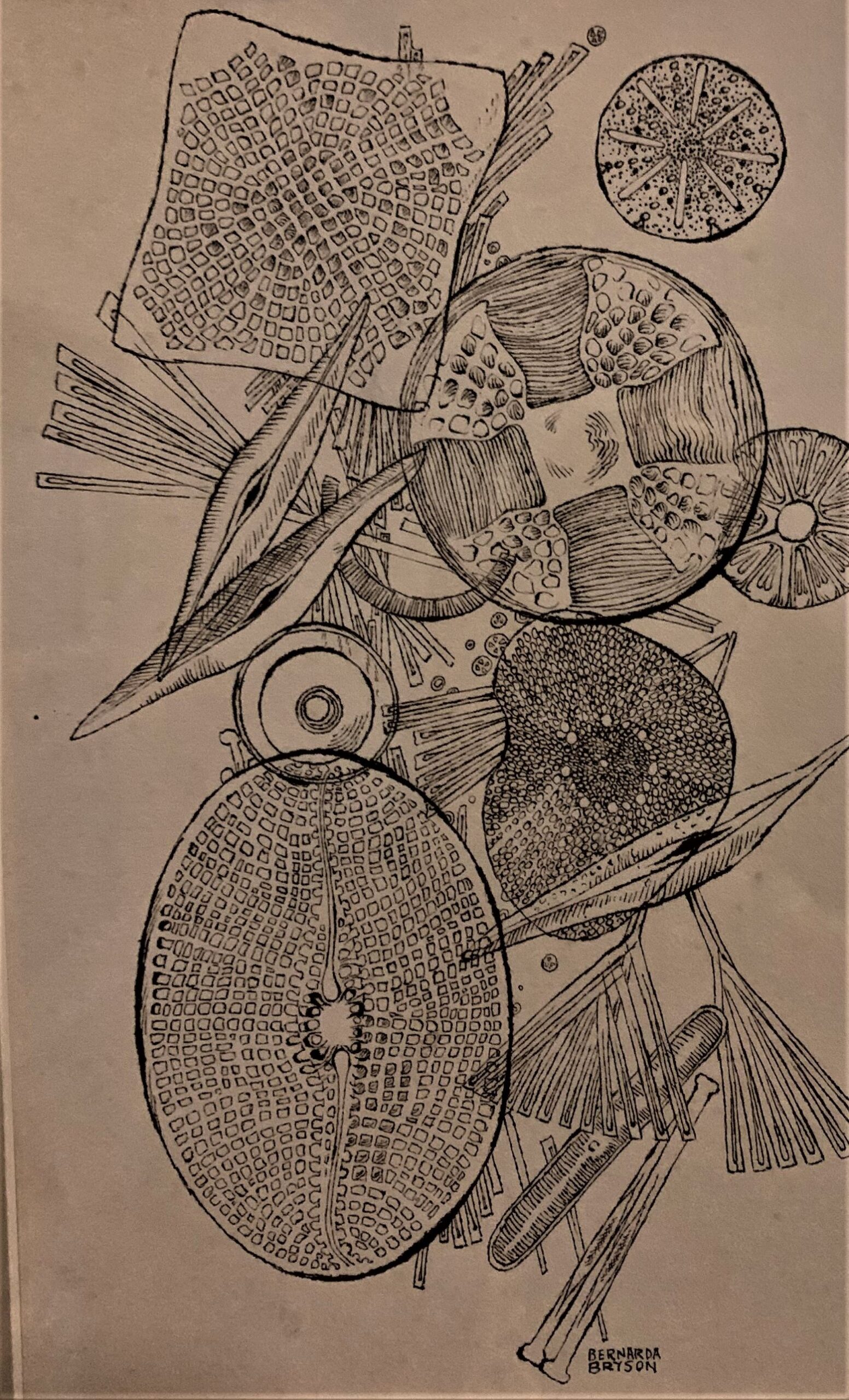
drawing of a diatom by Bernarda Bryson Shahn “ocean plants that make glass boxes, filigreed with geometric designs to live in.”
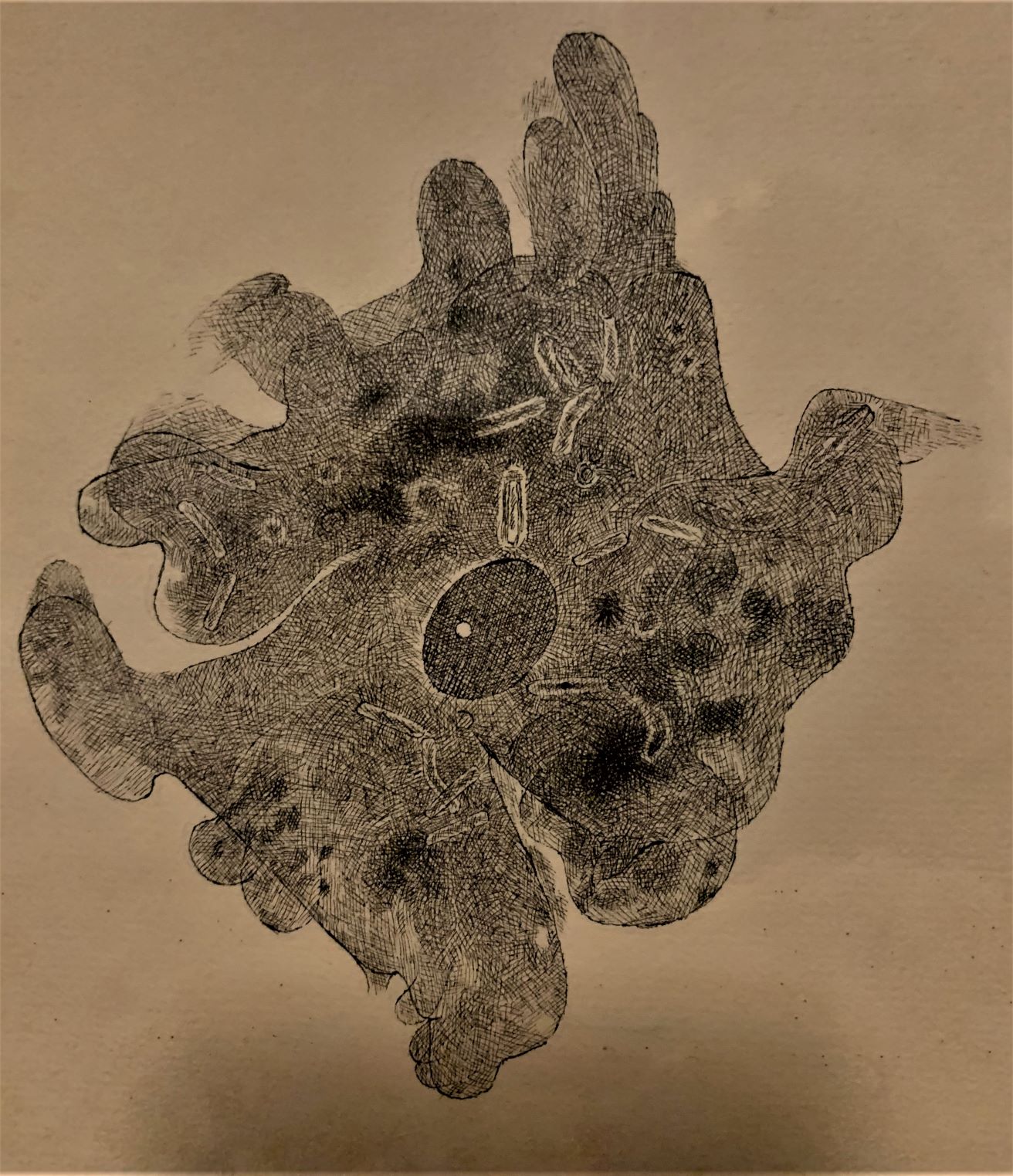
The amoeba by Bernarda Bryson Shahn “an elemental blob that carries on all the basic life activities of higher animals”
Then he celebrates the diversity of life:
“there is perhaps nothing else exactly like earth’s bizarre living cargo in all the universe.. It is unique because it has been shaped, sized, and equipped to fit into the depths of the sea, the heights of the mountains, beaches and jungles, caves and treetops, and all the varieties and soils that exist on earth. These living places have been hammered out in the anvils of endless violence, of winds, and rains, volcanic explosions, fire, glaciers, baking drought, bending rocks, floods of lava and the pushing up and pressing down of land and seas.
We find ourselves in the midst of bees and dytiscuses, earthworms, ants, hummingbirds, kangaroos, cats, dogs, lamelli-corns (scarab beetles), eagles, sea arrows and porpoises, spiders that spin miles of silk out of tiny bodies, rabbits that scare off pursuers by bobbing white cotton balls, blue-behinded apes, elephants- and giraffes that are obviously absurd.
These fellow inhabitants of our earth, living in the same age that we live in and try so hard to own, are our traveling companions on an incredible journey. we all cling to the same ball as we go spinning and rushing through space. … there are so many of us that we are unable even to arrive at final limits for the groups of bacteria, insects, fishes, starfishes, shellfish, reptiles and mammals that suckle their young.
For example no place as ever been found for the animated little powerhouses called viruses.”
I don’t know if this is current science. But we are certainly all thinking about viruses right now! So calling them “animated little powerhouses” certainly works. Take a look at a recent New Yorker article that starts with the single cell amoebus and goes quickly on to how viruses operate
So fossils, in this context, become a record of the mind boggling changes on our planet that predate the planet my father celebrates by millions and millions of years. According to this chart the earth was formed 4.6 billion years ago.
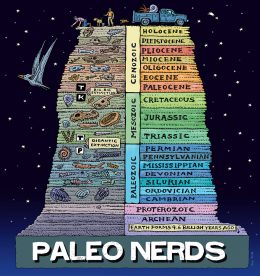
Once you start thinking in geologic time, your day to day life changes to a tiny, irrelevant blip. I find that idea particularly helpful right now. I think we are all living in a moment of existential change on the planet, so looking at geologic time can remind us that everything changes all the time, (but it is certainly changing faster and faster)
So back to the show at the Burke 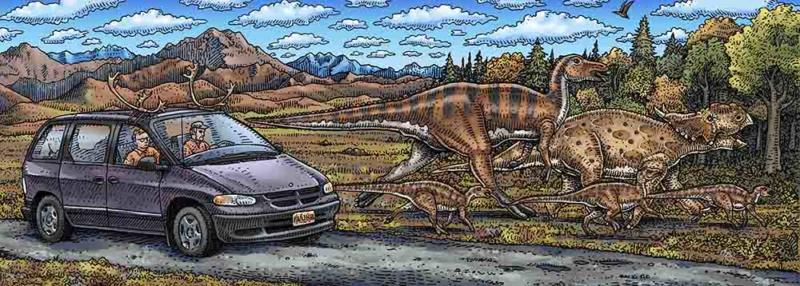
Fossils are a record
of extinct species that have survived in buried layers of sediment and rock.
What the paleo nerds often talk about, is where they went to find fossils, in a formation of particular geologic eras.
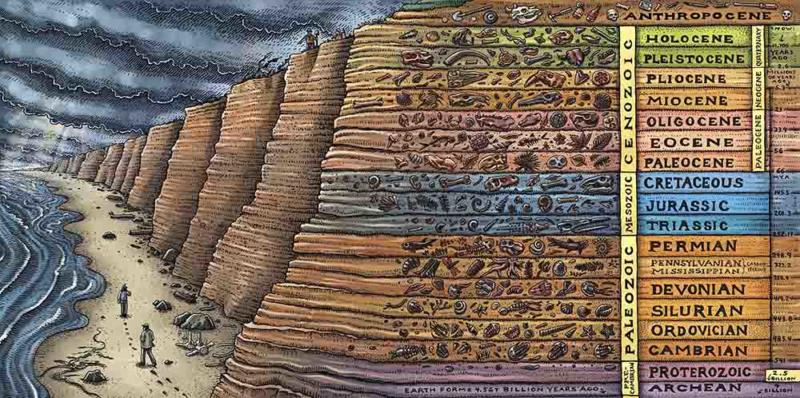
What Ray does is imagine what they looked like.

Troodon pack in the Polar Night
Ray Troll has been drawing fossils since he was four years old, based on a plastic dinosaur set his parents gave him. We know that most children go through a “dinosaur phase,” but Ray never came out of it! He says “My mantra in this whole thing — in fact we’ve even written songs about it — is that paleonerds should be proud of the fact that they are grown men who still love dinosaurs.” So by the way he is also a musician.
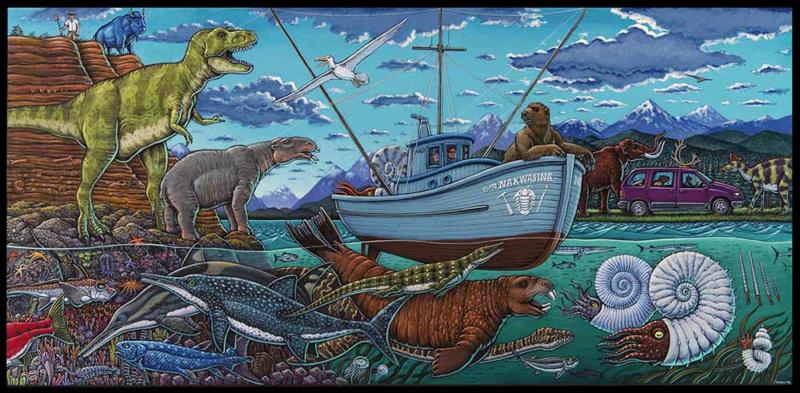
Troll’s detailed paintings and drawings are both scientific and fanciful, they have been called scientific surrealism. They have titles like Suciasaurus-Bloat-and-Float Deep Fried Rhino and Down at the Sockeye Hole One Million Years Ago, ( I believe each refers to how the fossils were deposited, sediment, water, volcano)
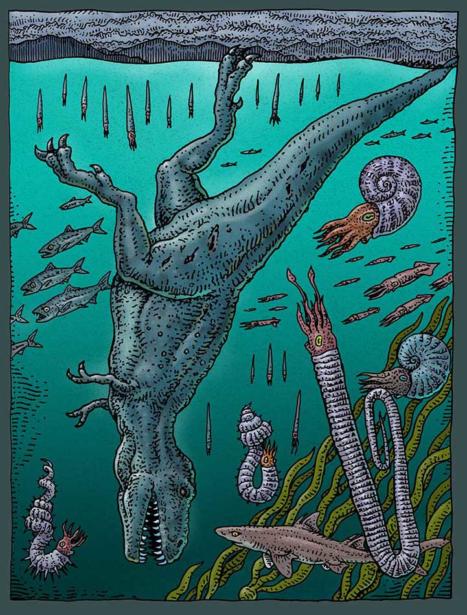
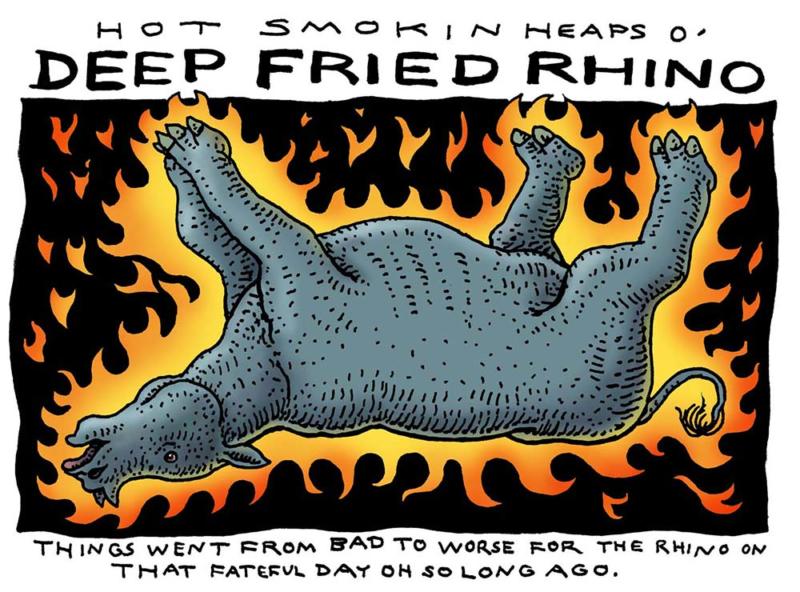
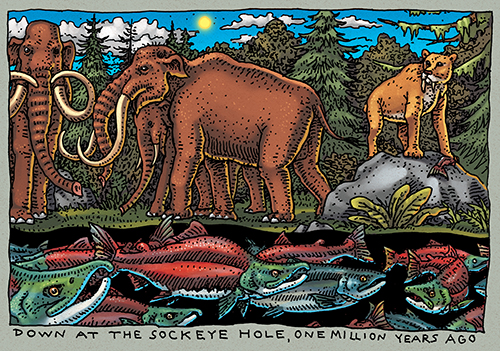
Troll has worked for years with paleontologist Kirk Johnson, now director of the Smithsonian National Museum of Natural History. They drove thousands of miles searching for fossils along the coast of North America. They previously documented the adjacent fourteen states in Cruisin’ the Fossil Freeway.
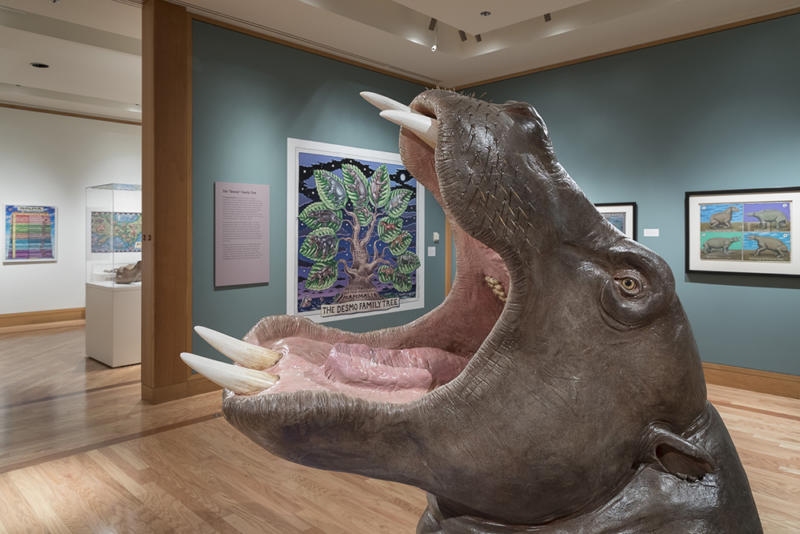
Dary Staab Desmostylian sculpture copyright Jim Kohl Photograph Anchorage Museum
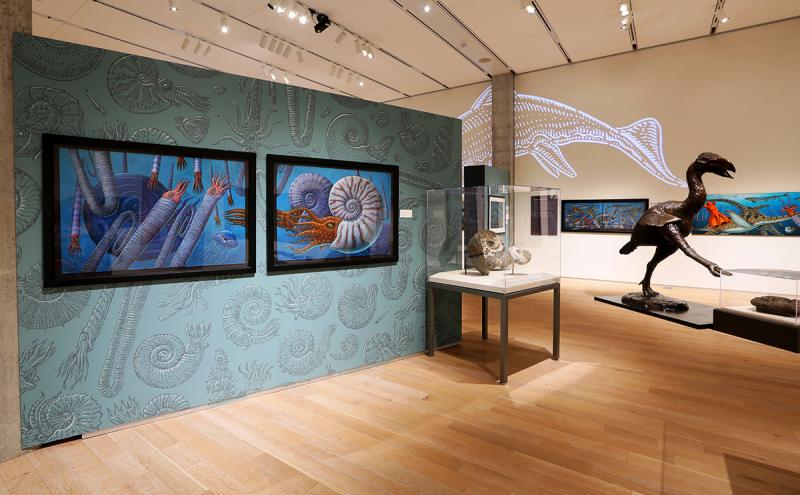
The Alaska State Museum installation in Juneau Photo by Brian Wallace
The exhibition ( these photos are from a previous venue) includes many of Ray’s detailed paintings, as well as life size models of dinosaurs, and a light and audio installation. There are mammouth teeth found near Seattle. and a cast of the lower jaw of the Blue Lake Rhino, an Ice Age rhino found in Coulee City Washington. Fossils of flowers, plants, and whales come from the Burke’s own collection and finally we will see “Suciasaurus rex”—Washington’s first and only dinosaur fossil.
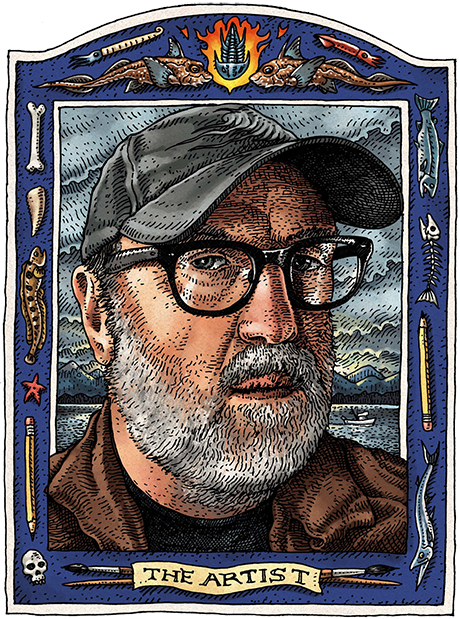
Troll never seems to take himself too seriously, but he in partnership with Kirk Johnson in this exhibition, achieves something impressive: interesting everyone in science and art at the same time.
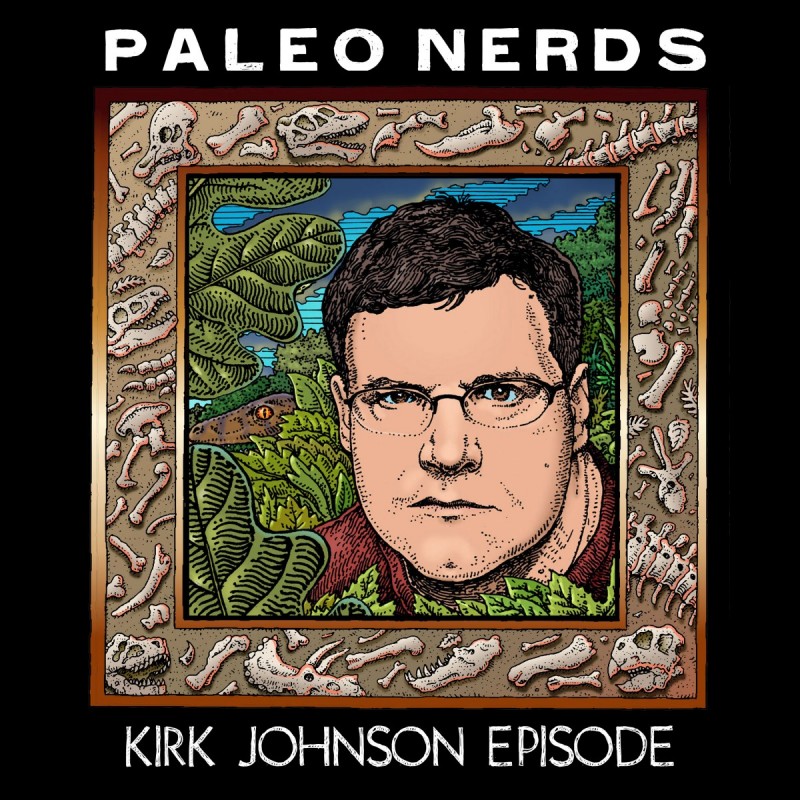
One more note on the theme of getting people to believe in science, a huge problem at this moment.
At the end of no 2 with Kirk Johnson that covers a lot of ground about all sorts of topics including the meteor that wiped out the dinosaurs, Kirk is asked why people don’t believe in facts and science. He answers that it is not just science’s failure to communicate in a way people can understand, it is also tribalism, people belonging to a group that doesn’t believe and that is much harder to penetrate. He made a movie called Polar Extremes to move the conversation forward.
On the other hand, he himself has his roots in a fundamentalist religion, Seventh Day Adventism! How could he become a world famous paleontologist Ray asked him. The answer was fascinating:
his church didn’t believe in evolution but they talked about it all the time! So as a child the word and concept became more familiar to him than his friends, none of whom had any contact with the idea since it wasn’t taught in schools.
Paleo Nerds is perfect for listening in the early morning if you wake up to early. I am learning huge amounts and all the visitors are brilliant and entertaining.
This entry was posted on December 22, 2020 and is filed under Art and Ecology, ecology, Uncategorized.
Marela Zacarias at Mad Art brings us the Temple of the Feathered Serpent in Xochicalco
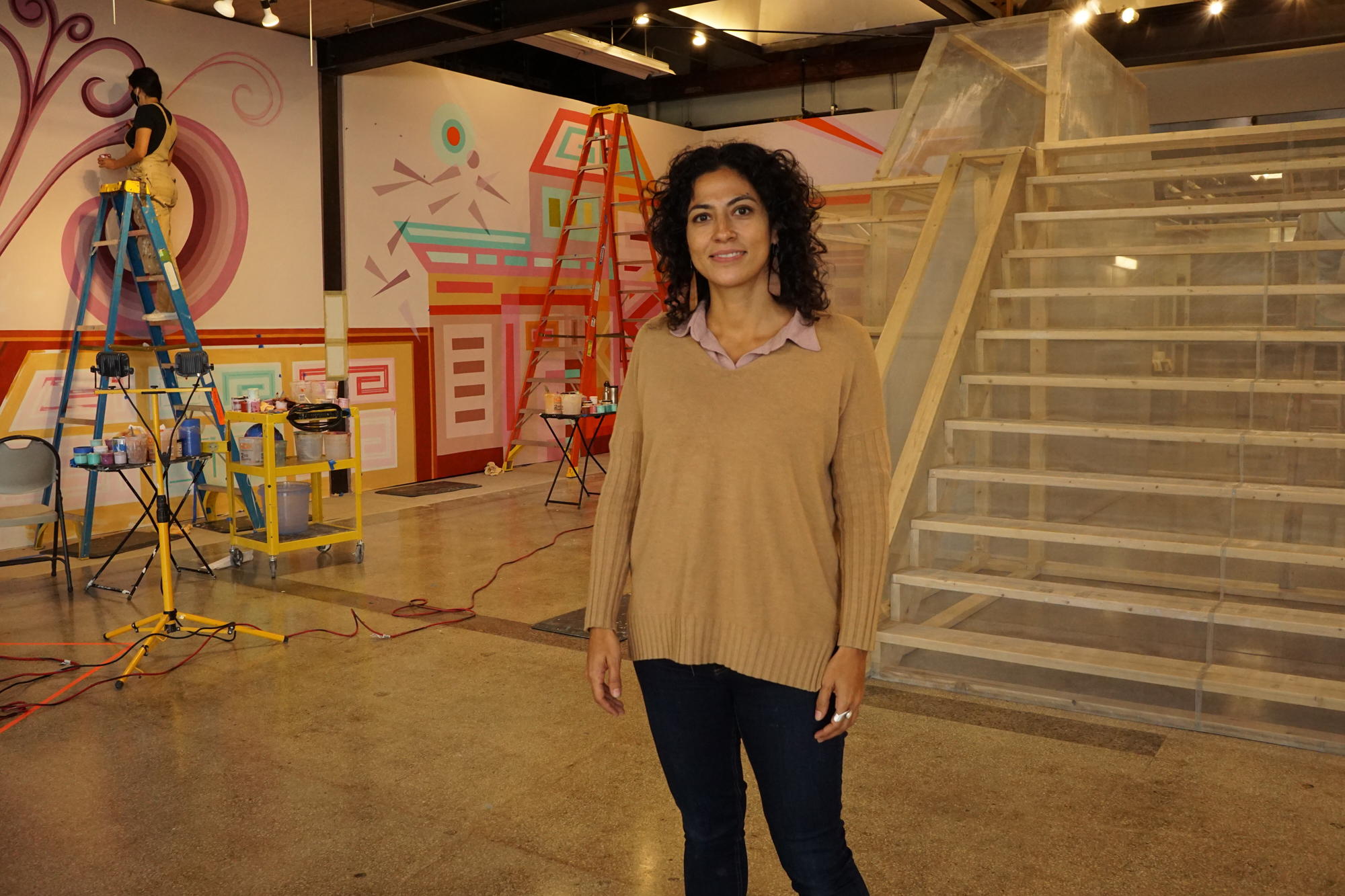
Marela Zacarías working on the installation Photo by Agueda Pacheco Flores/Crosscut
In case you are yearning for a trip to get away from our crazy election or now to celebrate it, go to Mad Art (325 Westlake Avenue N, open Thurs, Fri, Sat noon to 5 and by appointment necessary)
Marela Zacarías brings us the Temple of the Feathered Serpent in Xochicalco, a Mesoamerican site near where the artist grew up in Cuernavaca, Mexico. Made out of screening, it is an accurate but scaled down version of the pyramid.
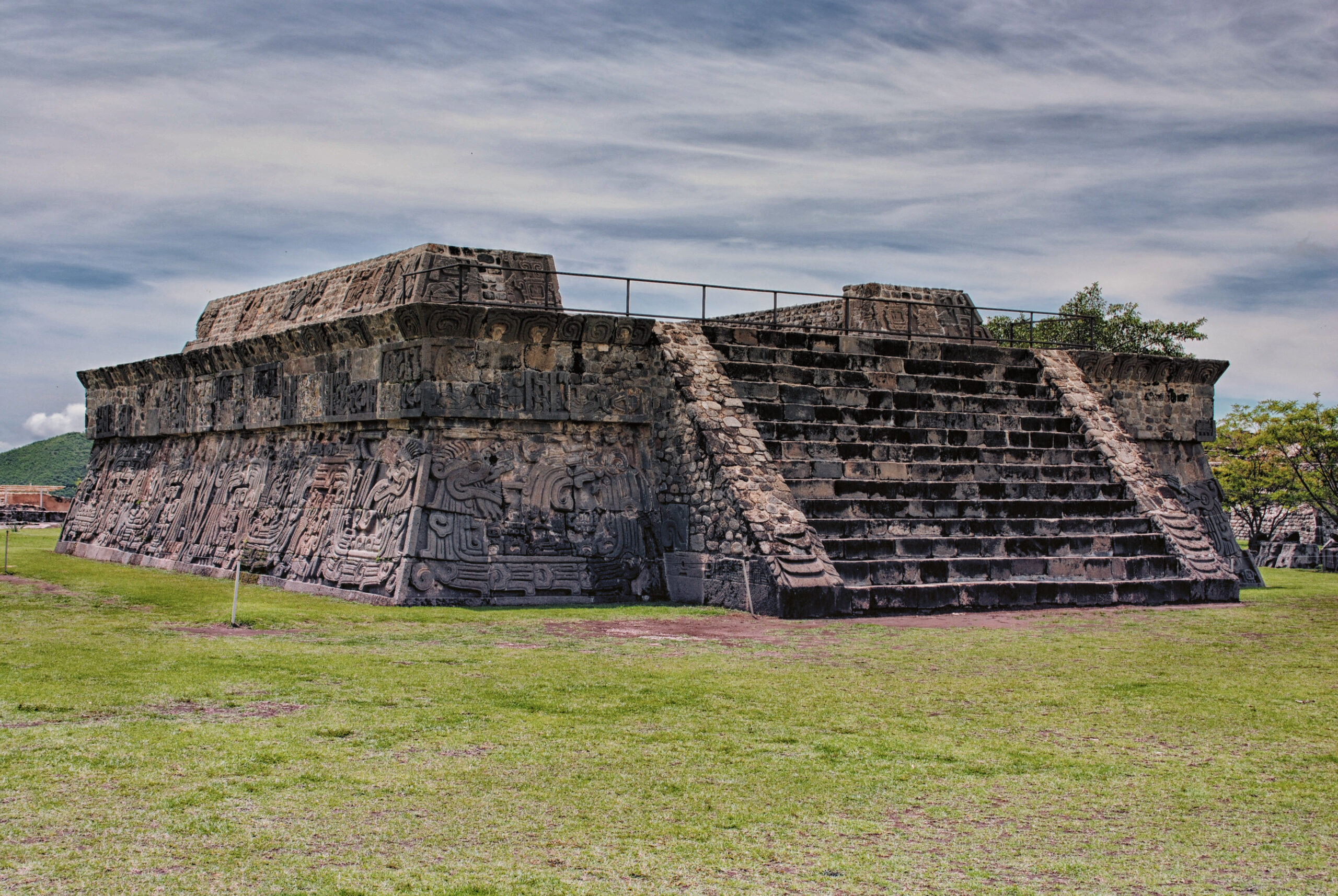
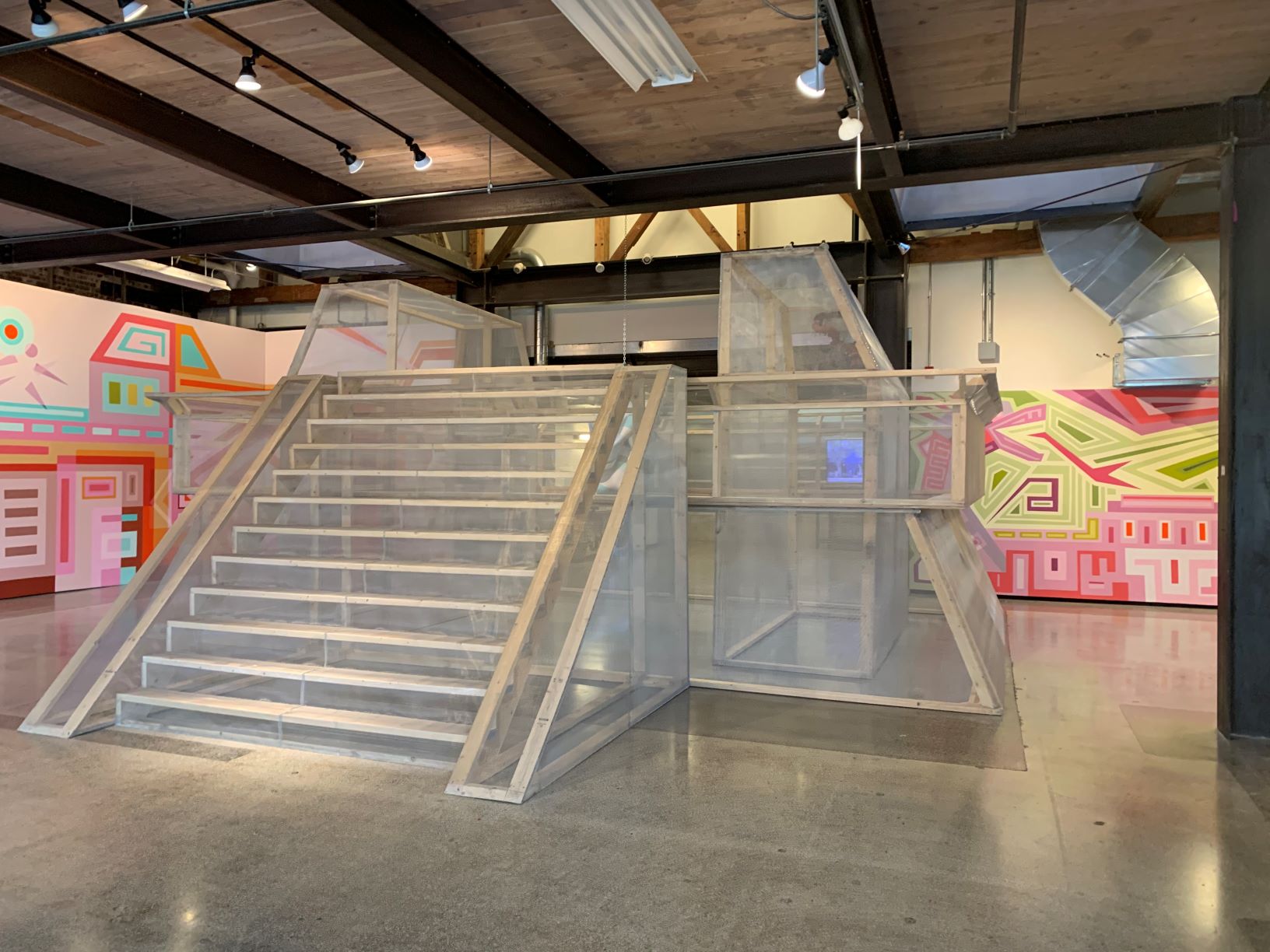
12 feet high and 22 feet by 25 feet at it widest
We see the building blocks of Mexican pyramids in the unusual shapes to the right of the stairs. Inside Out is the title of the exhibition, suggesting both the idea that she usually builds her sculpture from wire mesh and, to me, the feeling of the transparency of the pyramid as well as our current world which is being turned inside out.
Marela Zacarías was in Seattle working on a public art work for the new airport terminal. She then spent 8 weeks in a residency at Mad Art, ” a catalyst for new and unexpected artworks in Seattle”
Marela grew up going to archeological sites with her mother, an anthropologist, so the Mesoamerican sites are deeply embedded in her cultural identity.
According to Cross Cut author Agueda Pacheco Flores, Xochicalco is
“one of the only places where Aztec and Mayan shamans and leaders came together, perhaps to study the stars and determine the calendar. Aesthetic elements found on the site reflect art from both cultures, suggesting the two empires built the temple together before their eventual collapse.”
The artist sees a parallel between the collapsing of the Maya and Aztec empires and our current world.

Before we look at what the artist has put at the center of the interior, let us make a tour of the murals on the walls around it. These are guaranteed to lift your spirits as you immerse yourselves in their stunning subtle purples, reds, pinks, aquas, reds, oranges and yellows.
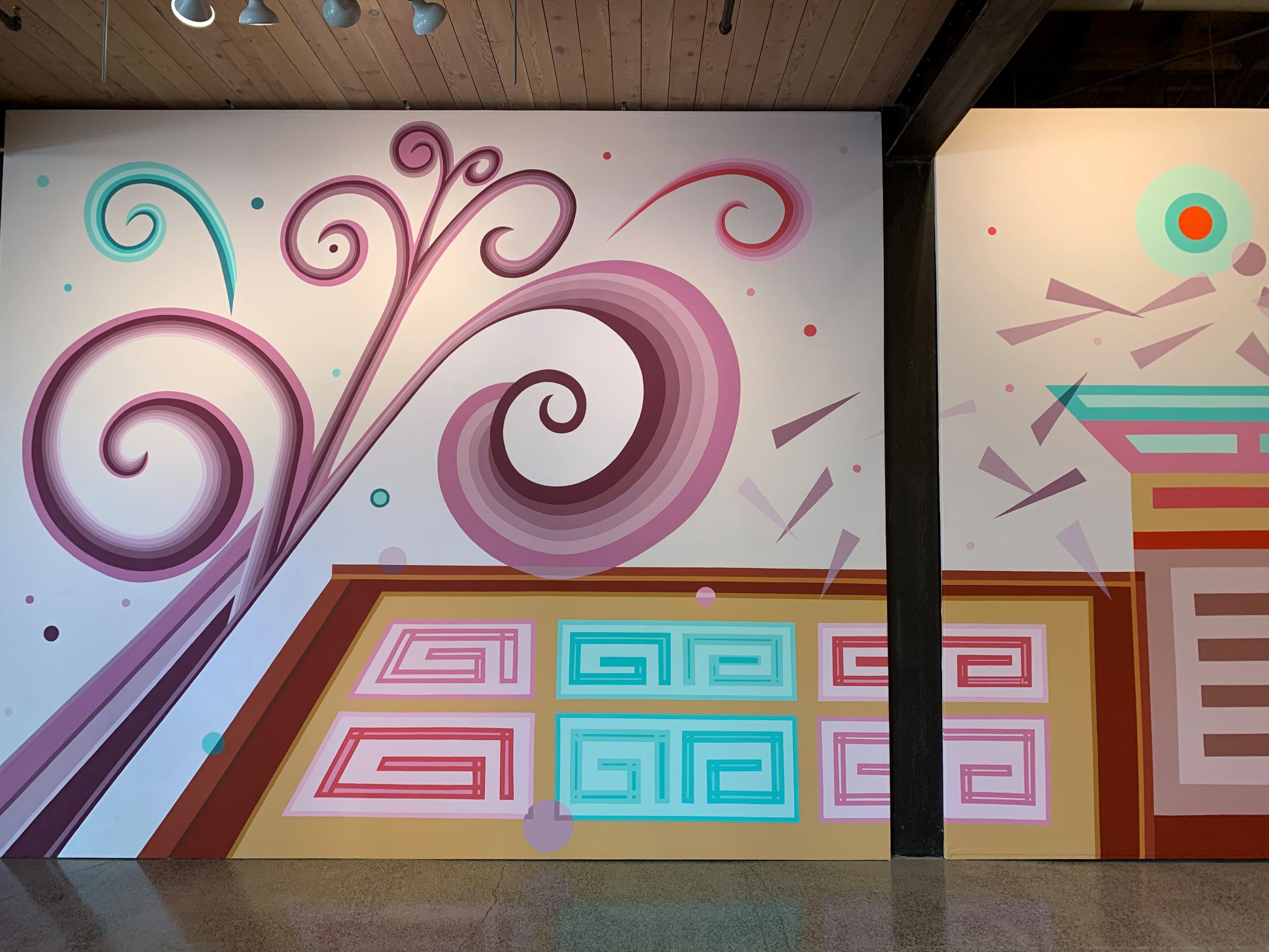
This burst of energy suggests a dramatic event, perhaps a volcano exploding. Look at the wedge shapes, which according to my friend Carolyn Tate, who knows all about Mesoamerican art, suggest the splintering of society. Underneath we recognize the familiar fret like decorations we see on Mexican pyramids.
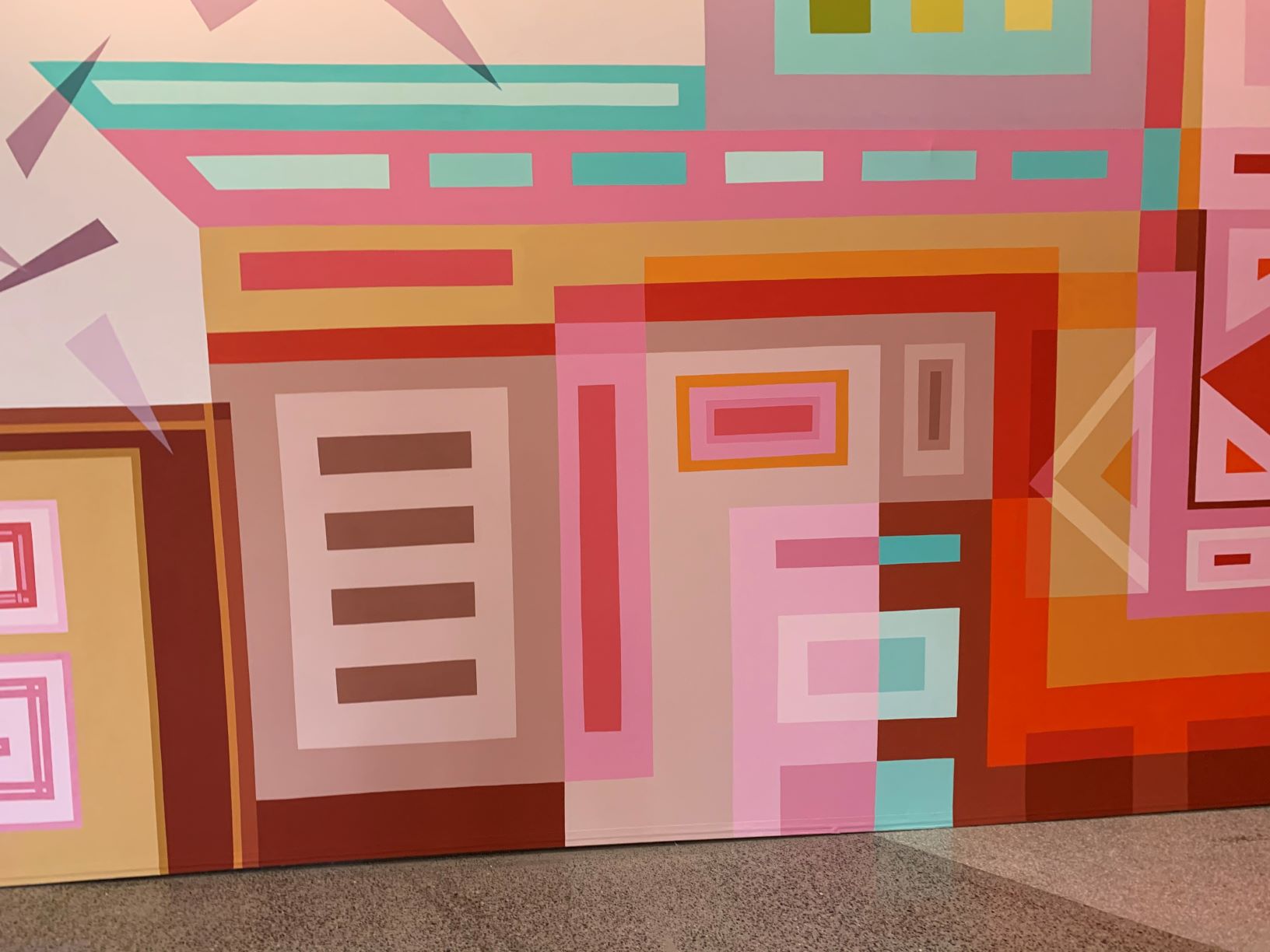
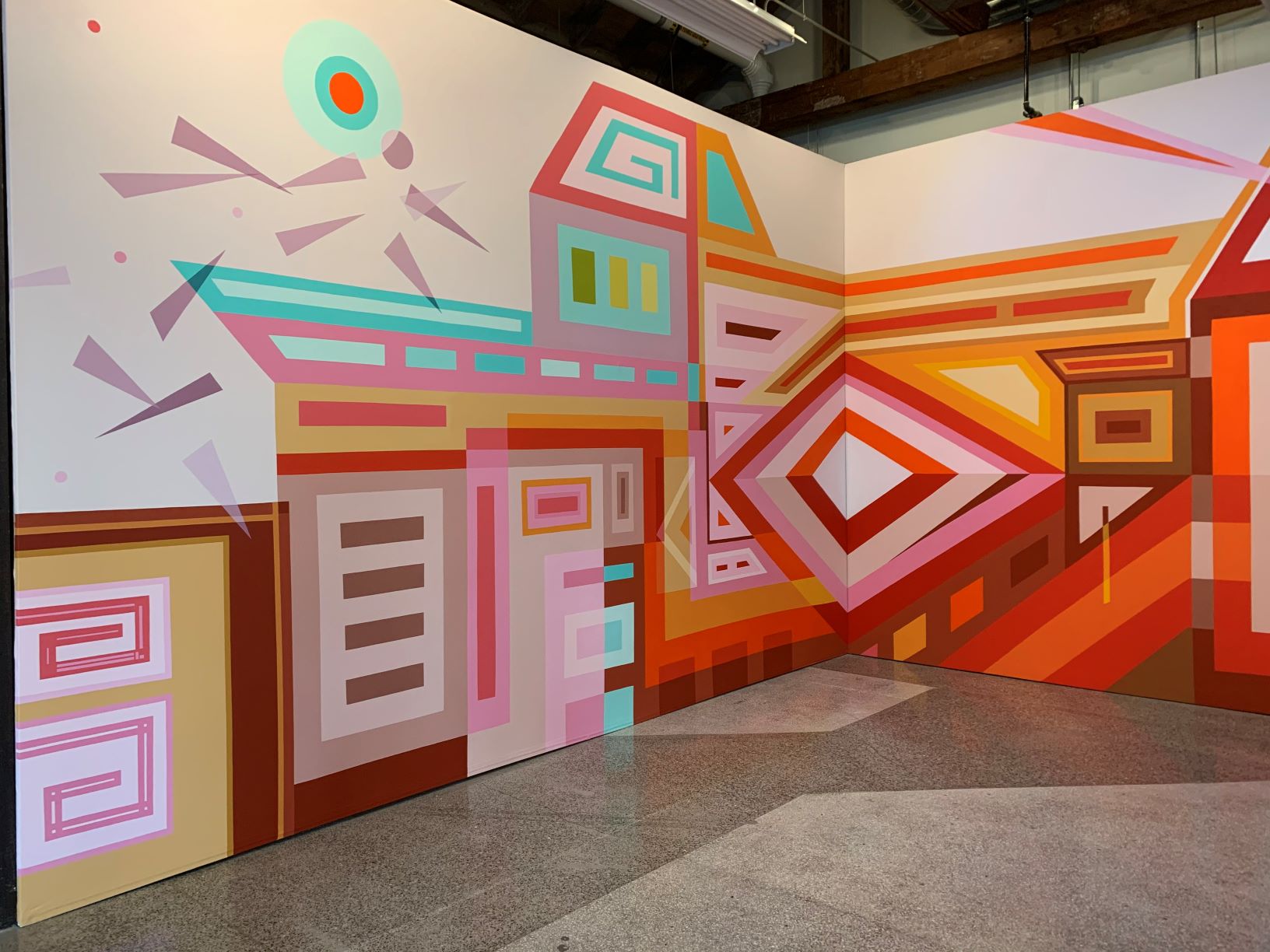
The next section suggests portals and entrances, especially the diamond shaped brilliant red shape in the corner. Then there are more portals. Above this is a light shaft going directly to the sky, which is part of the Mad Art gallery design, but Carolyn suggested we could be looking up from the underworld.
Next is the famous feathered serpent with its long tongue
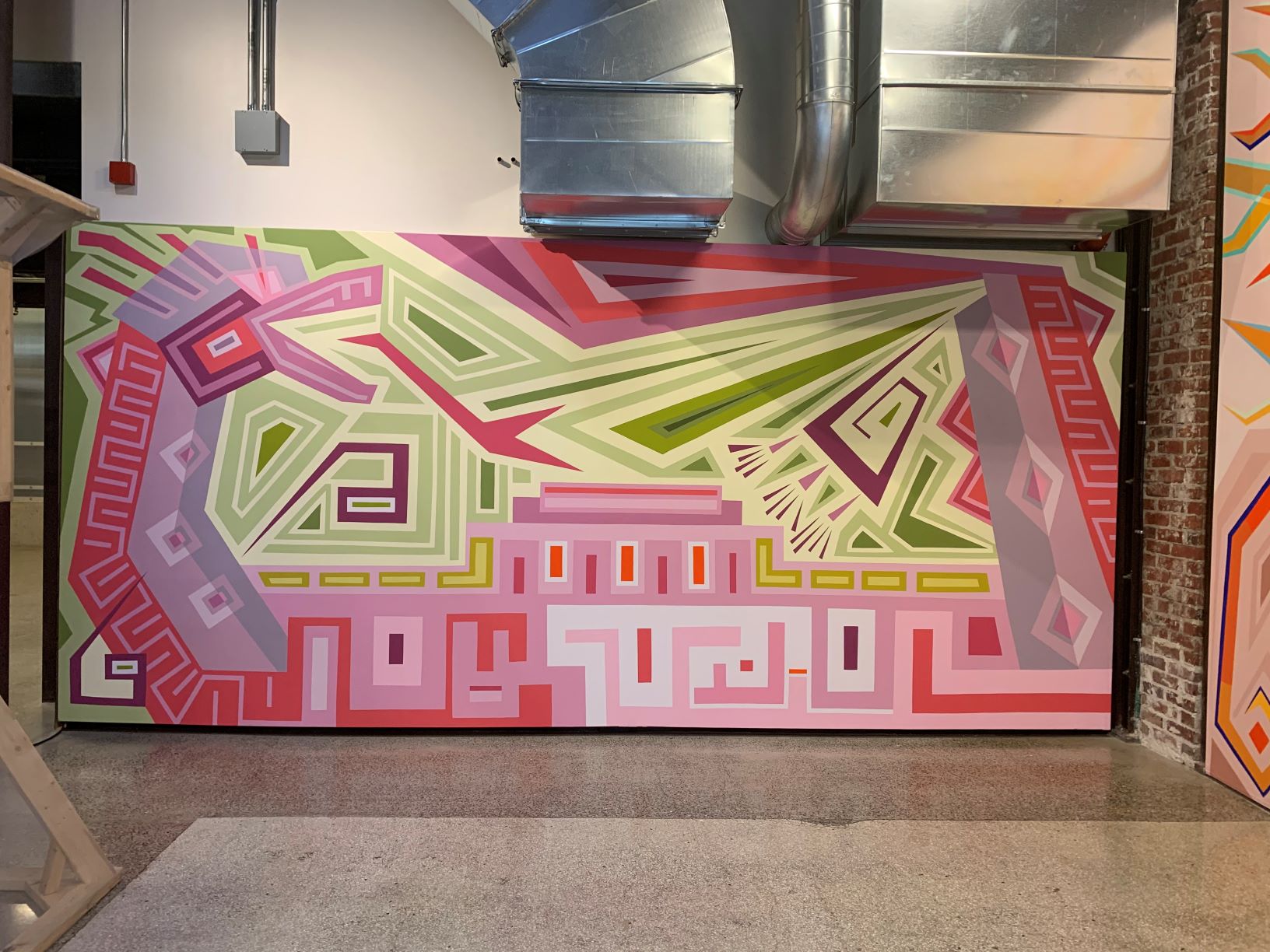
Here is the serpent on the original pyramid. It is easy to see how much Marela has integrated her deep understanding of the serpent with her own aesthetics of color and abstraction.

Around the corner is a glowing tree with roots reaching into the ground and labyrinthine spaces enclosed by its grasp.
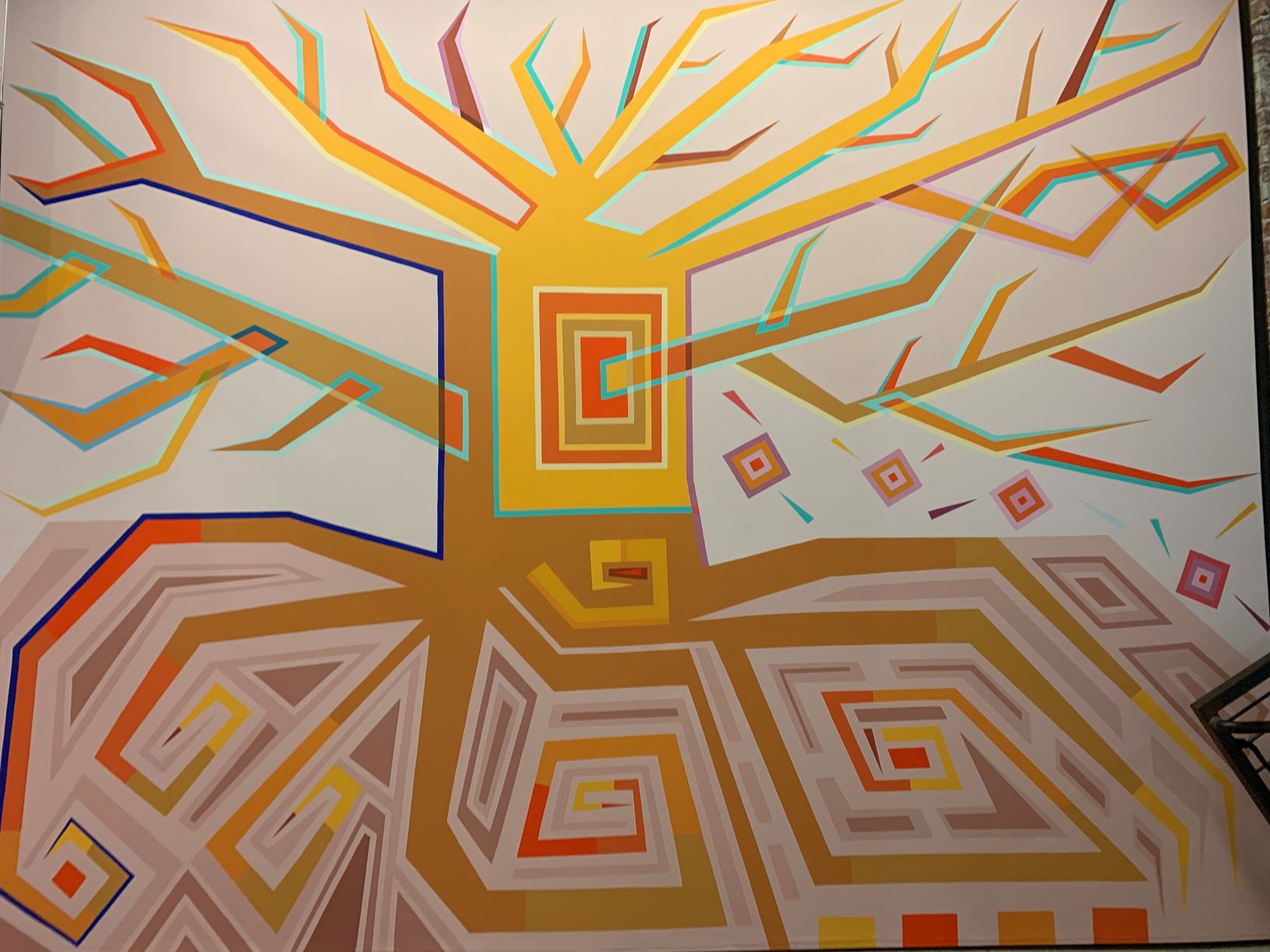
Finally we have a circular form collecting energies, perhaps a shield, a disc, a planet, a metaphor of unity.
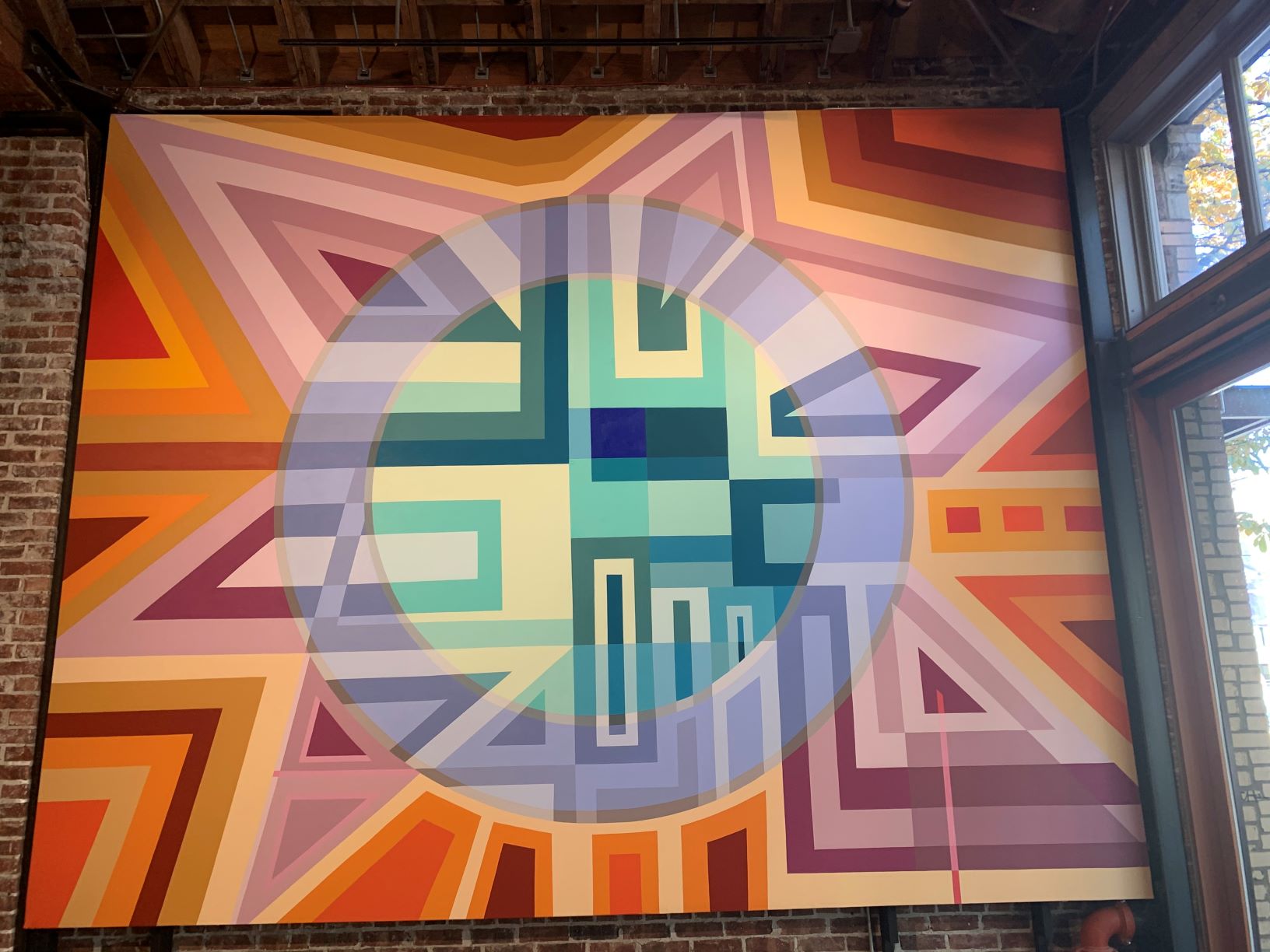
But then we turn back to explore the pyramid again and we see a strange shape hanging there, it is a plaster serpent wrapped around a tire. It represents Cihuacoatl, dedicated to the mythological Aztec goddess known for providing women with strength during childbirth.
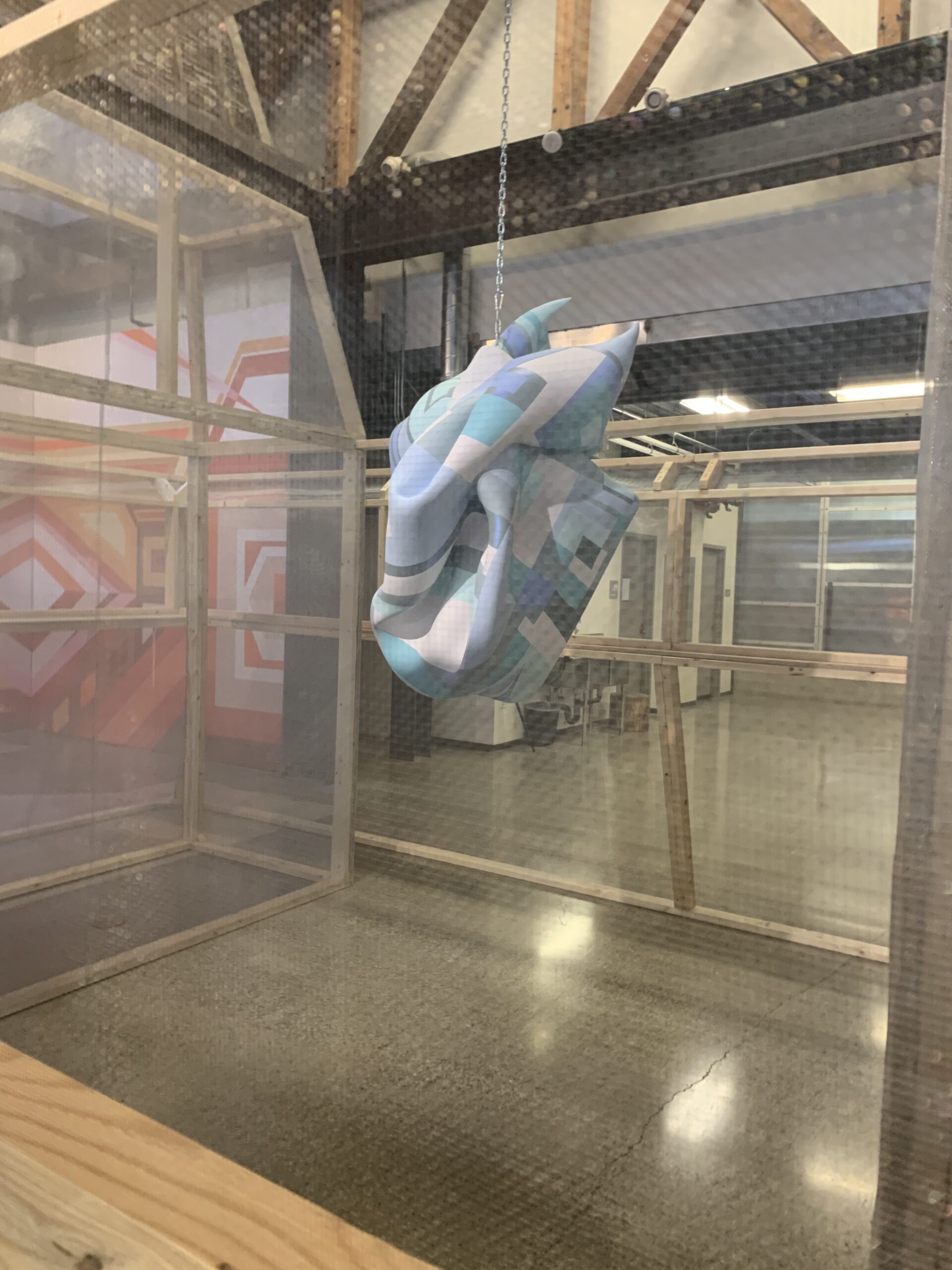
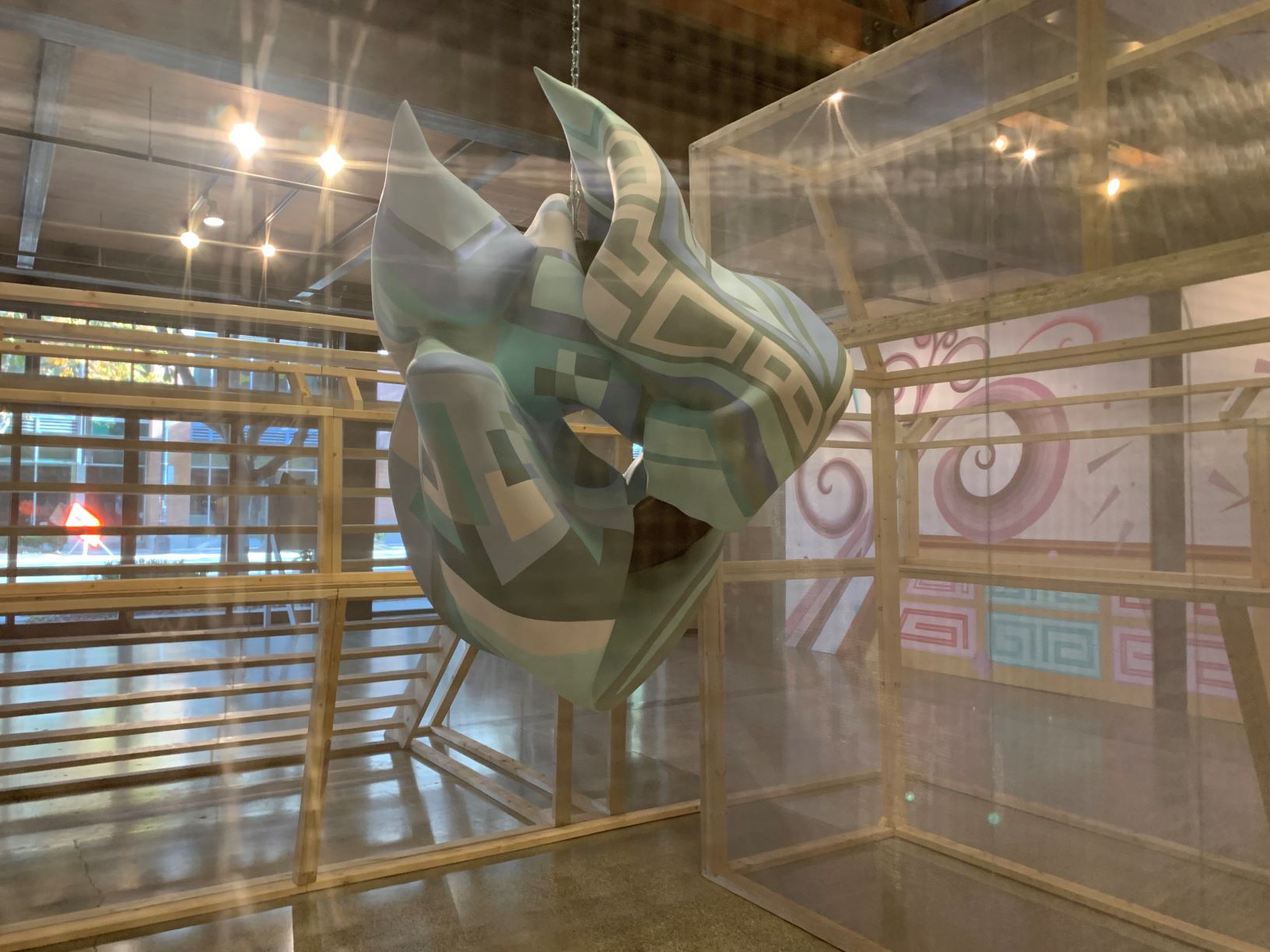
The artist said about the central image “I wanted to dedicate my temple to the resilience inherent in being a woman, the creative power, but also how we’re warriors with this energy that helps us. Not only childbirth, but I think of the women who are separated from their children at the border, of women who are going through a war, women who are single moms and finding food for their kids. I mean there’s just so much resilience that is called from us.”
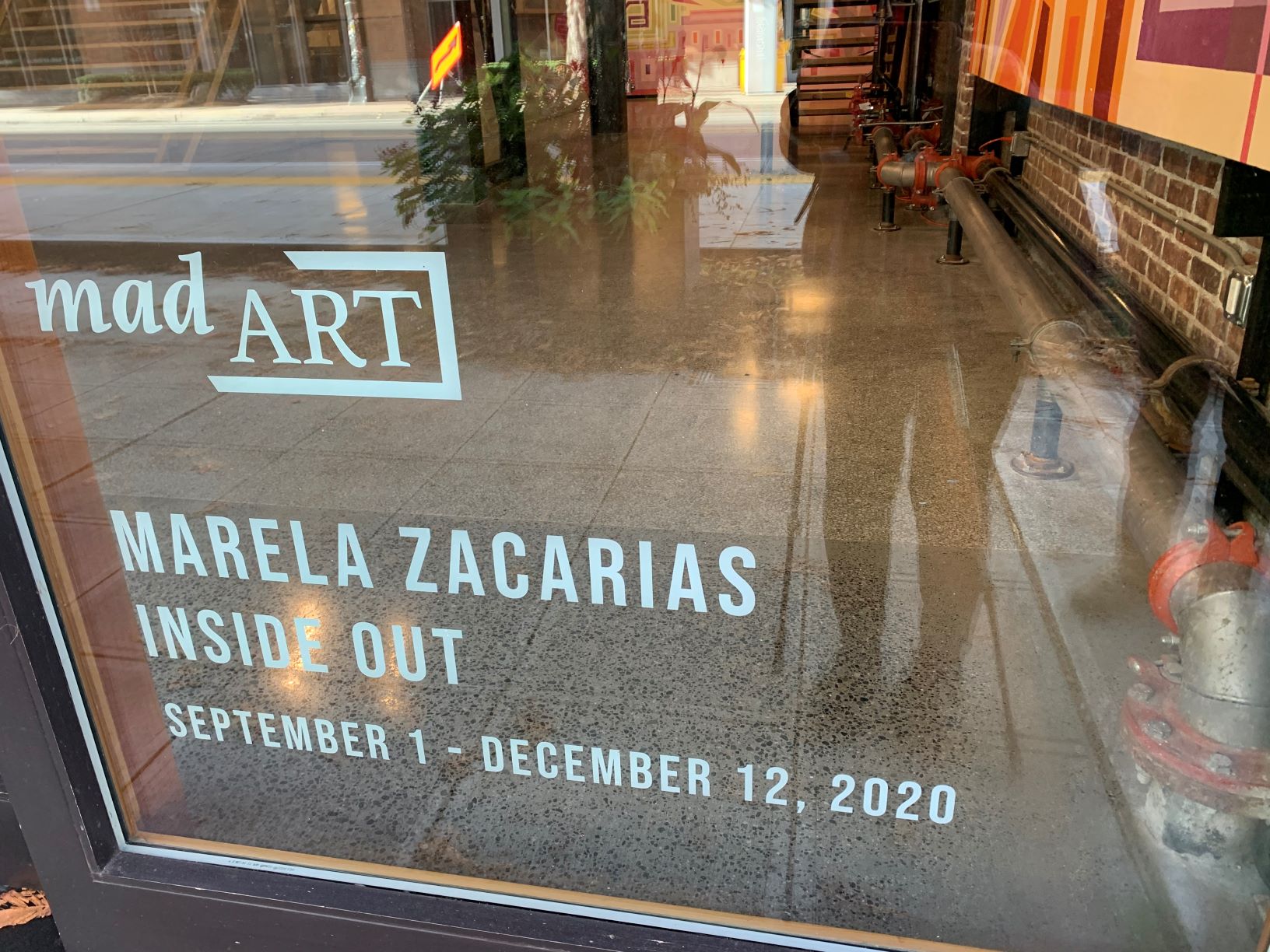
This entry was posted on November 6, 2020 and is filed under Art and Activism, Art and Politics Now, Contemporary Art, Feminism, Uncategorized.
Na Chainkua Reindorf
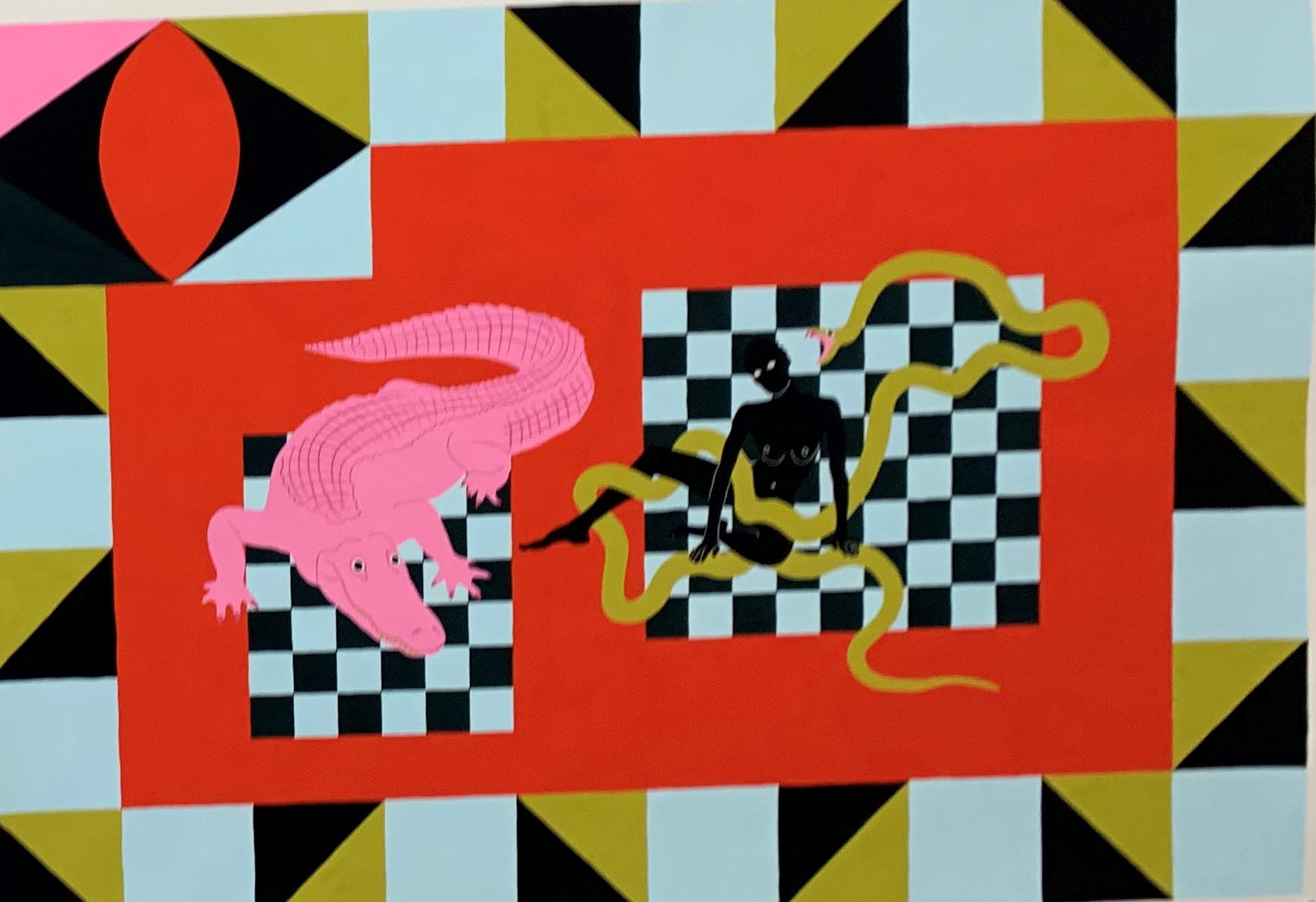
Peli: You don’t play games with danger
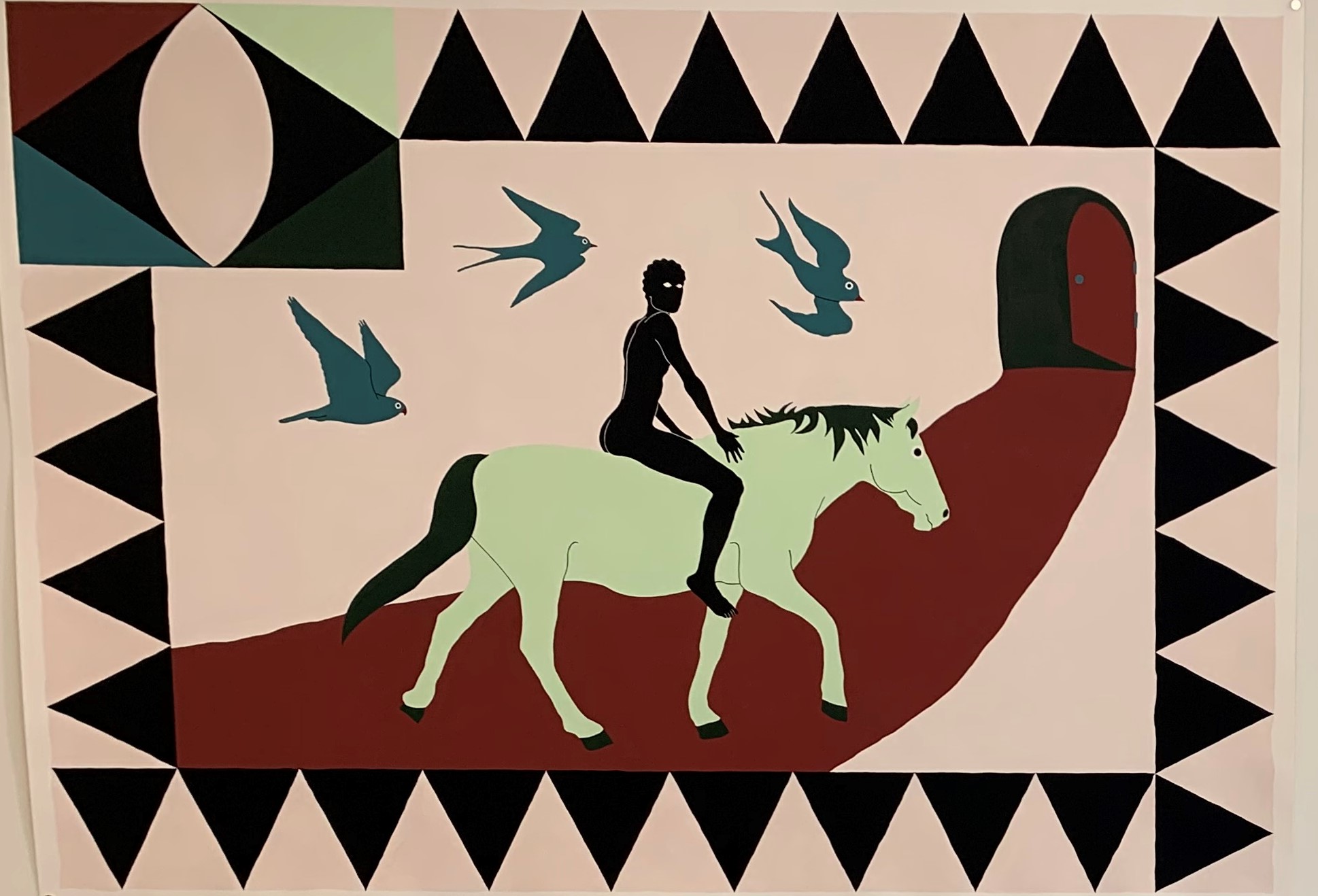
Bomi: Only the free can enter an unknown door without fear
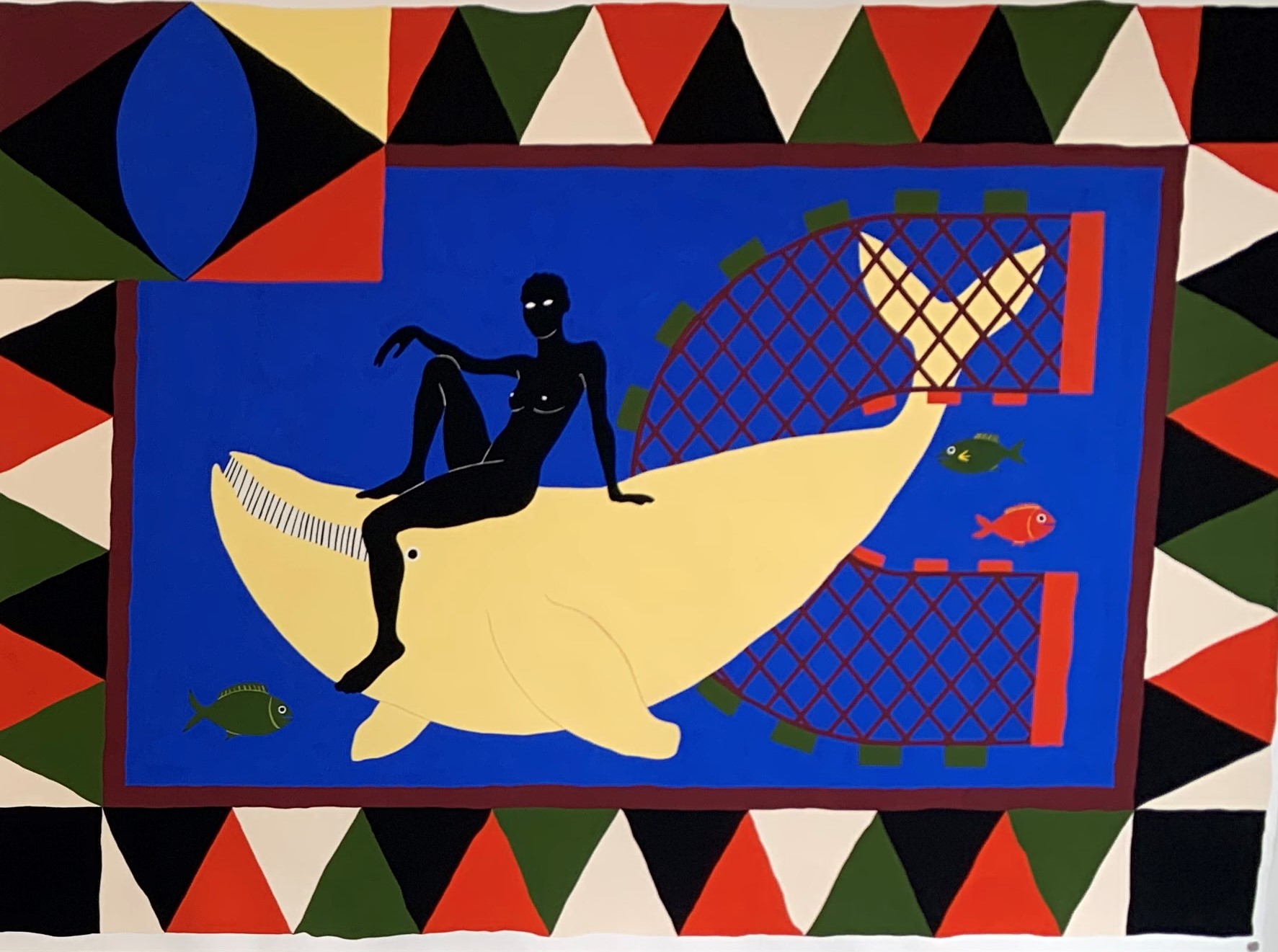
Lara The whale cannot be caught with a fishing net
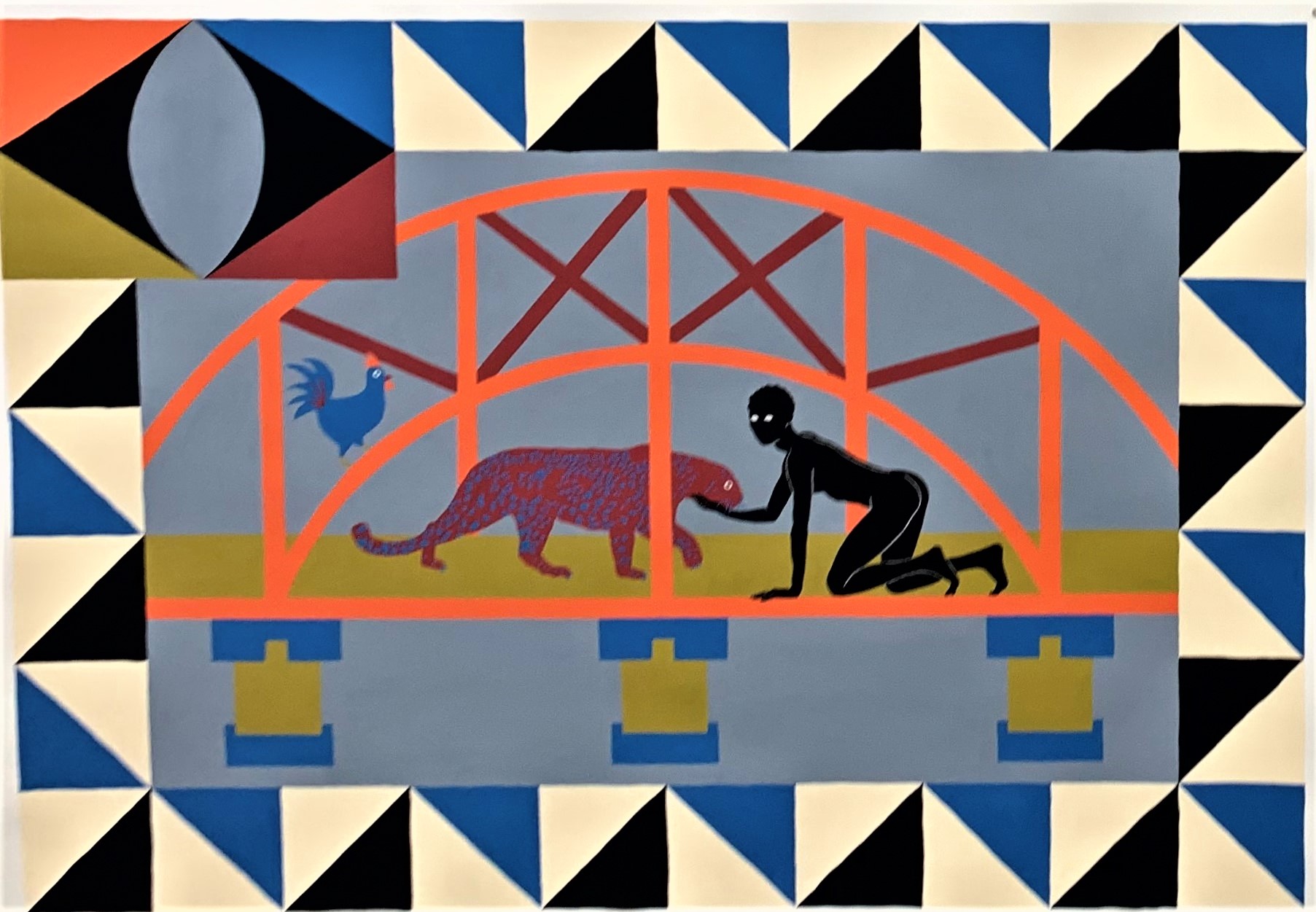
Evor: Only feed a beast with your hand when you don’t fear losing it
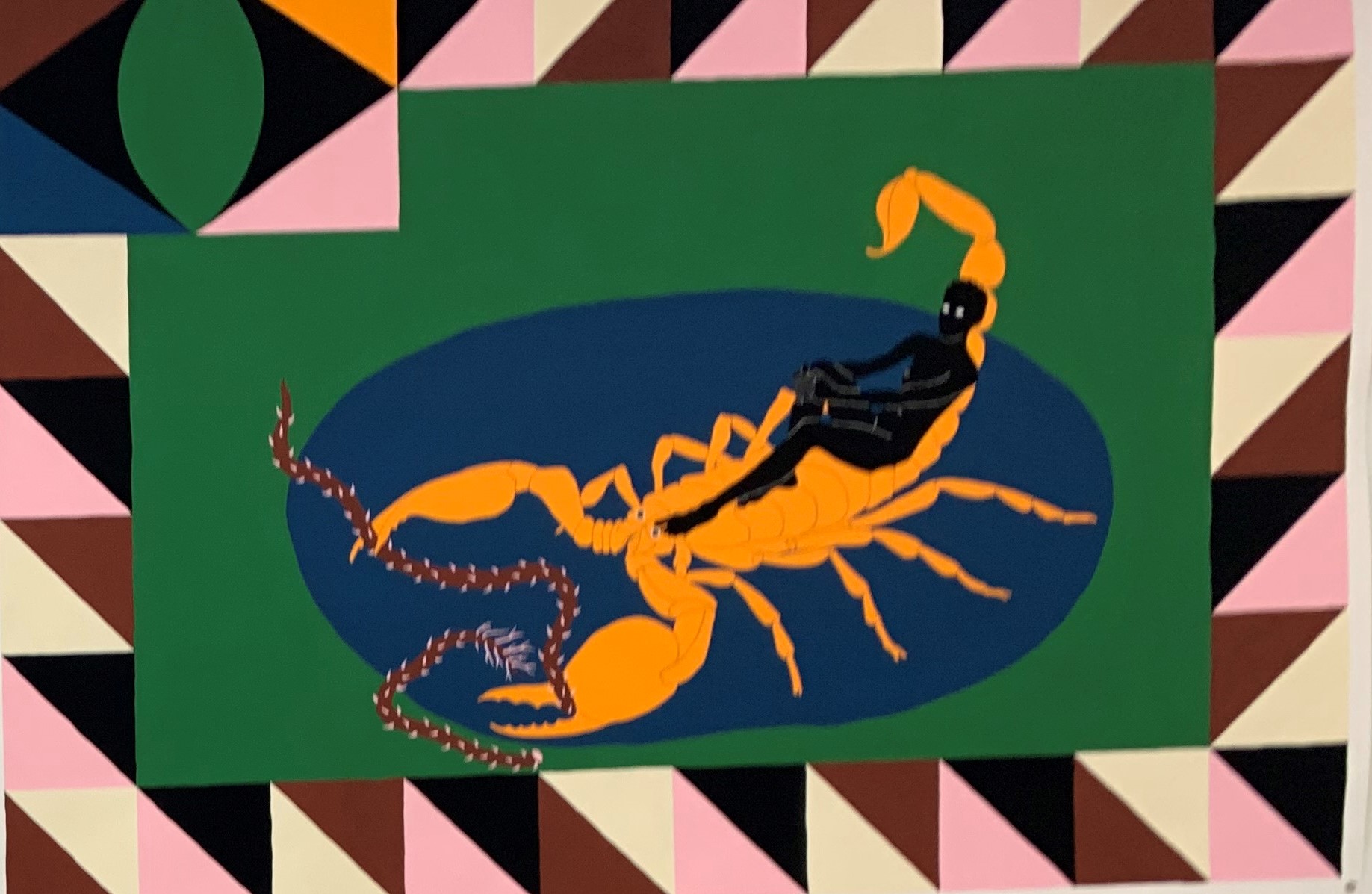
Nyeti Being a good friend of the scorpion does not mean you cannot be stung
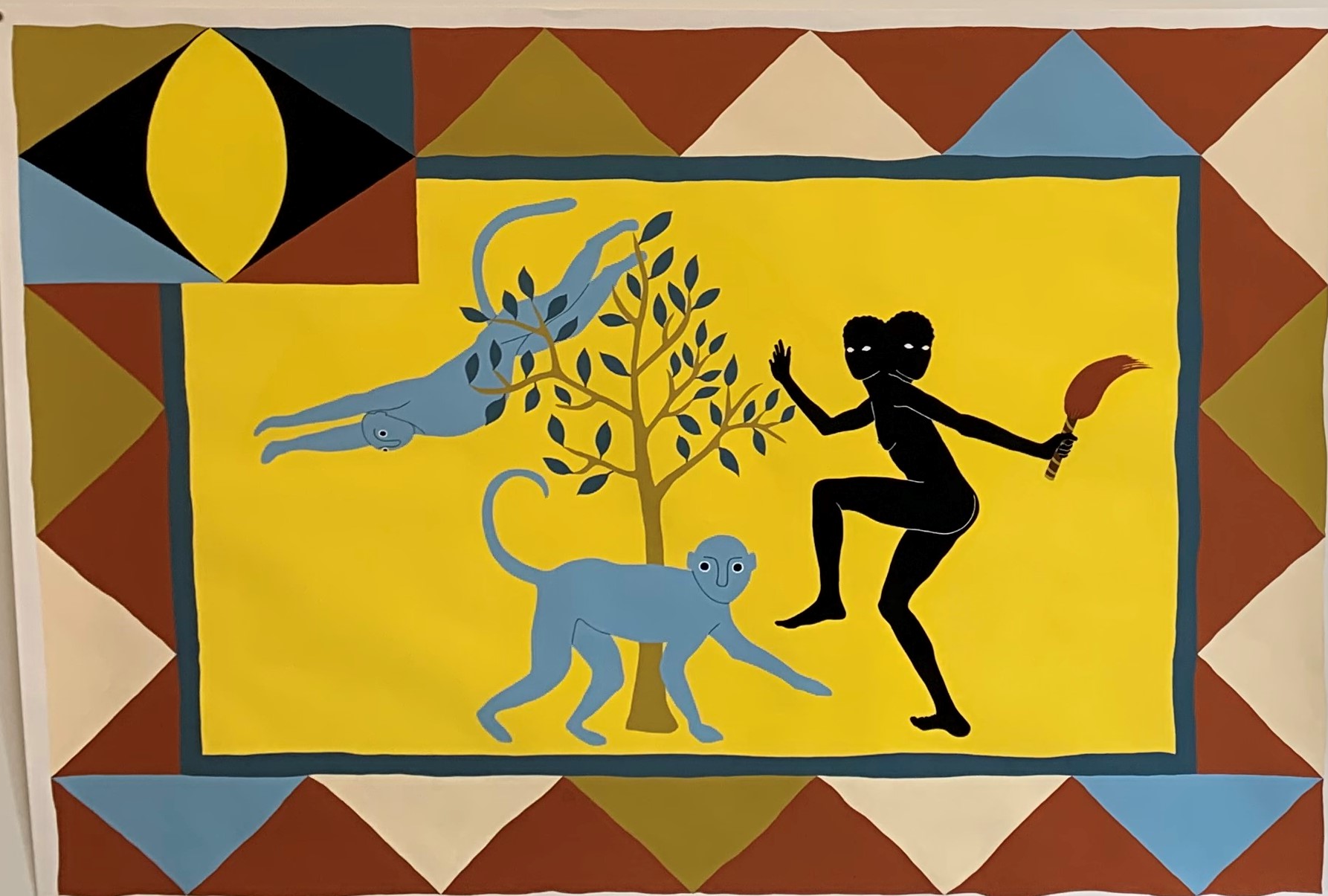
Tokpe: If you don’t want the monkey tail to touch you don’t attend the monkey dance
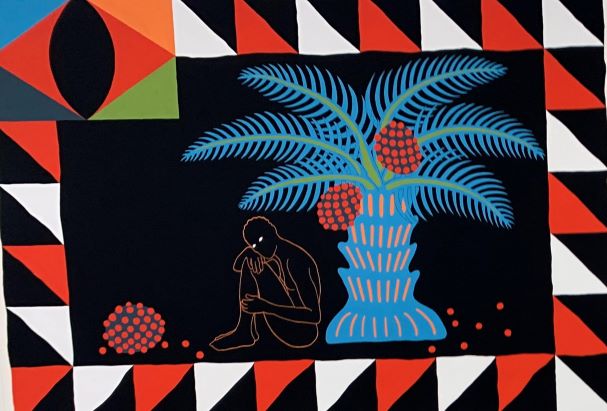
Gedu: The Palm Tree protects its fruits till they ripen
Ghanian artist Na Chainkua Reindorf is showing at the Specialist Gallery (until November 21, by appointment) a series of seven stunning works, with the title “Come, Let Me Spoil Your Things” The artist is inviting us to meet members of an imaginary secret society. This is the first phase of a long term project.
” this series of works introduces the seven original members of the Mawu Nyonu, a mythological women’s masquerade secret society believed to exist in parts of West Africa today.”
The seven masquerade characters “serve as mediums through which actions can be performed and in some cases transformations can take place”
Masquerading can ” explore ways of being that could be considered radical or unacceptable . . . they inhabit a world where women can explore their deepest, darkest and often radical desires through the art of masquerade, without fear of repercussion or judgment.
According to the artist
“The Mawu Nyonu (roughly translated as ‘god-woman’) are believed to have formed as a direct result of the 19th century disbandment of the Dahomey Amazons, an all-female military regiment active in what is now present day Benin.
Each painting in “Come, Let Me Spoil Your Things” takes the form of a flag, introducing each of the Mawu Nyonu characters, who forge the basis of their own unique masquerade. Reindorf’s carefully rendered gouache works are inspired by appliqué flags and banners from both the Asafo militarized states in Ghana and the former kingdom of Dahomey, Benin.
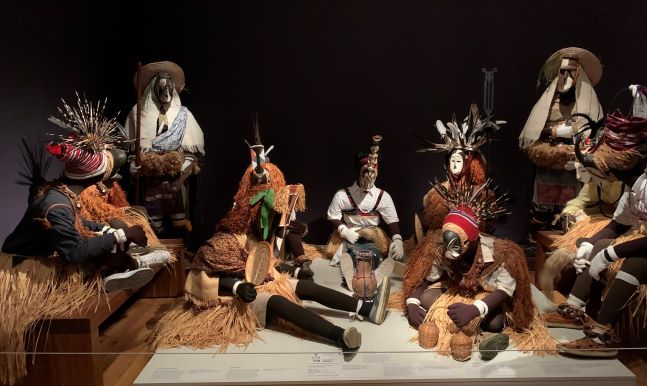
Okumpka Masquerade Players “The Pot of Foolishness” Chukwu Okoro masks, Sam Irem costume elements , assembly Eze Anamelechi
By coincidence I visited a masquerade installation at the Seattle Art Museum today as well.
“Ridiculous mistakes don’t hide in Okumpka plays. Instead an open pot is carried into view by a masked spirit who announces his name and offers a speech or song that explains why he is the most foolish man of all. Often his boast isn’t immediately accepted and he is urged to defend his claim, thereby revealing more of his blunders. Others continue to vie for this title and confess to their own stupid actions. Leaders ultimately decide who deserves to be known as the most foolish, an honor that conveys pride in facing one’s own folly. ”
As we approach Hallowe’en, as well as universally participate in masking to stay well, these are provocative exhibitions to think about. What does a masquerade mean, in these two cases they imply moral lessons, and deep feelings. What do we mean by it here in the US in November 2020 when we can no longer recognize even people we know, are we all transformed in this strange present into disguise, giving us the opportunity to explore our inner selves? To think about our relationship to nature, to other human beings, to the future and to the past?
This entry was posted on October 25, 2020 and is filed under Art and Activism, Art and Ecology, Art and Politics Now, Uncategorized, Women Artists.
Women’s Suffrage and Women’s Suffering
The Center on Contemporary Art (COCA) WHAT STORY WOULD THE UNINTENDED BENEFICIARIES TELL (WSWUBT), which closes in two days, is a wonderful small selection of artists addressing the suffrage amendment and who was left out. The artists include Carletta Carrington Wilson with a selection from her incredible Letter to a Laundress series that I have written about before.
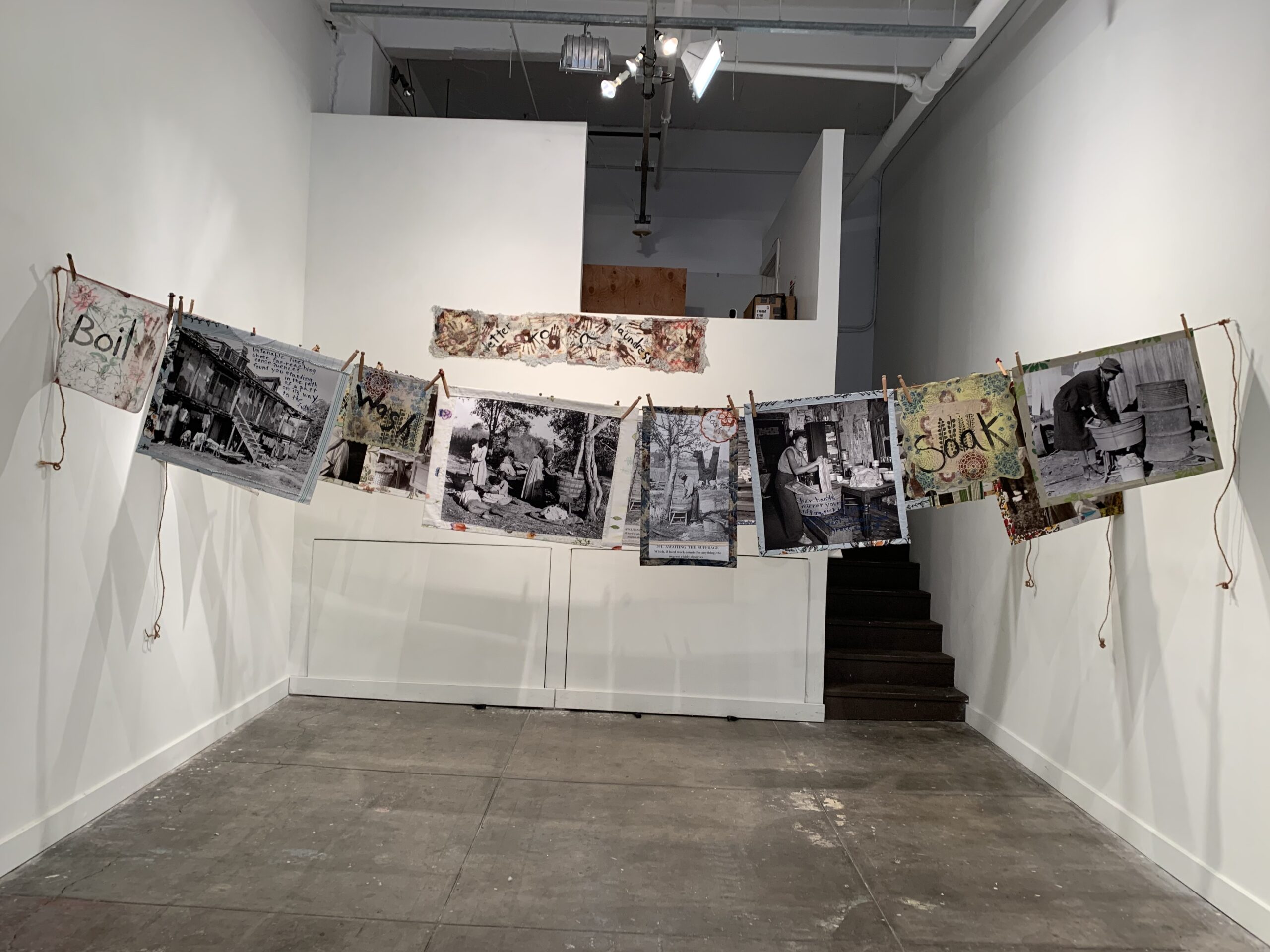
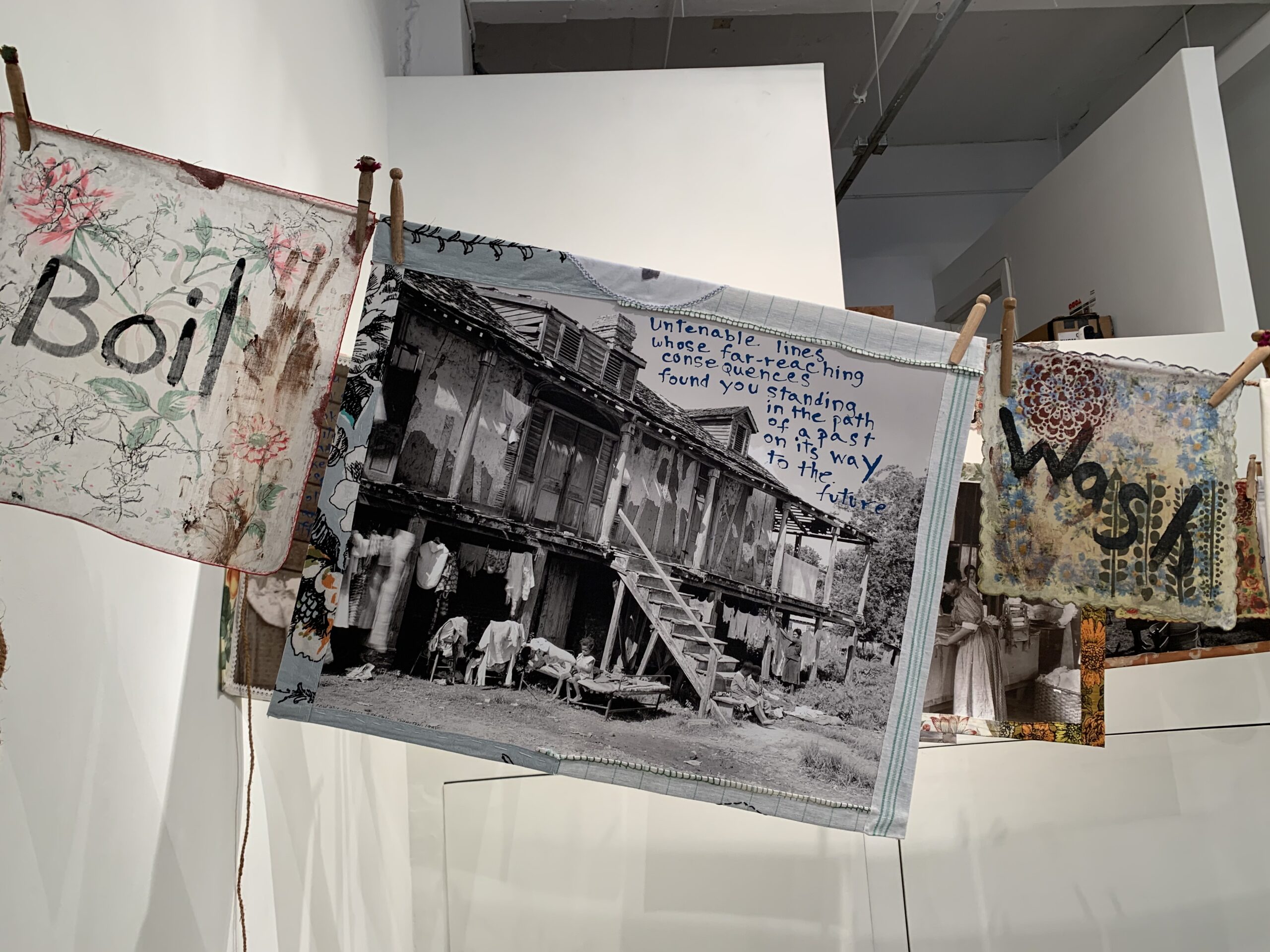
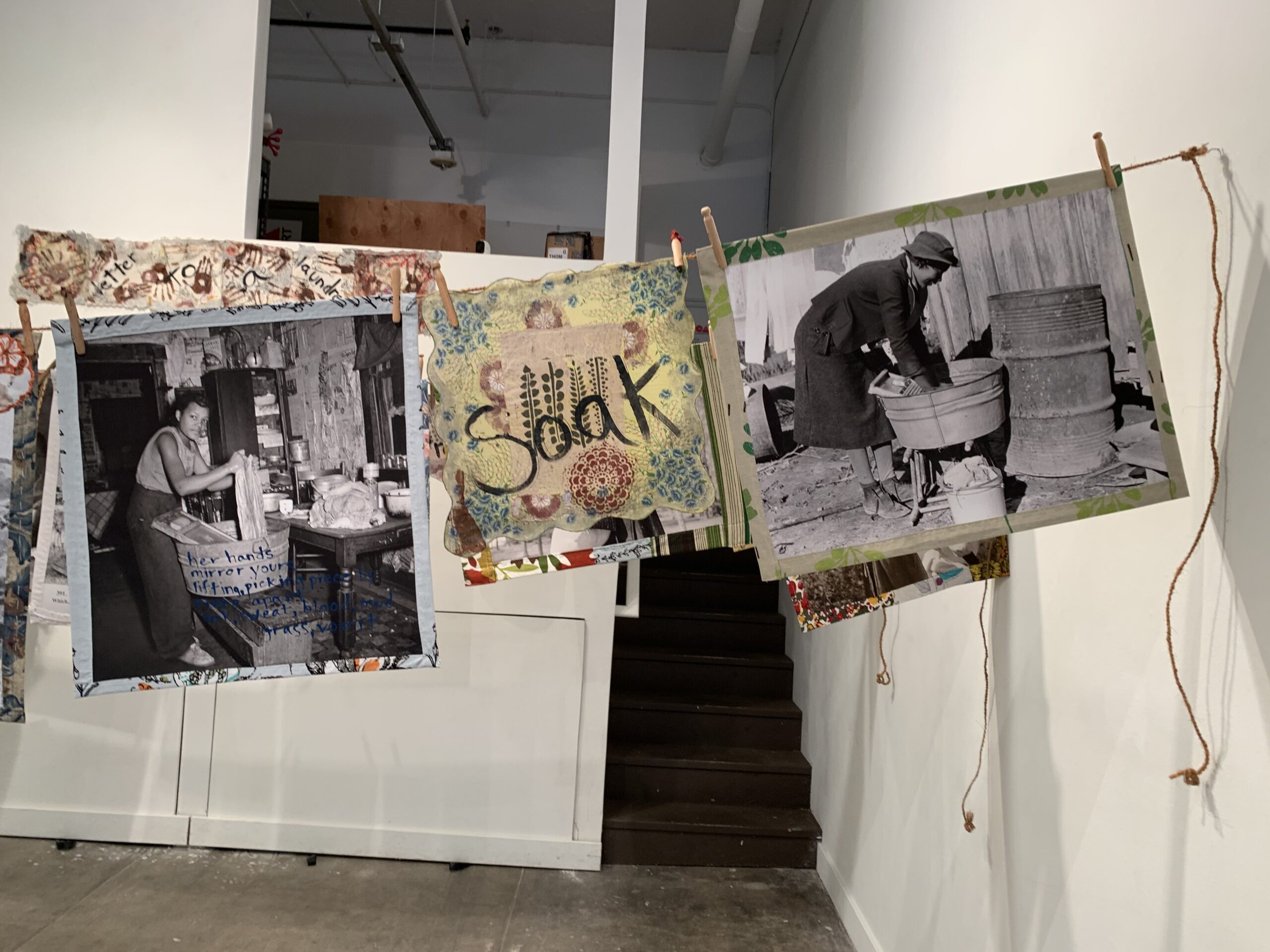
Carletta was stunned to discover that one of the archival photographs from the 1930s WPA photographers project had a caption directly referring to black women being left out of suffrage. Carletta added this image three times to her original series.
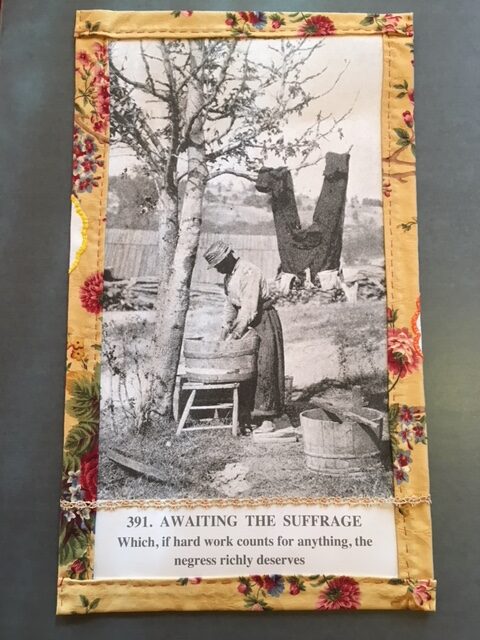
And note the background of the photograph with the upside down pants. Each verb in this series has a step in the laundry process, which we don’t even know about any more with our washing machines. Each step, as the artist hangs it on the washing line across the gallery suggests another meaning. In her installation Carletta had ten steps “Wash Soak Starch Wring Boil Pin Rub Scrub Hang Press.”
The other artists at COCA are less familiar to me, but together make a compelling statement.
This is Charlie Carlos Palmer directly referring to slavery in his powerful paintings that imitate the language of run away slaves and auctions. Look closely at the details!
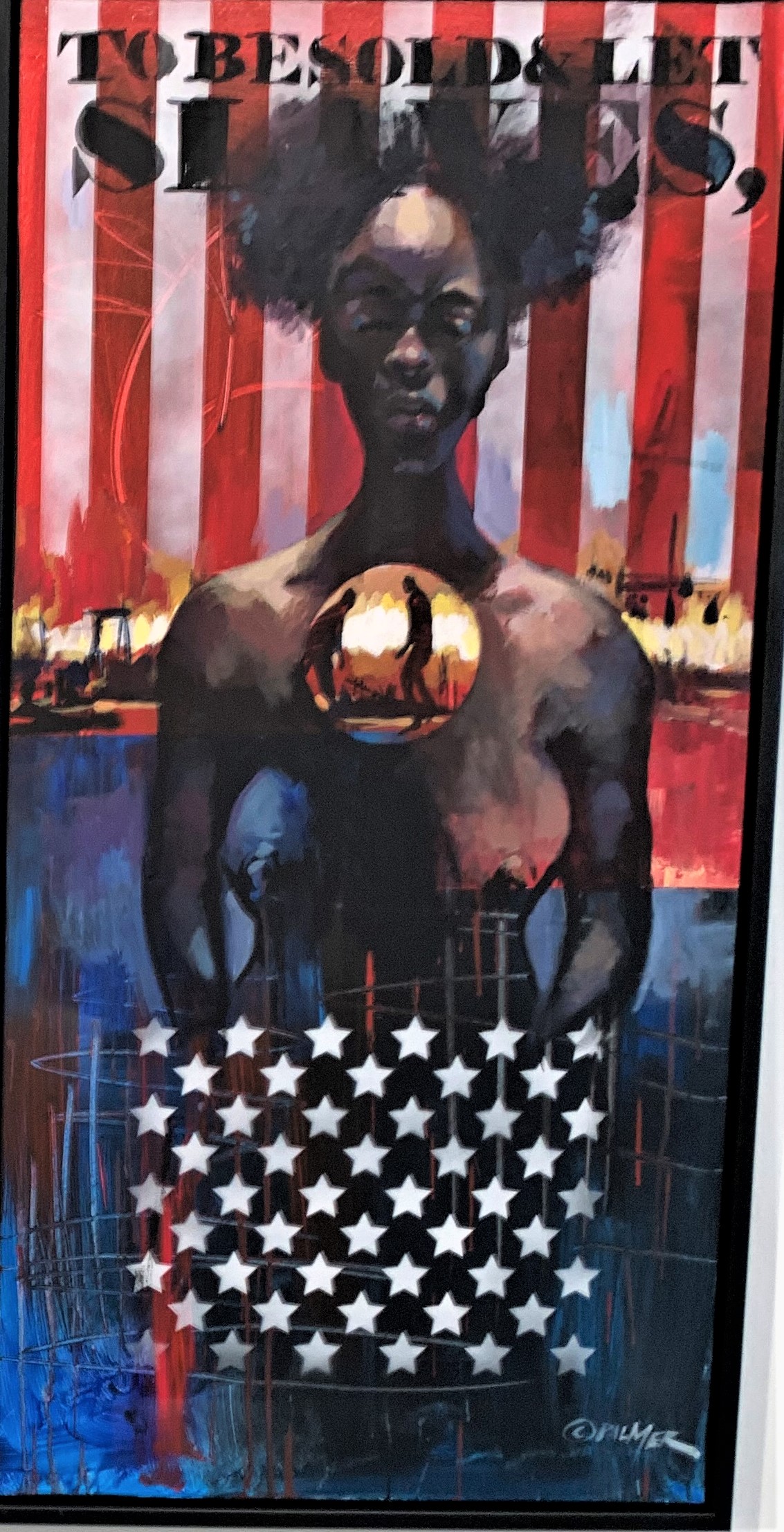
Hollow I 2020 Acrylic on Canvas 48 x 24″
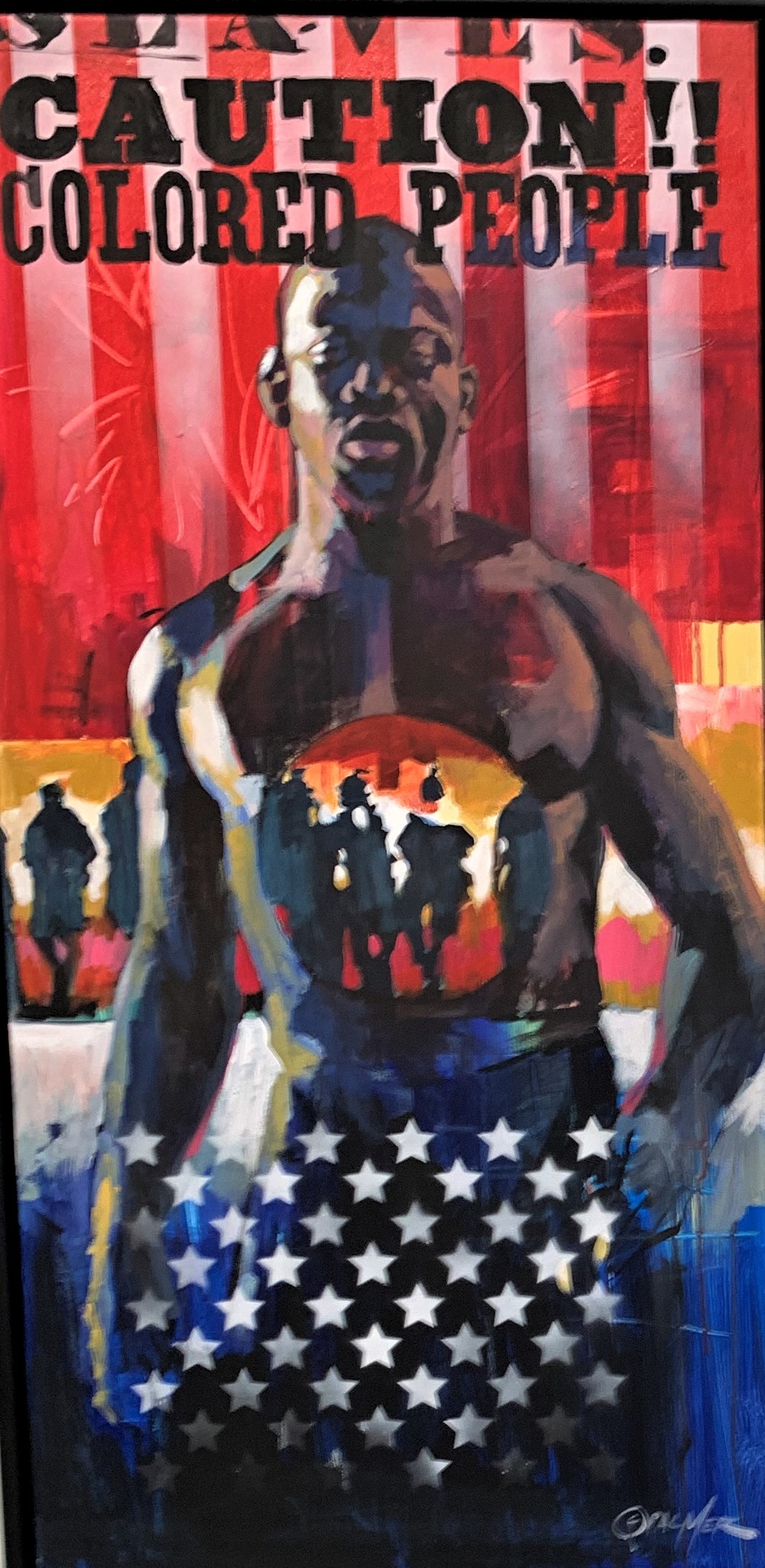
Hollow II 2020 Acrylic on Canvas 48 x 24″
We have Bonnie Parker
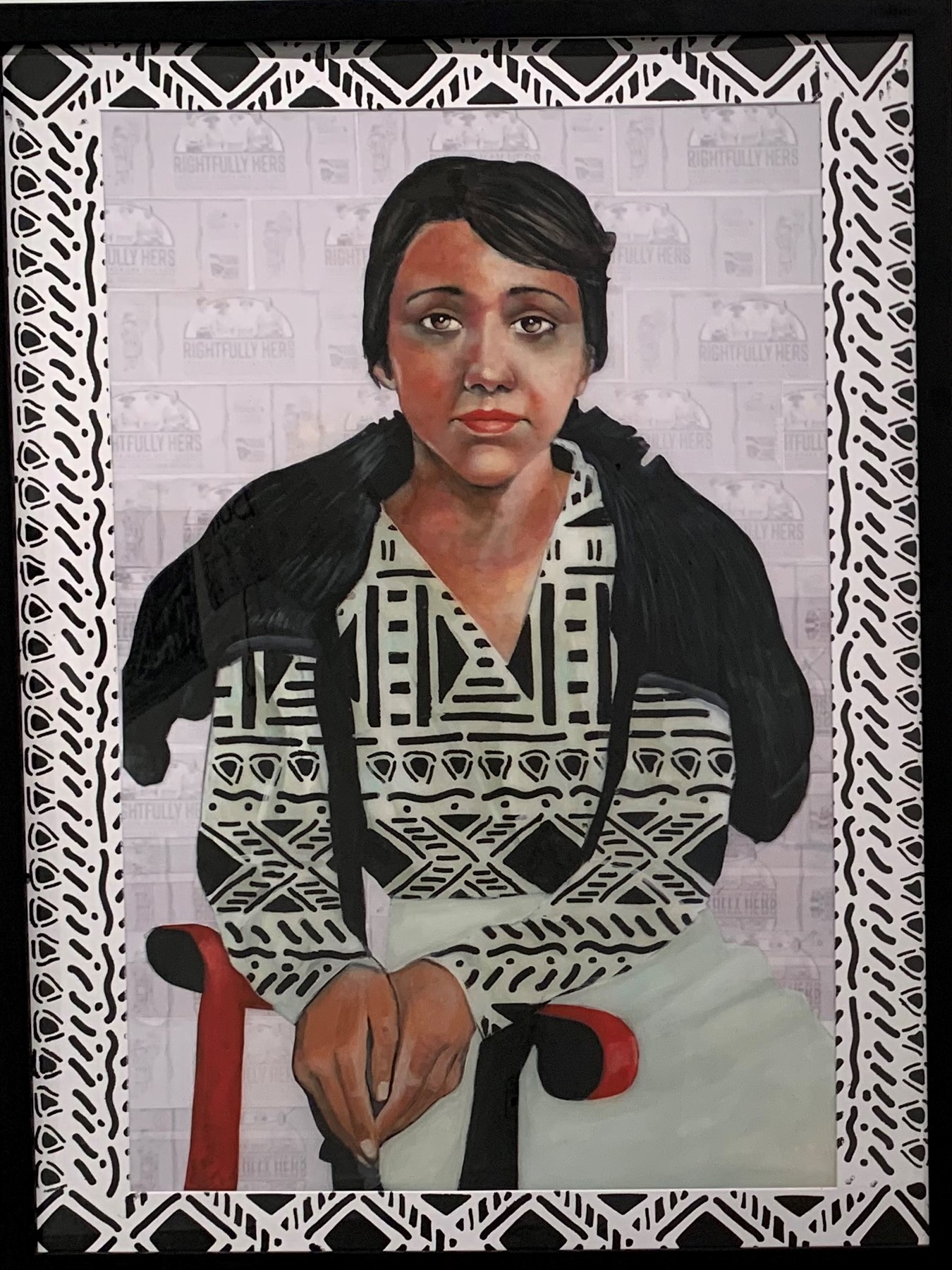
Left Out of the Conversation 2020 acrylic on yupo paper 30 x 40″
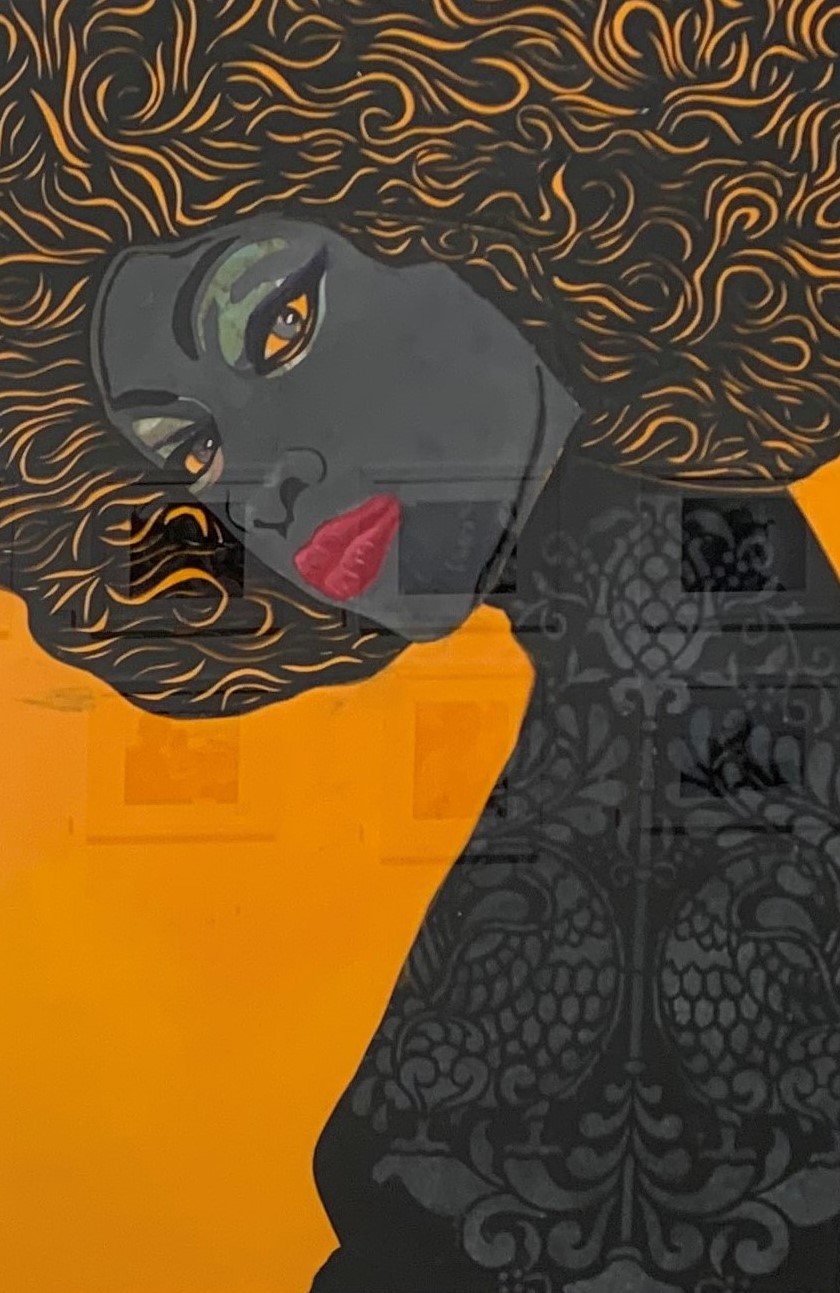
Legacy, 2020 printer ink on yupo paper 30 x 40″
with her compelling portraits of black women.
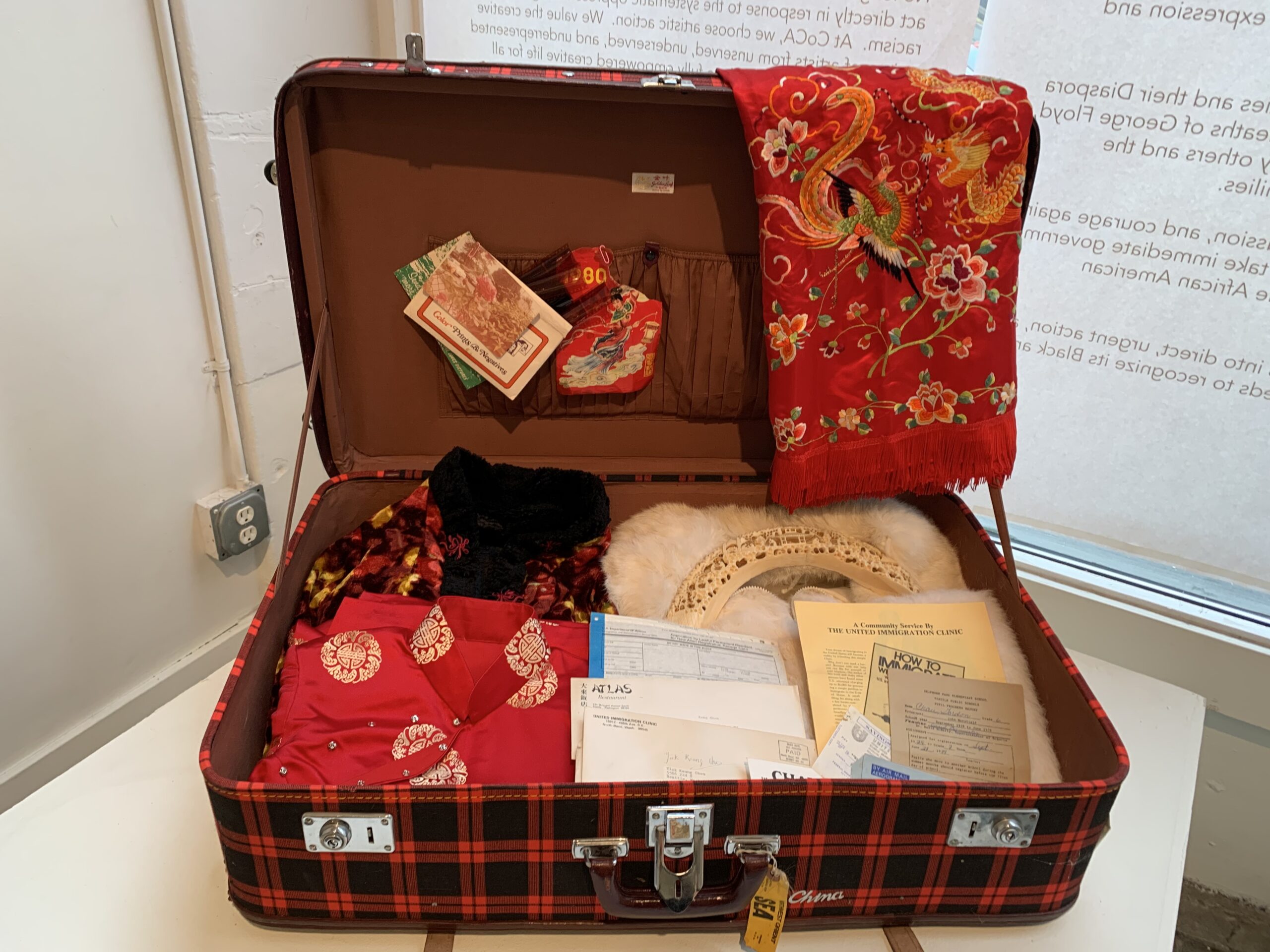
The Things They carried 2018
And then there is the fascinating Monyee Chau addressing the Chinese American experience.
Finally there is Lisette Morales with her wonderful series of Latina portraits. Here is one.
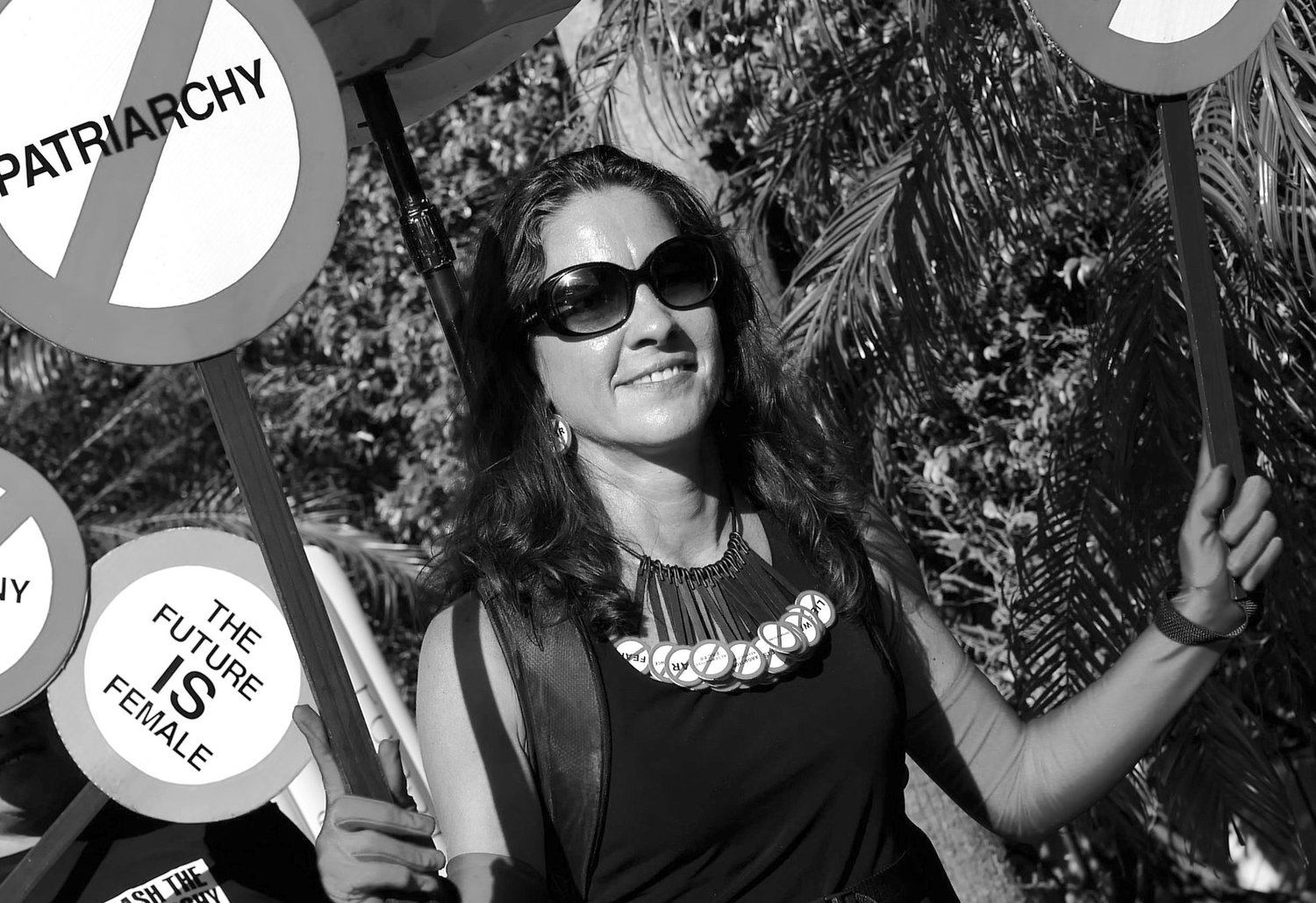
Alessandra Mondolfi | Artist and Activist
the artist has described her series as “Compathy: Latinas on both sides of the lens” is a collection of 22 Black & White portraits of Latinas. See the rest of the series on her website.
They include a wide range of Latinas of different ages and professions
Ivette Gomez describes them in her eloquent statement
“They are embodied compassion and empathy in action. Sometimes heroines, like the nurse that risks her life in a pandemic, other times women that are considered arrogant or prideful because they dare express what they consider to be unfair, for being advocates of the rights of those that have not yet found their own voice.”
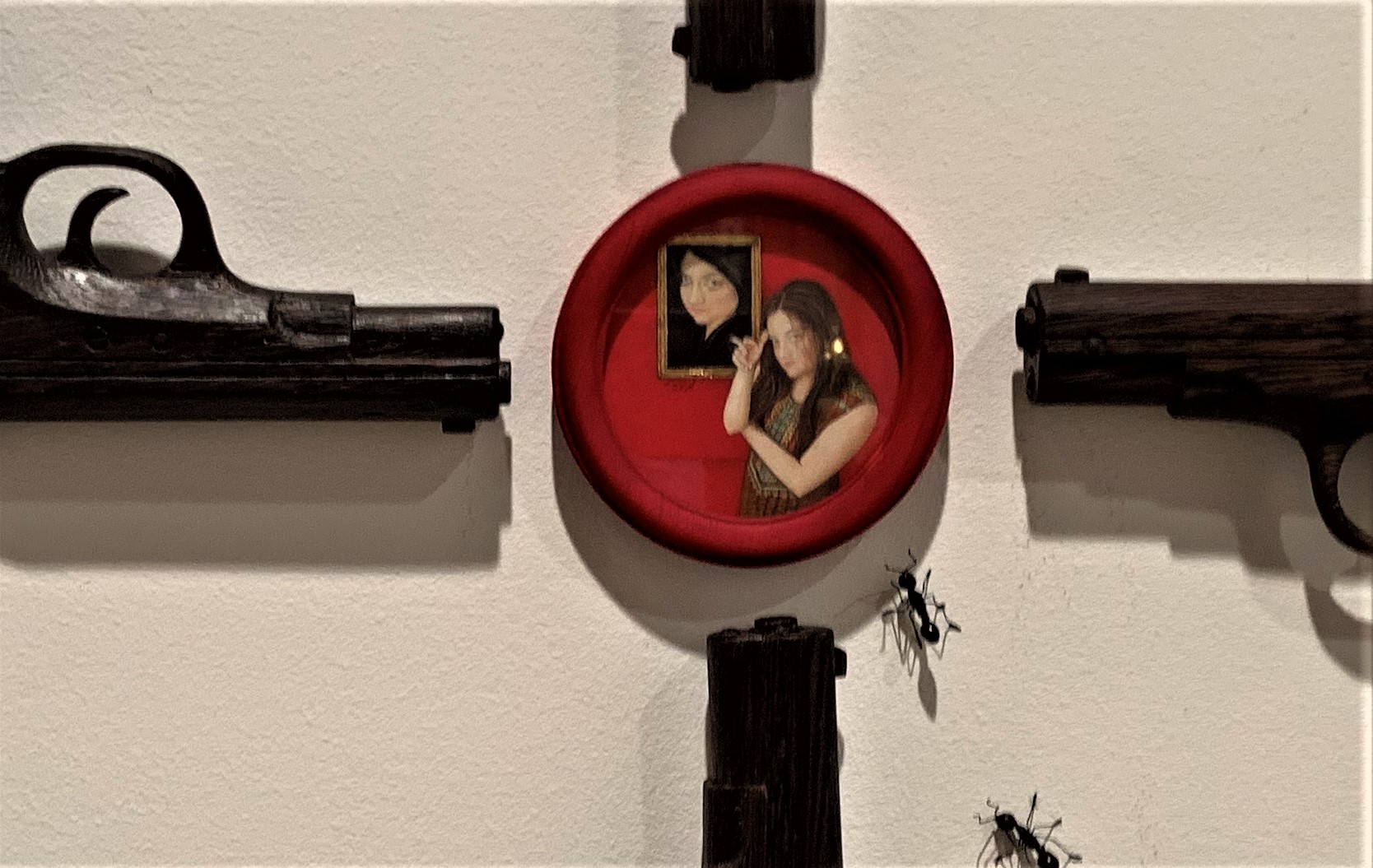
Another important show is at Greg Kucera until November 7 “Humaira Abid, Sacred Games” This amazing exhibition, her first at Greg Kucera’s, reveals her secret sorrow. At first it looks like ordinary objects brilliantly fashioned from wood, a purse, a shirt, but as we go deeper into the exhibition we learn that she was molested repeatedly as a child by a family member, and everything acquires a new layer of intense meaning. There are also explicit references to her traumatic experiences. Here are a few of her works
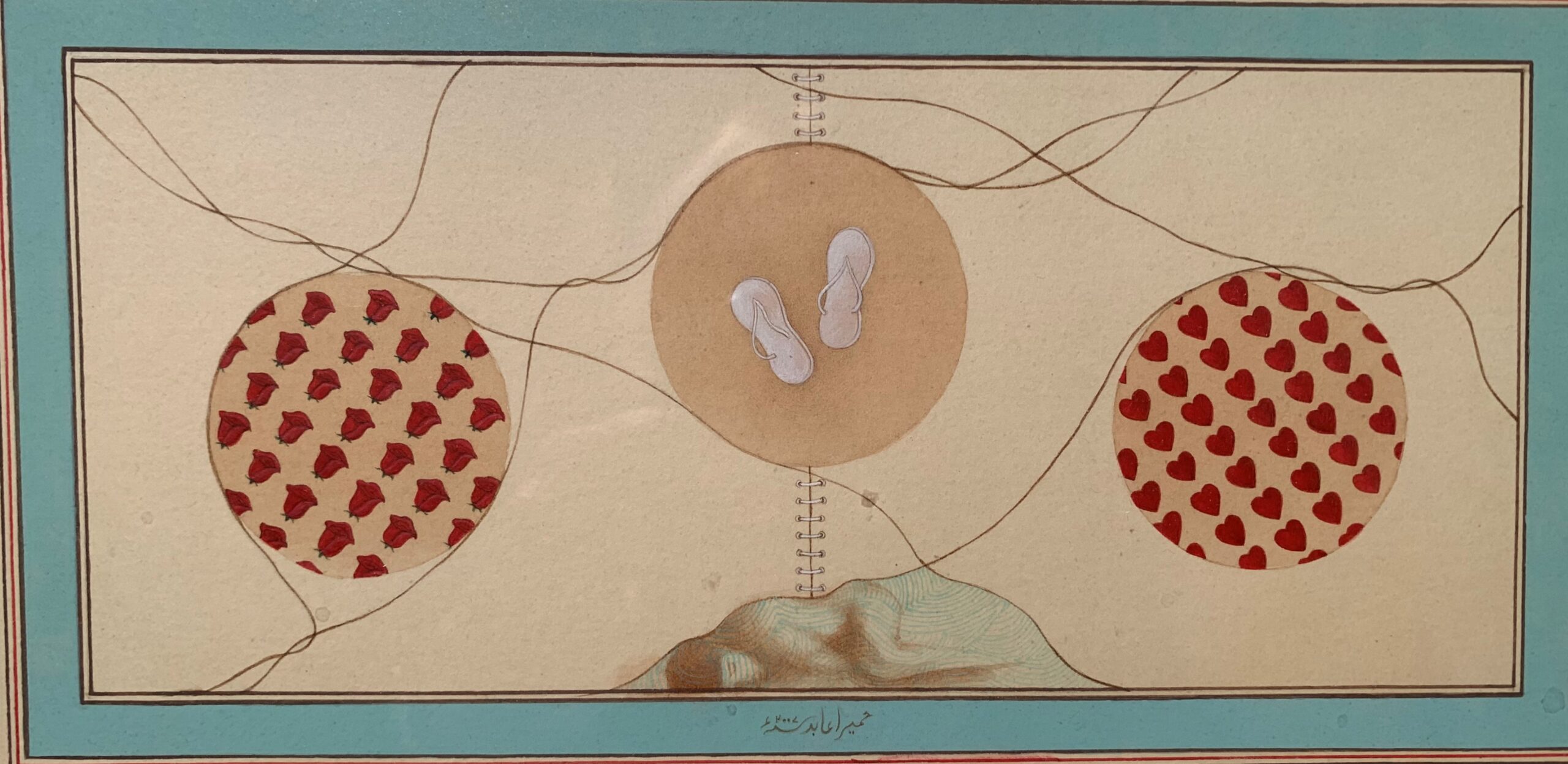
WOMAN’S PLACE IN A MAN’S WORLD – I, 2007 Gouache on hand made wasli paper 17.5 x 13.75 inches
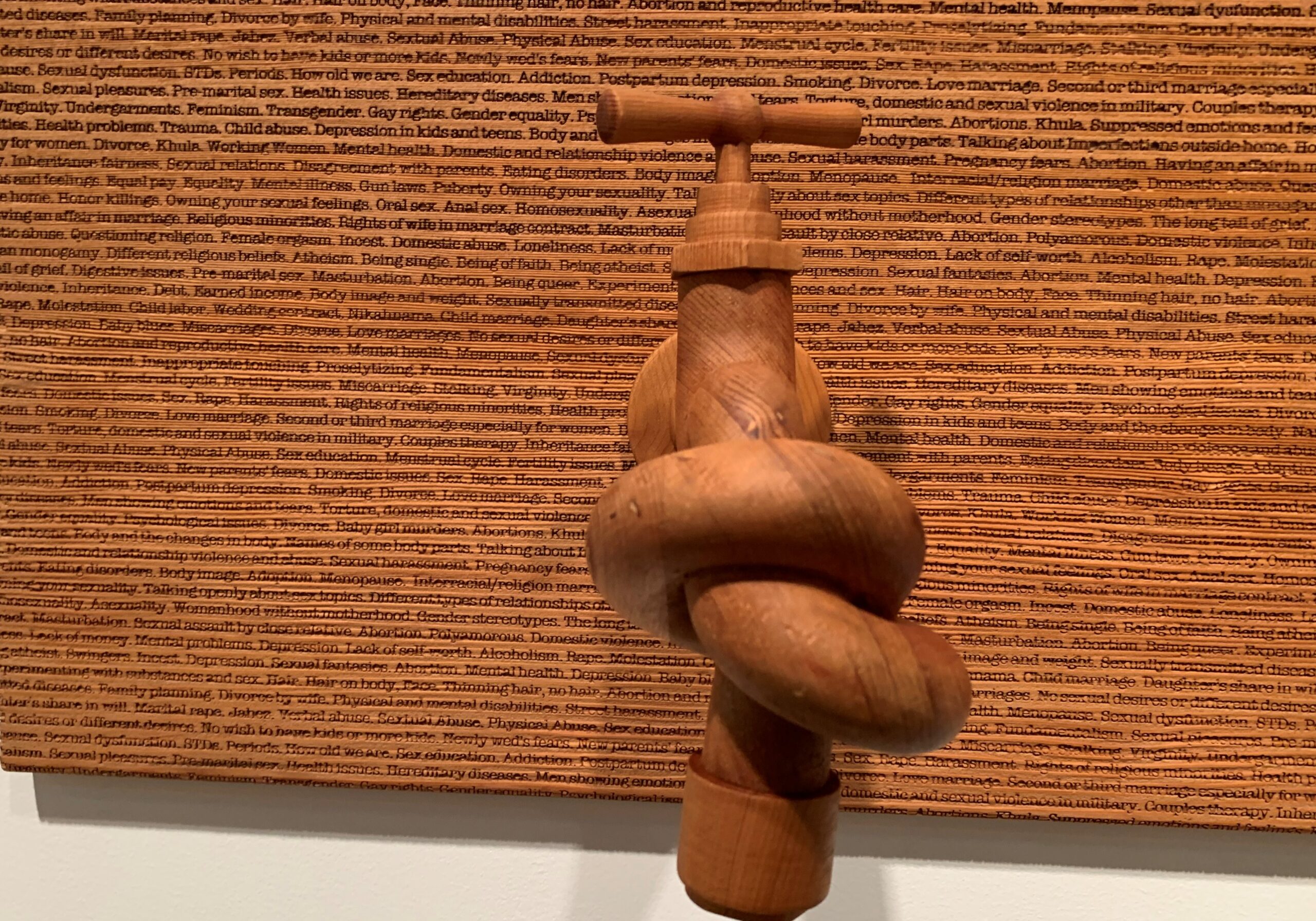
CONVERSATION, 2020, carved pine and laser etched fir, 48 x 11 x 8.5 inches
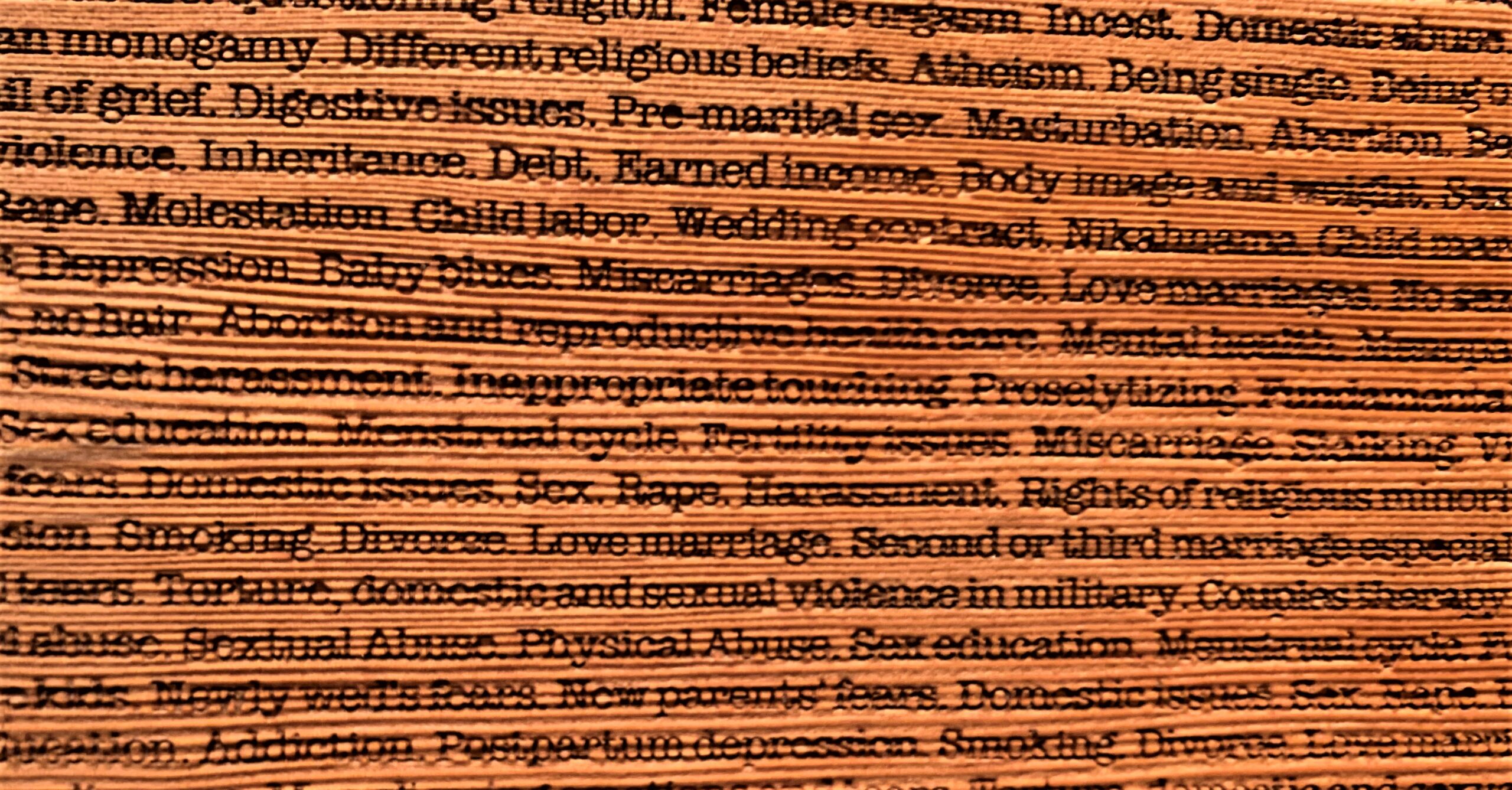
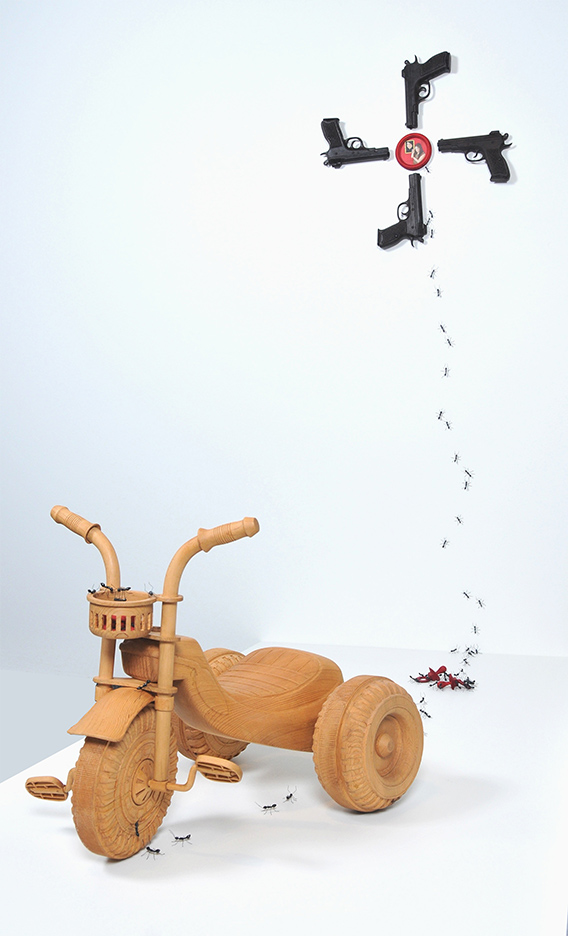
SELF PORTRAIT, 2014 Carved wenge and pine woods, wood stain, wire, epoxy putty, paint, gouache on handmade wasli paper, 24k gilding Installation dimensions: 72 x 60 x 36 inches
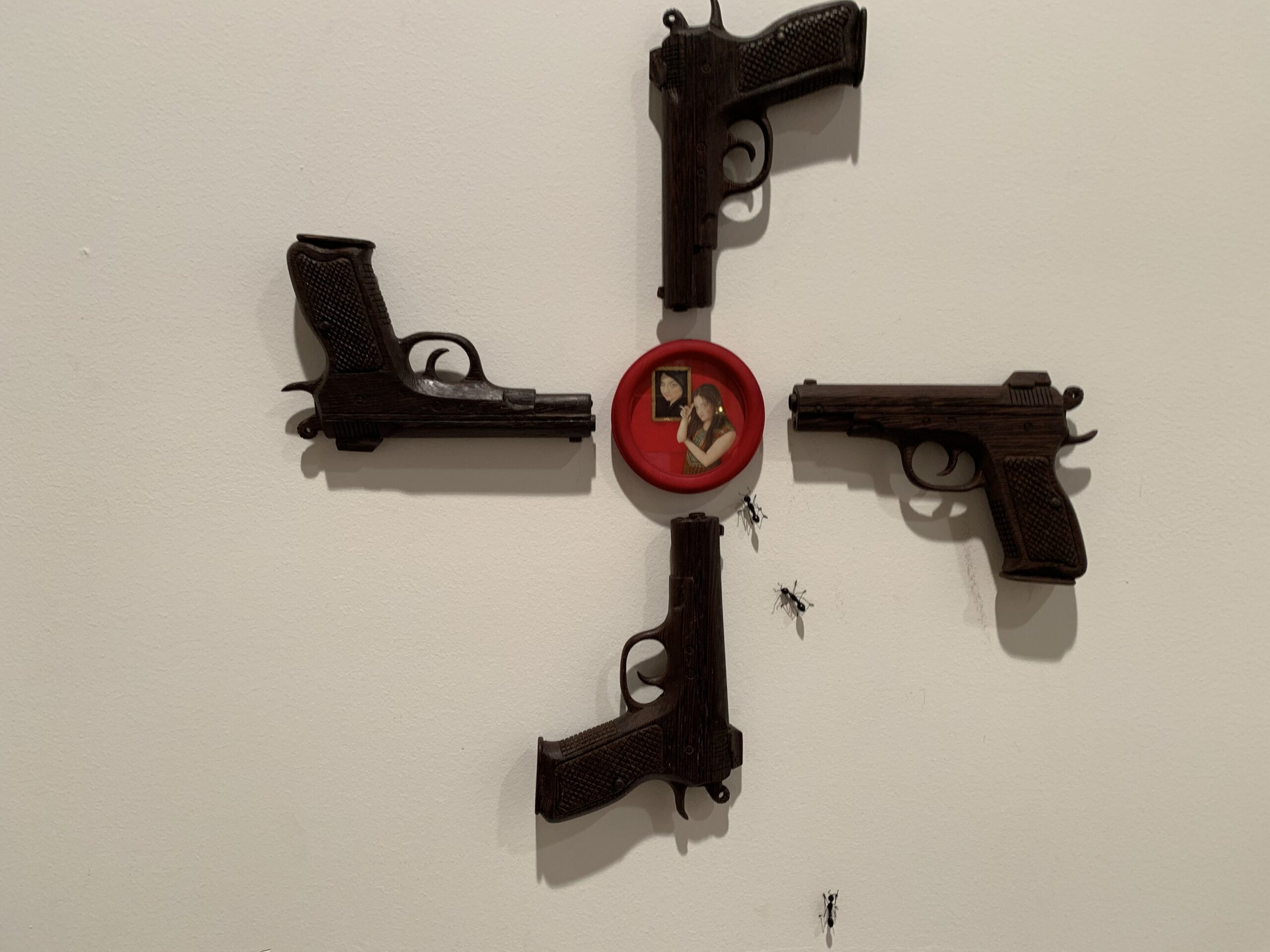

It is appropriate that as we celebrate Women’s Suffrage and remember all those who were not included, we also think about domestic violence and the trauma of family violations. As we dread the appointment of Amy Barrett, who will remove the right to abortion practically immediately, we grieve for the women who will suffer as a result.
Not to mention that suffrage itself is under attack on all fronts by the desperate right wing.
I hope we have a landslide, but that won’t undo the damage already done to the environment, to women, to our social fabric which is being ravaged by the virus.
As we head into the dark winter, it is crucial that we find a way forward to be actively resisting darkness on all sides.
This entry was posted on October 22, 2020 and is filed under African American history, Art and Politics Now, art criticism, Black Art, Carletta Carrington Wilson, Feminism, Uncategorized.
Take a Stand: Art Against Hate: The New Raven Anthology
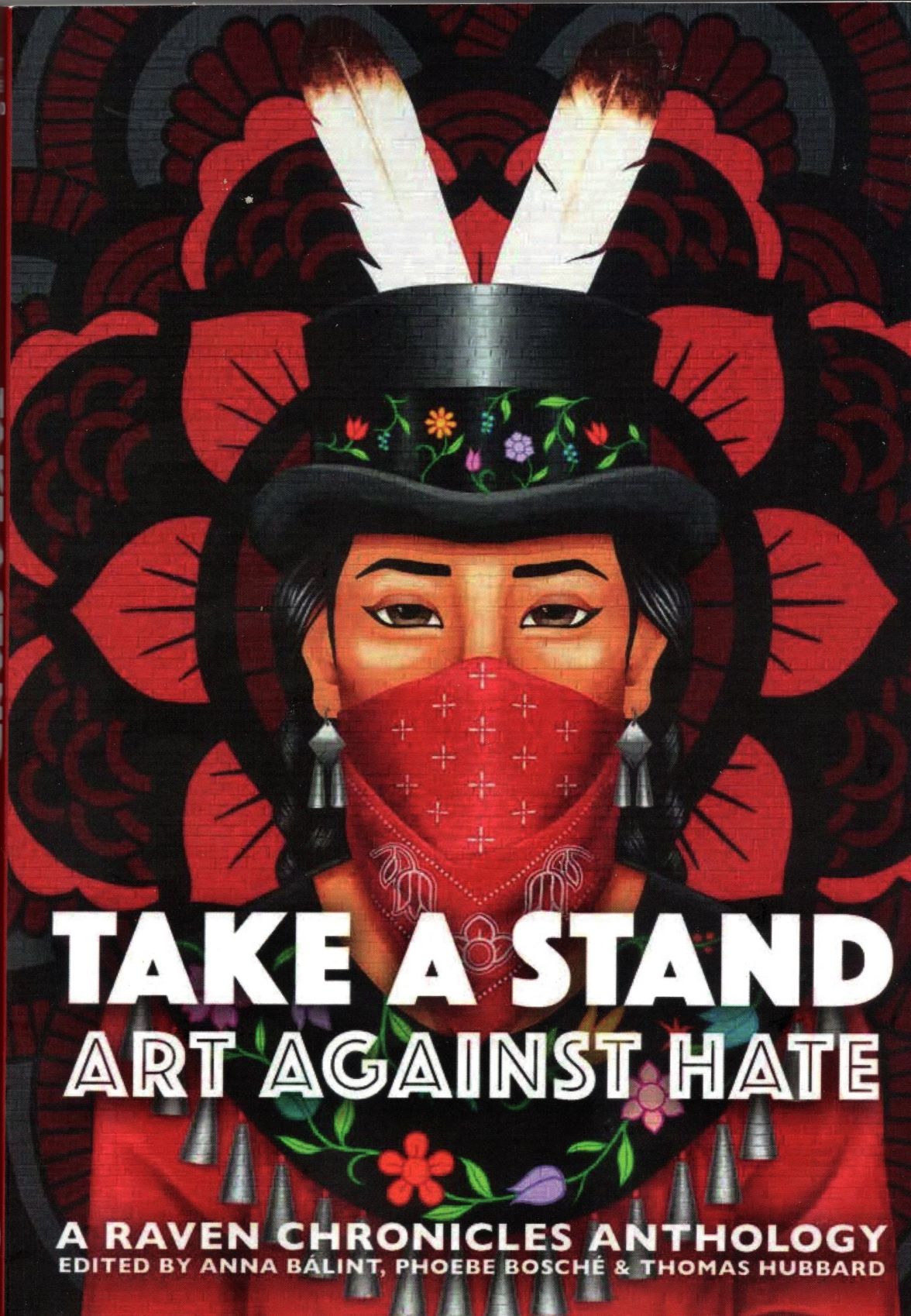
Raven Chronicles Press, for those not familiar with this important Seattle-based literary project, began in 1991. The amazing Phoebe Bosché has been the editor of Raven Chronicles Press and published a regular magazine for many years, but she now focuses on anthologies. These provocative collections of visual art, poetry, fiction, and non-fiction bring together writers with many voices. I treasure and constantly re-read these books. They are not books that you read cover to cover, but books for when you have a few minutes, or half an hour, and you feel like expanding your focus, certainly crucial at the moment.

Take A Stand, Art Against Hate first stuns us with its cover: a detail from a mural, a collaboration between AICHO (American Indian Community Housing Organization), Honor the Earth, a nonprofit environmental organization, and Mayan artist Votan, with the assistance of Derek Brown of the Dine’ or Navajo tribe, and members of the community. Ganawenjiige Onigam (Caring for Duluth in the Ojibwe language): A New Symbol of Resilience in Duluth, Minnesota, is a declaration of the issues facing Native American women such as violence, sex trafficking, and environmental racism. Primarily, however, the enormous portrait of an Ojibwe woman is a symbol of resilience, the bandana covering the woman’s face is a reference to women who participated in the Zapatista uprising in the Mexican state of Chiapas in 1994, as well as the water protectors at Standing Rock. The jingle dress worn by the woman in the mural has special significance to Ojibwe people. A woman dancing in her jingle dress is thought to possess great powers to heal.
But on to the anthology itself divided into five sections, “Legacies,” “We Are Here,” “Why?,” “Evidence,” and “Resistance.” As one of the editors points out, some works could be in more than one section, and in each section the anthology sets up a type of call and response between the different voices.
Before each section are often five separate quotes from major thinkers like James Baldwin, Adrienne Rich, Arundhati Roy, Joy Harjo, and Sandra Cisneros, to name a few.
The poems ( I can only give one example here of many) address subjects such as historical colonialism (“Love Letters in a Time of Settler Colonialism” by Tanaya Winder), slavery (“slaveships” by Lucille Clifton), current police violence, (“The Day John Coltrane Died, July 17, 1967” by Frank Rossini, a poem about Eric Garner), homelessness, (“Lower Queen Anne” by Thomas Hubbard), immigration (“Journeys” by Anna Bálint), climate crises (“The Continent of Plastic” by Judith Roche).
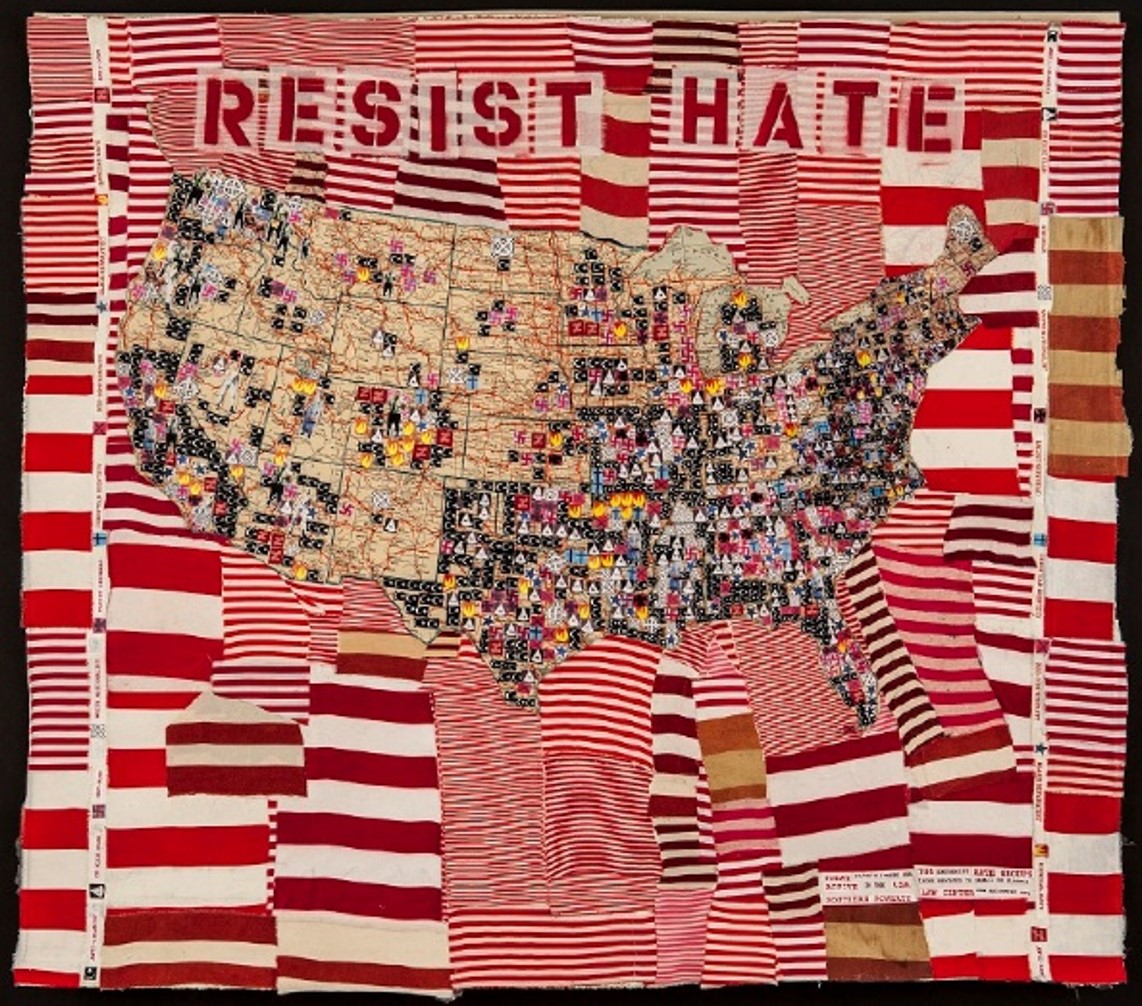
Deborah Faye Lawrence Resist Hate Map 2015
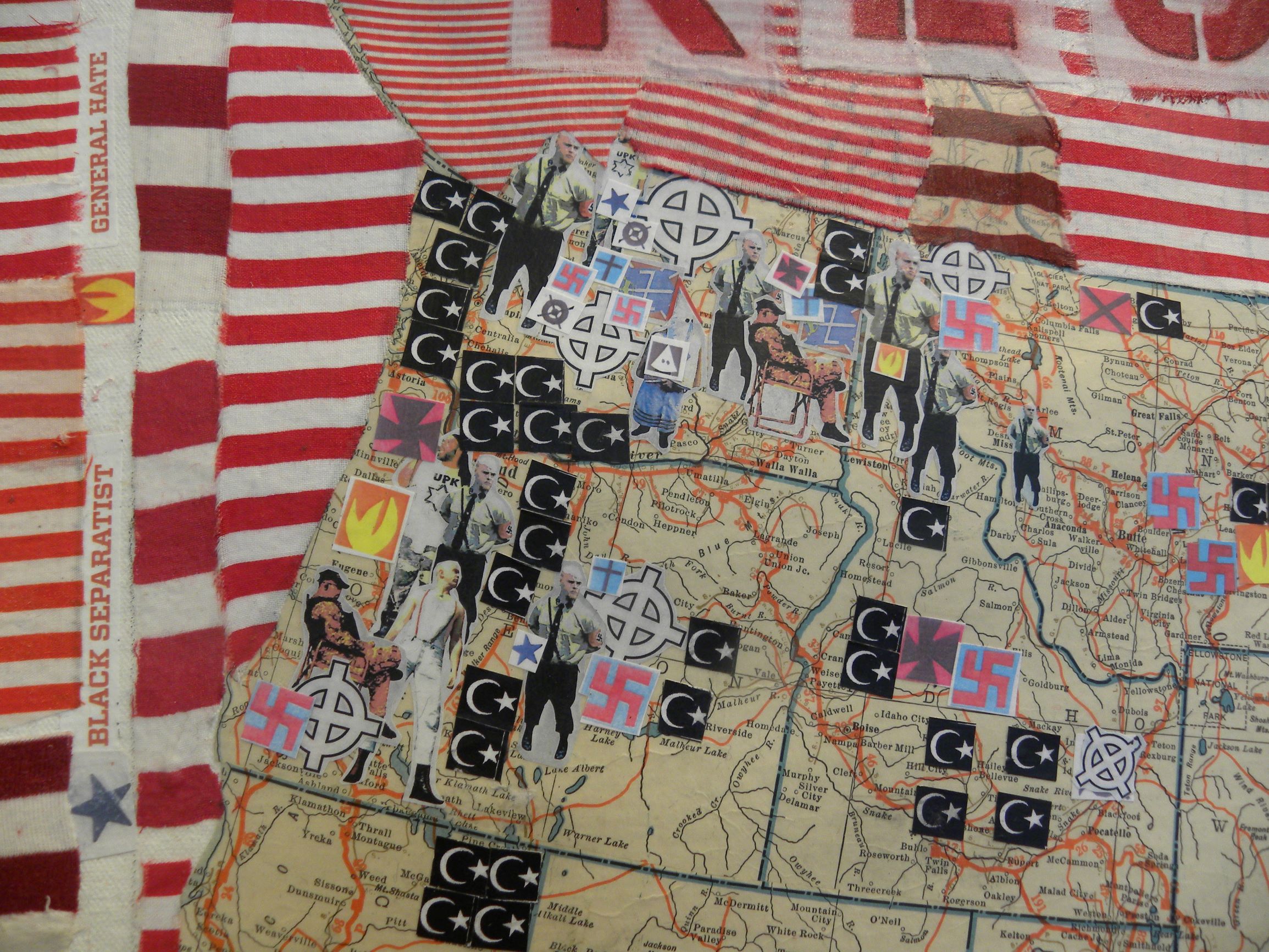
Detail of the Northwest
Interspersed throughout the book are artworks, some by familiar artists, Alfredo Arreguín, Deborah Faye Lawrence, Tatiana Garmendia, Matika Wilbur, and an artist from Haida Gwaii, Michaela McGuire.

MIchaela McGuire 2012
As I read these poems and short essays, I had a feeling of connection, of community, of hope, in this time of such separation and difficulty. Knowing that this many creative people (53 artists and 117 writers) address the challenges we currently face is comforting and uplifting.
The anthology was completed before COVID and the huge BLM protests this summer. But we see the same conditions already in place. Eric Garner said “I can’t breathe” 11 times. Protests against racism have been going on for decades, with their roots in slavery, where this anthology begins. The planet has been deteriorating, but Rajiv Mohabir offers hope: “Why Whales Are Back in New York City”: “Our songs will pierce the dark / fathoms. Behold the miracle: / what was once lost / now leaps before you.
The final poem by Ellery Akers also suggests a way forward: “At Any Moment, There Could be a Swerve in a Different Direction”: “it sounds like the click of knitting needles as hundreds of thousands of women knit pink hats; / it looks like a coyote, crossing the freeway to go home. “
You can buy the anthology on their website
This anthology will have a virtual reading Thursday, October 8, 2020 at 7:30 PM – 9 PM. You can access it from this link.
This entry was posted on October 4, 2020 and is filed under Art and Politics Now.
Maya Lin’s Confluence Revisited 2020
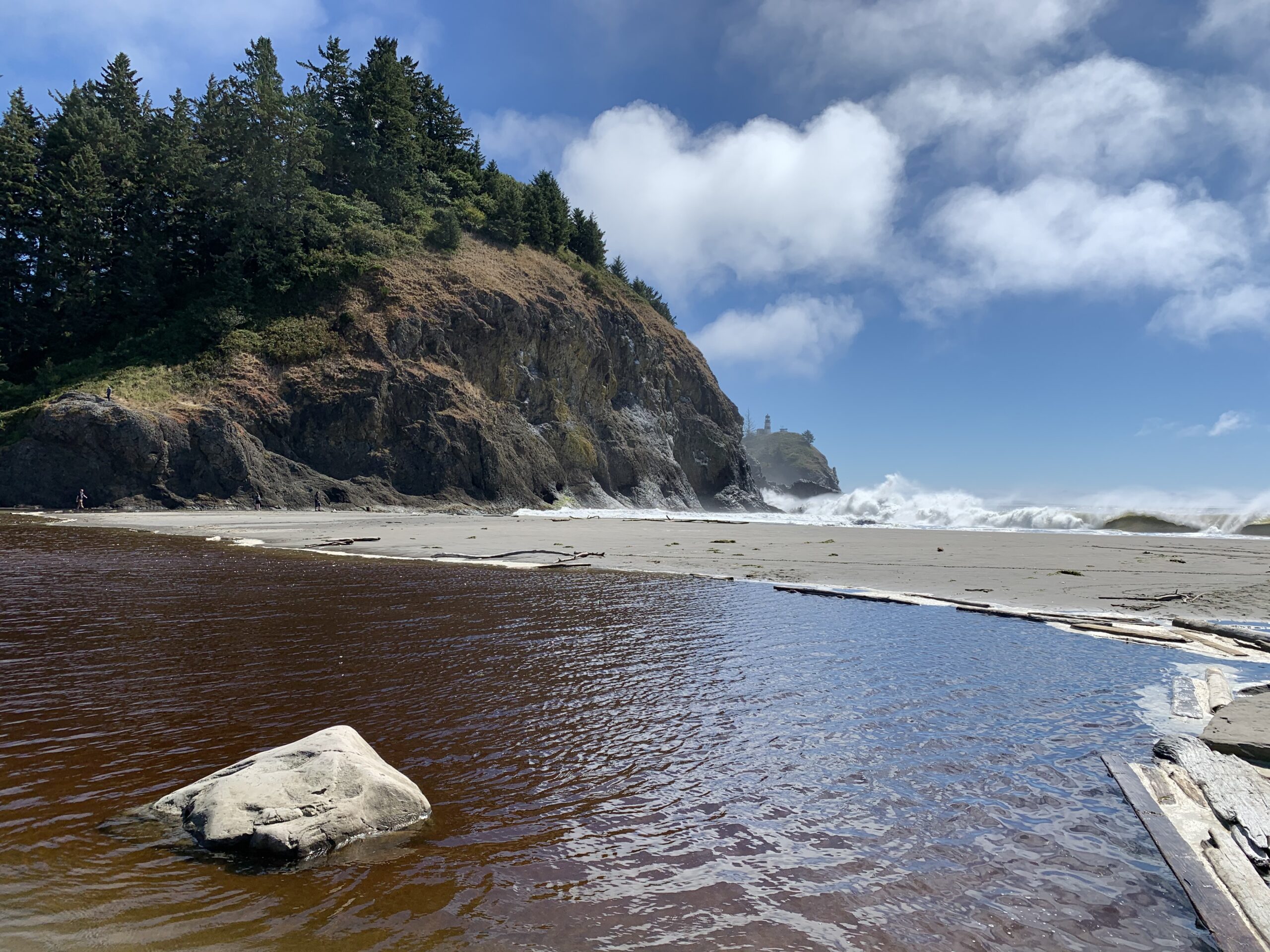
We revisited Cape Disappointment (it should have the native name of Cape Kais). This site marks the confluence of the Columbia River and the Pacific Ocean. It is one of the most rugged places to navigate on the planet. We saw the power of the currents as the Columbia River smashed into the Pacific Ocean. Out there in the background. Hard to catch the immense drama.

For those of you unfamiliar with The Confluence Project, this is one site of six ( five completed) along the Columbia River, celebrating and marking various aspects of native life and loss as well as using the Lewis and Clark journals to track extinctions since they came through in 1803-5. Maya Lin was lured into accepting this multi year commission by Native elders who saw the movie about Maya Lin’s memorial to the Vietnam war and believed she would be the perfect person to commemorate the native losses since Lewis and Lark came through.
I have blog posts about three of the other sites here and here.
and here.
Lin is particularly tracking extinctions, a project she began long ago. Here is her incredible website “What is Missing” about extinctions.
We were there in 2006 for the dedication at the completion of the
site, when Maya Lin was there with her family as well as the Chinook peoples both supporting and protesting.
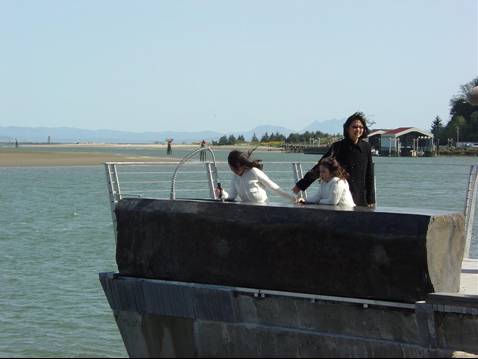
Maya Lin with her daughters at the cutting table 2006
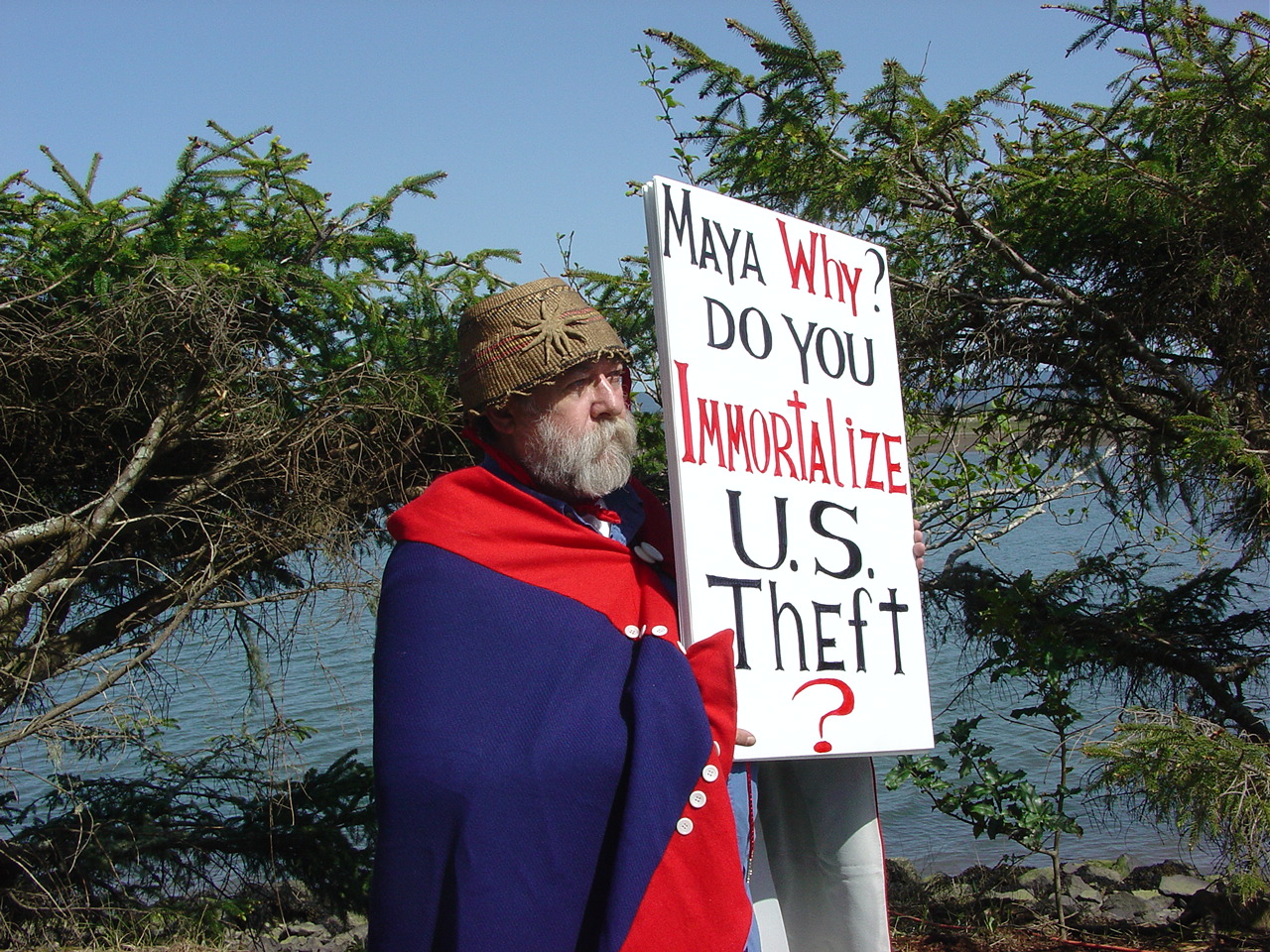

We went again in 2008 and camped in a tent. This year we stayed in a yurt.
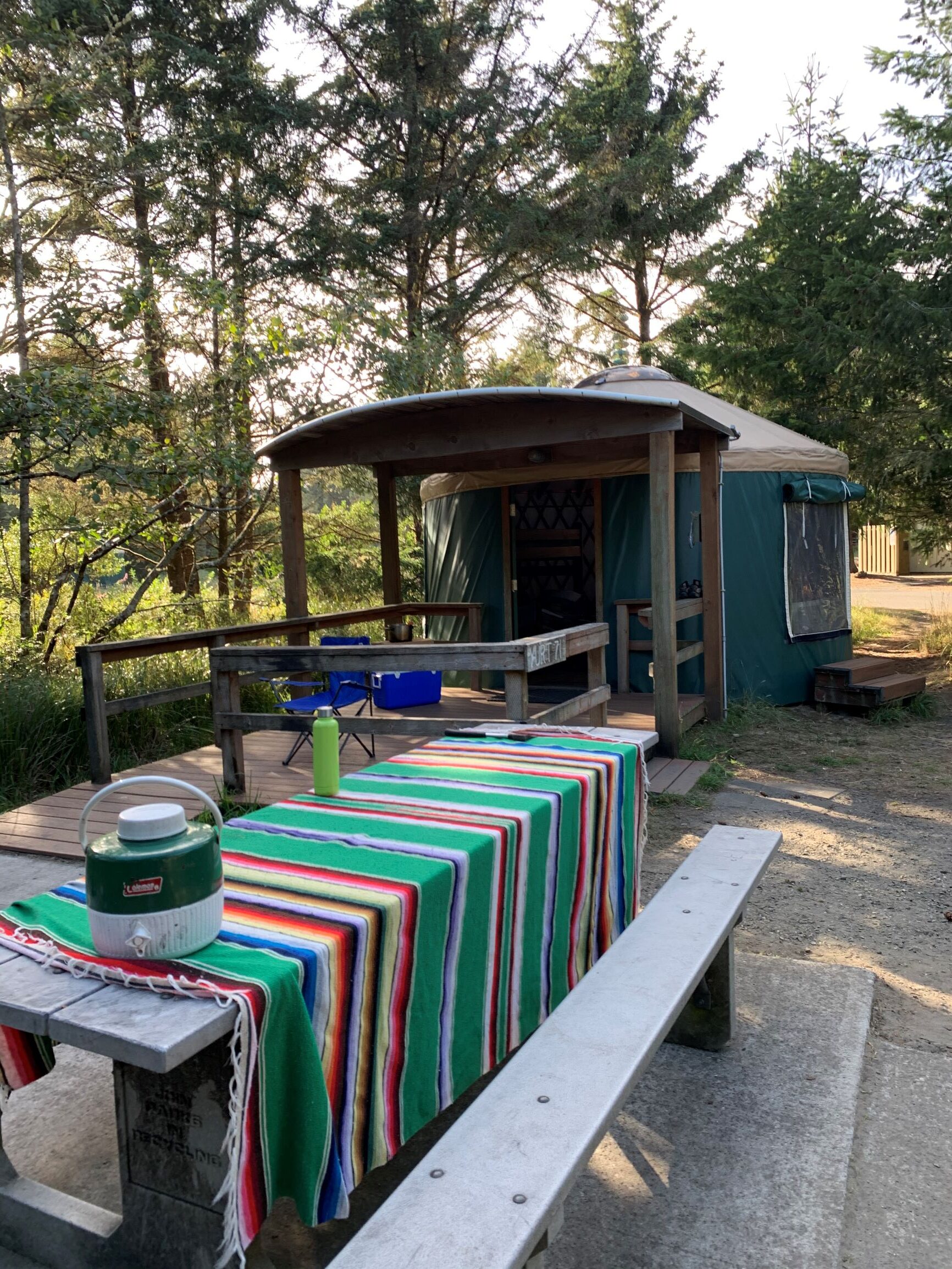
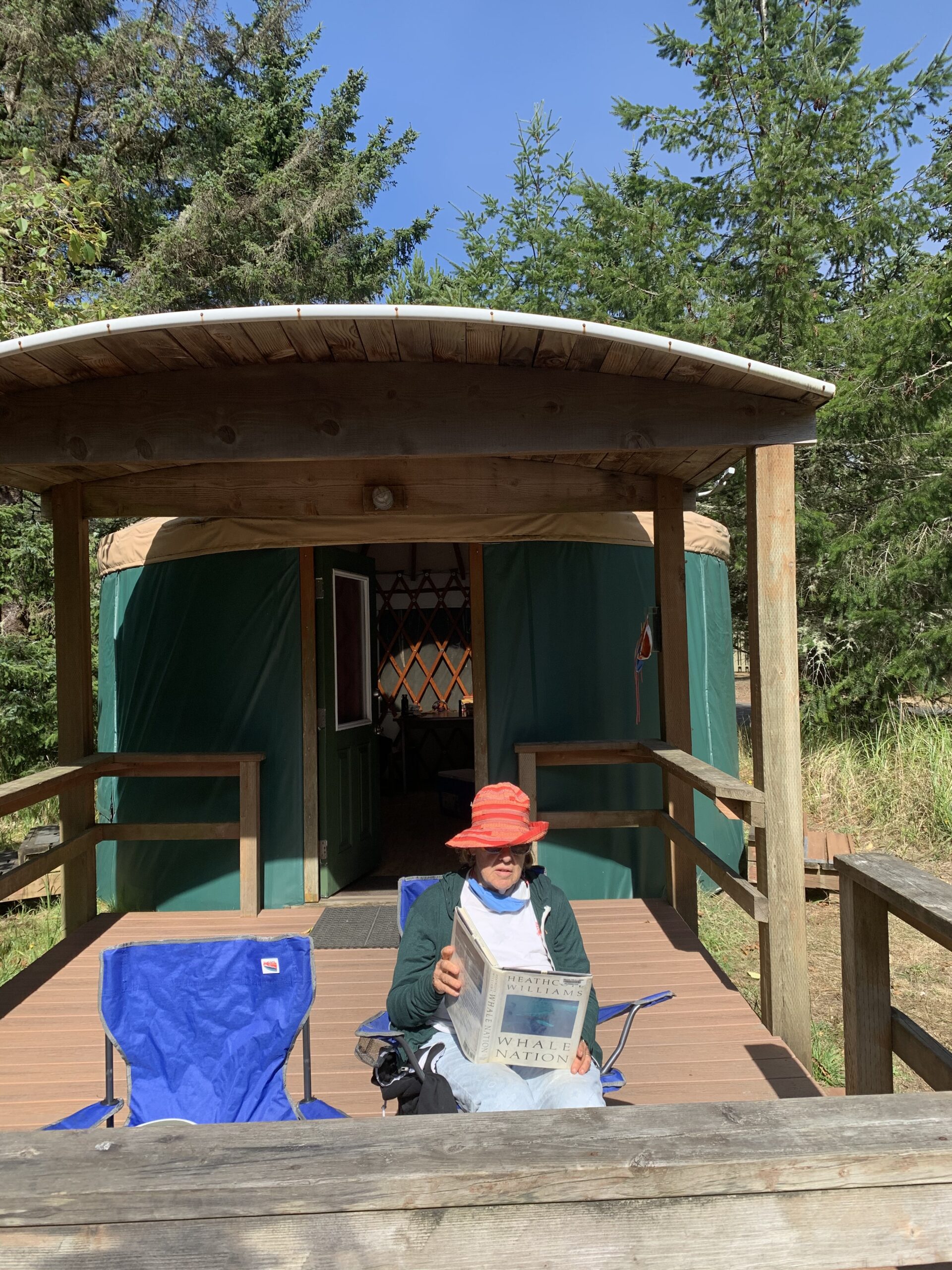
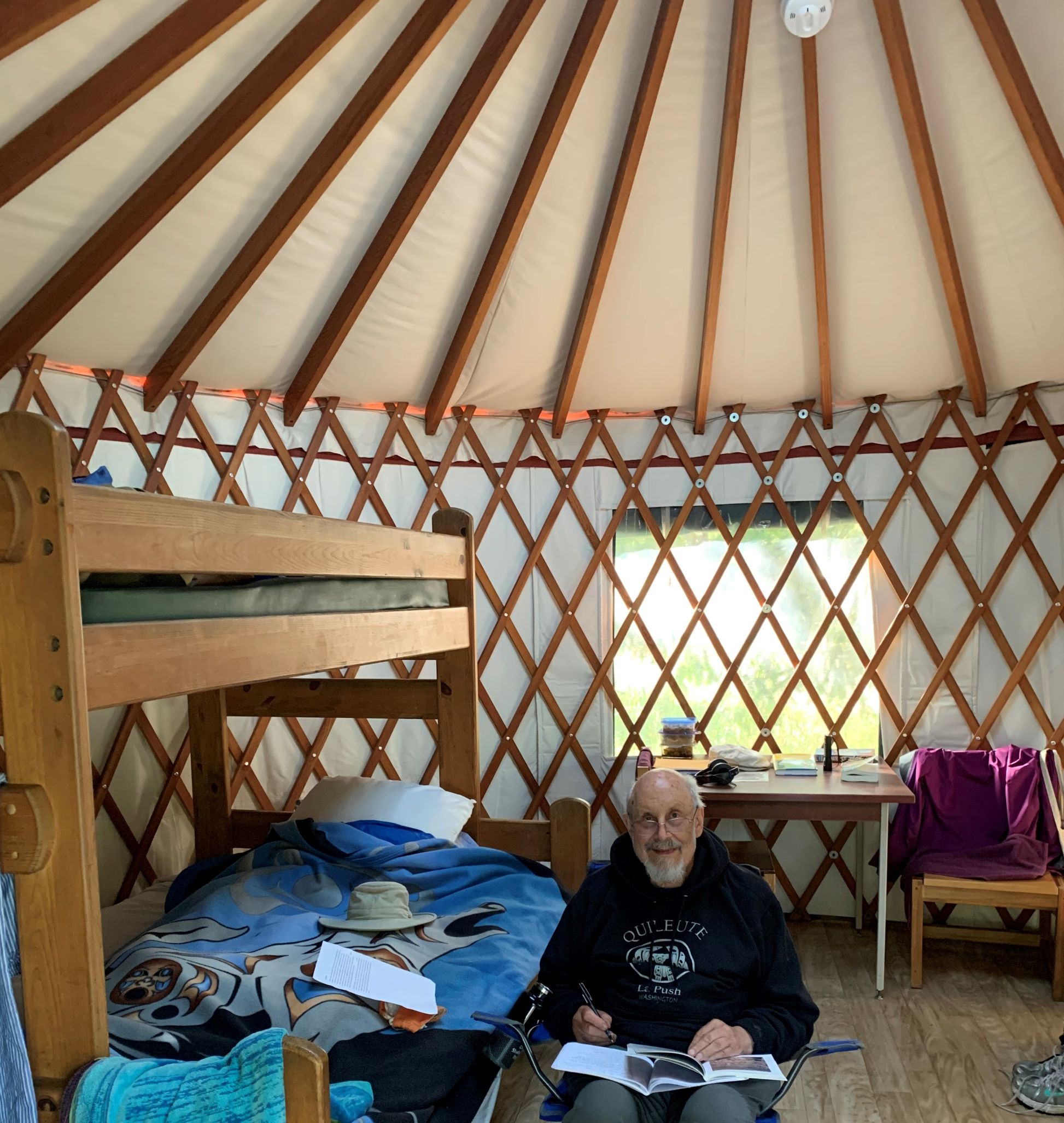
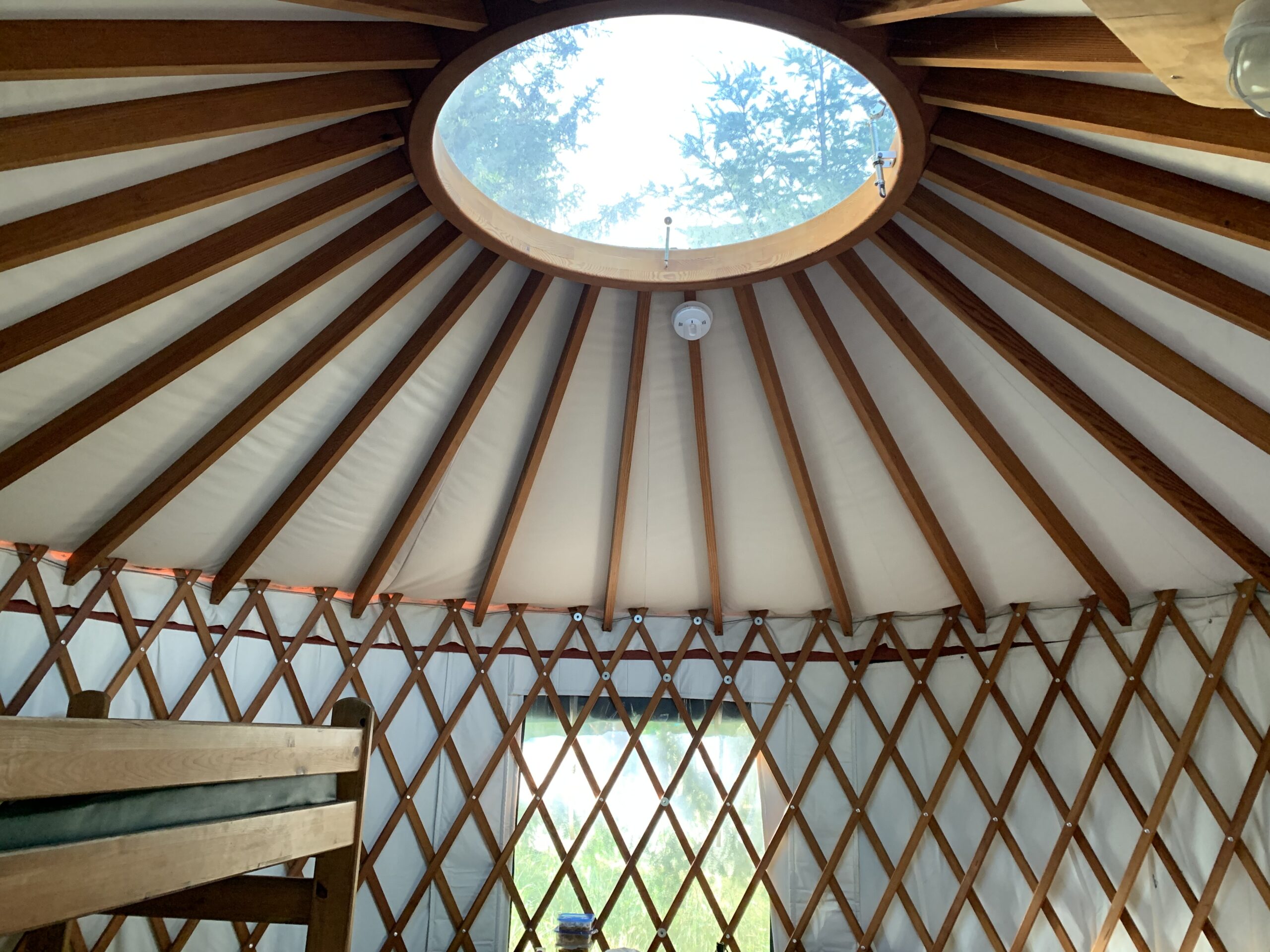
The site has now filled with grasses and trees where before there was empty dirt, ( that was replacing parking lots and toilets). Maya Lin cleared the vista at so called Waikiki Beach and made it more natural.
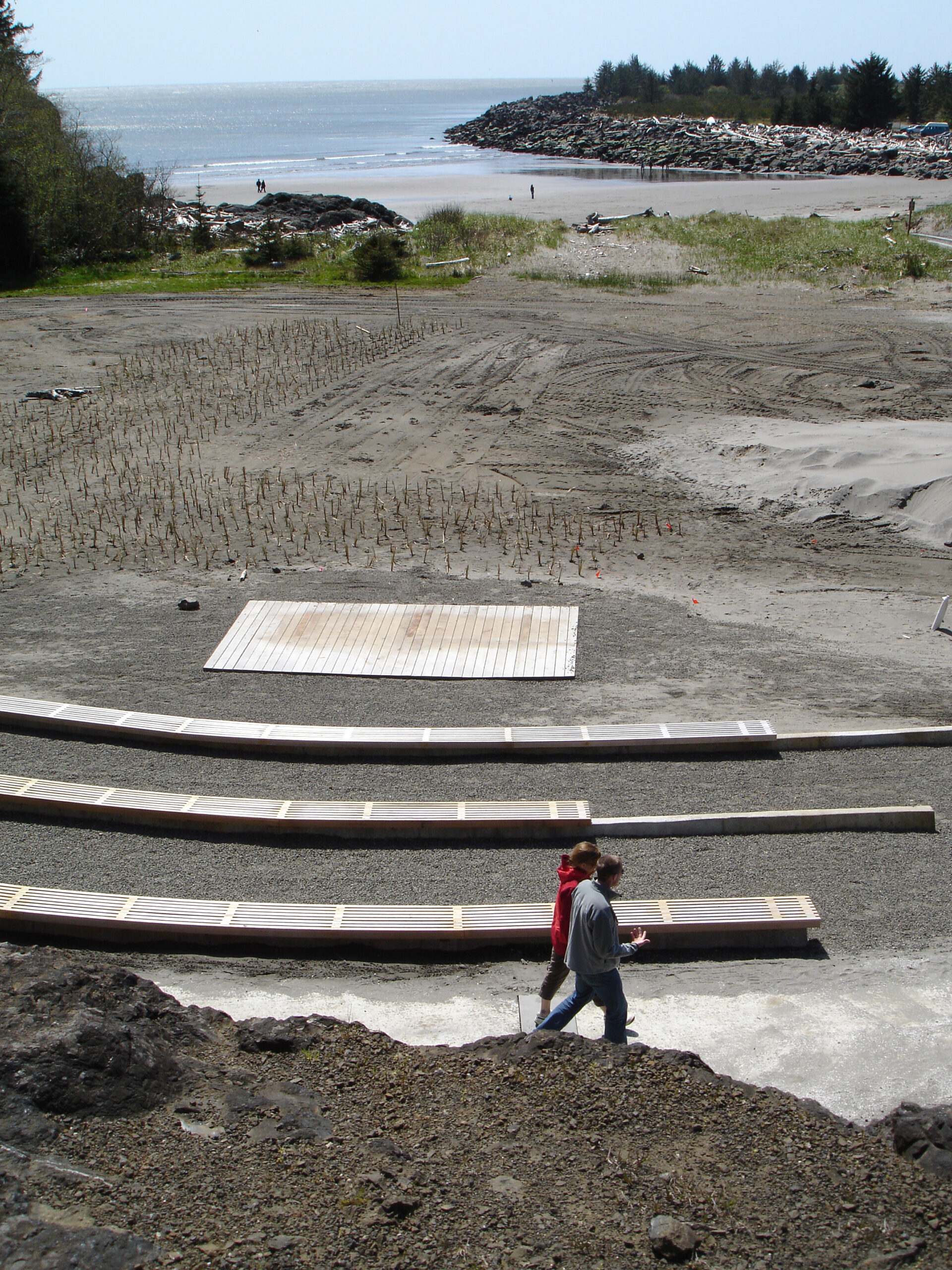
amphitheater in 2006 at time of dedicaiton
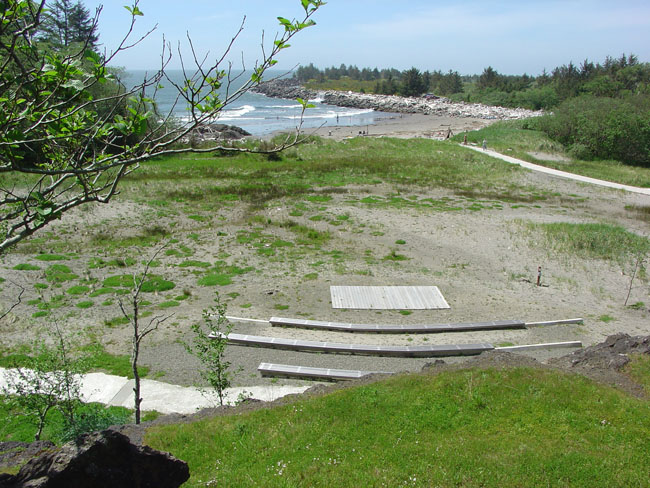
amphitheater 2008 some green has returned
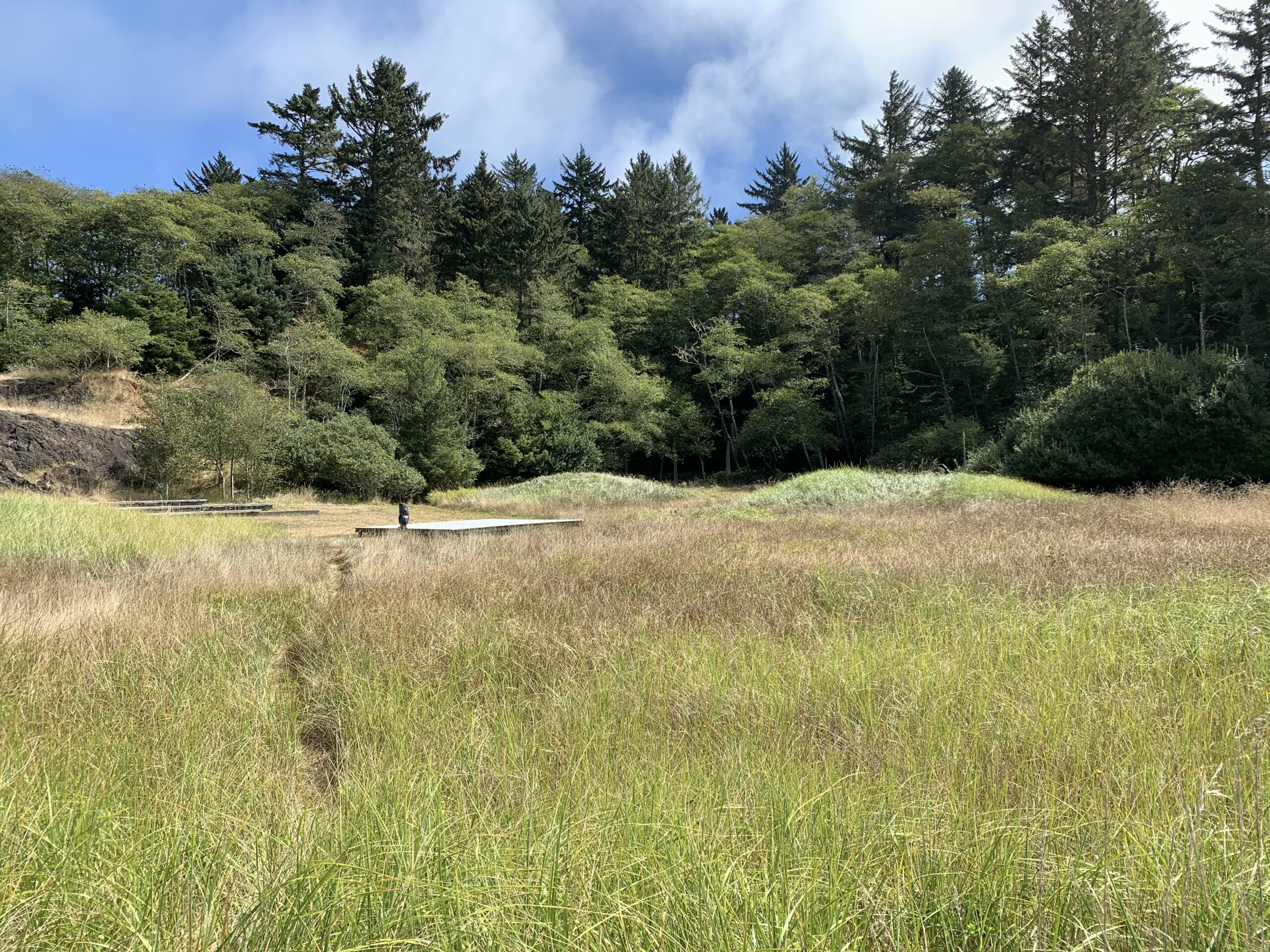
amphitheater 2020 Entirely grass filled field
When the Chinook peoples first dedicated the site before work began, they sang a beautiful song that so impressed the artist that she changed the design of the piece. Her original plan was to create concrete planks leading to the sea with inscriptions from the journals of Lewis and Clark documenting their measurements, names, and distances between places on the planks.
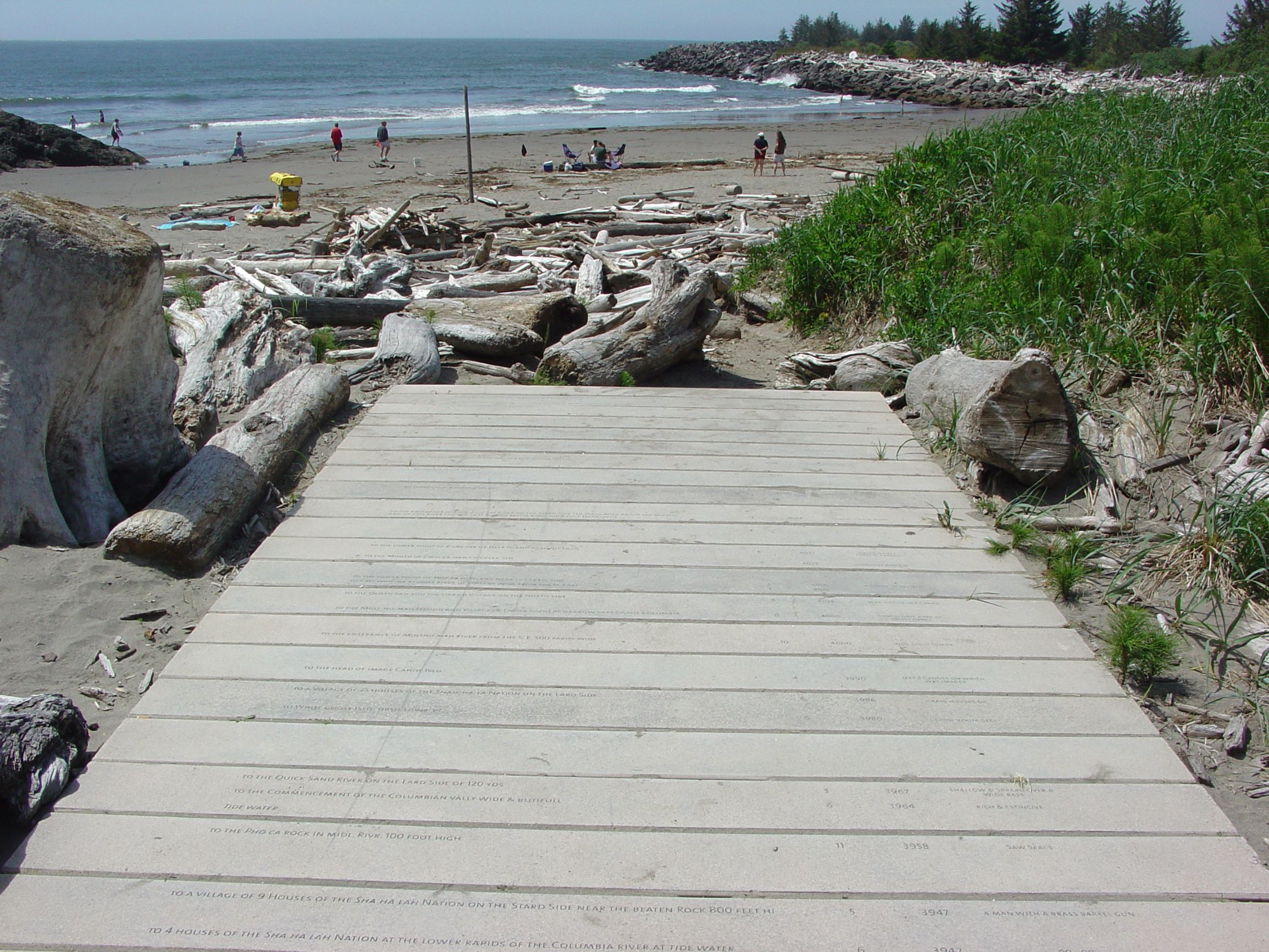
end of original walkway at Waikiki beach
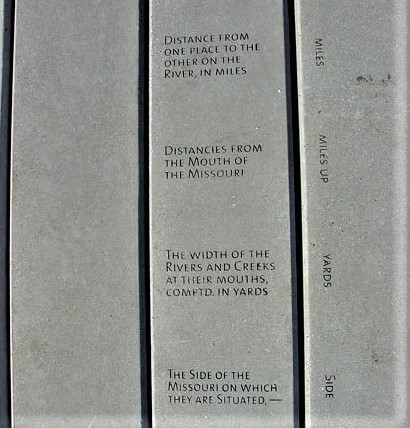
sample of texts by Lewis and Clark 2008 now 2020 almost entirely rubbed out
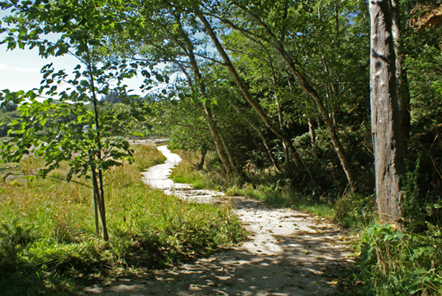
As a result of being overwhelmed by the beauty of the dedication song, she added a second path, a winding, oyster path. It also has planks, but much more subtle and spread out. That path marks the original shoreline before jetties were added to aid navigation and reduce ship wrecks.
The Chinook people’s prayer was
We call upon the earth our planet home
with its beautiful depths and soaring heights
its vitality and abundance of life
and together we ask that it
Teach Us and Show us the Way

We call upon the mountains
Saddle Mountain, and Wakiakun Mountain,
The Willapa Hills and the summits of intense silence
and we ask that they
Teach us and Show us the Way
We call upon the waters that rim the earth
the waters of our great Iyagatthlmath RIver
The waters of Willapa Bay and all the waters
the flowing of our rivers and dreams,
the water that falls upon us
And We ask that they
Teach Us and Show us the Way
We Call Upon the Land which grows our food
The Nurturing Soil that Sustains our Lives
And we ask that it
Teach us and Show us the Way
We call upon the creatures of the Fields and
Forests and the Seas,
To Teach Us and Show us the Way
We call upon the great cedar trees
Reaching strongly to the sky with earth in their roots
and the heavens in their branches
The Cedar tree, the keeper of all knowledge and
we ask them to teach us and show us the way
We call upon the creatures of the fields and the forests and the seas,
our brothers and sisters
Little Wolf, Mulak the Elk and Mawich the Deer
Ch’akch’ak the Eagle,
the Great Whales, and the Sturgeon, and the Salmon People
Who share our Chinook Waters
And we ask that they
Teach us and Show us the Way
We call upon all those who have lived on this earth
our ancestors and our friends
Who have dreamed the best for future generations
and upon whose lives our lives are built and with thanksgiving
we call upon them to
Teach Us and Show us the Way
And lastly we call upon all that we hold most sacred
the prescience and the power of the Great Spirit which flows through all the universe to be with us
To teach us and show us the way.
November 18, 2005
The winding prayer filled path leads to a Sacred Circle constructed of drift wood reinforced to stand up and the natural woods that have grown up around this amazing stump.
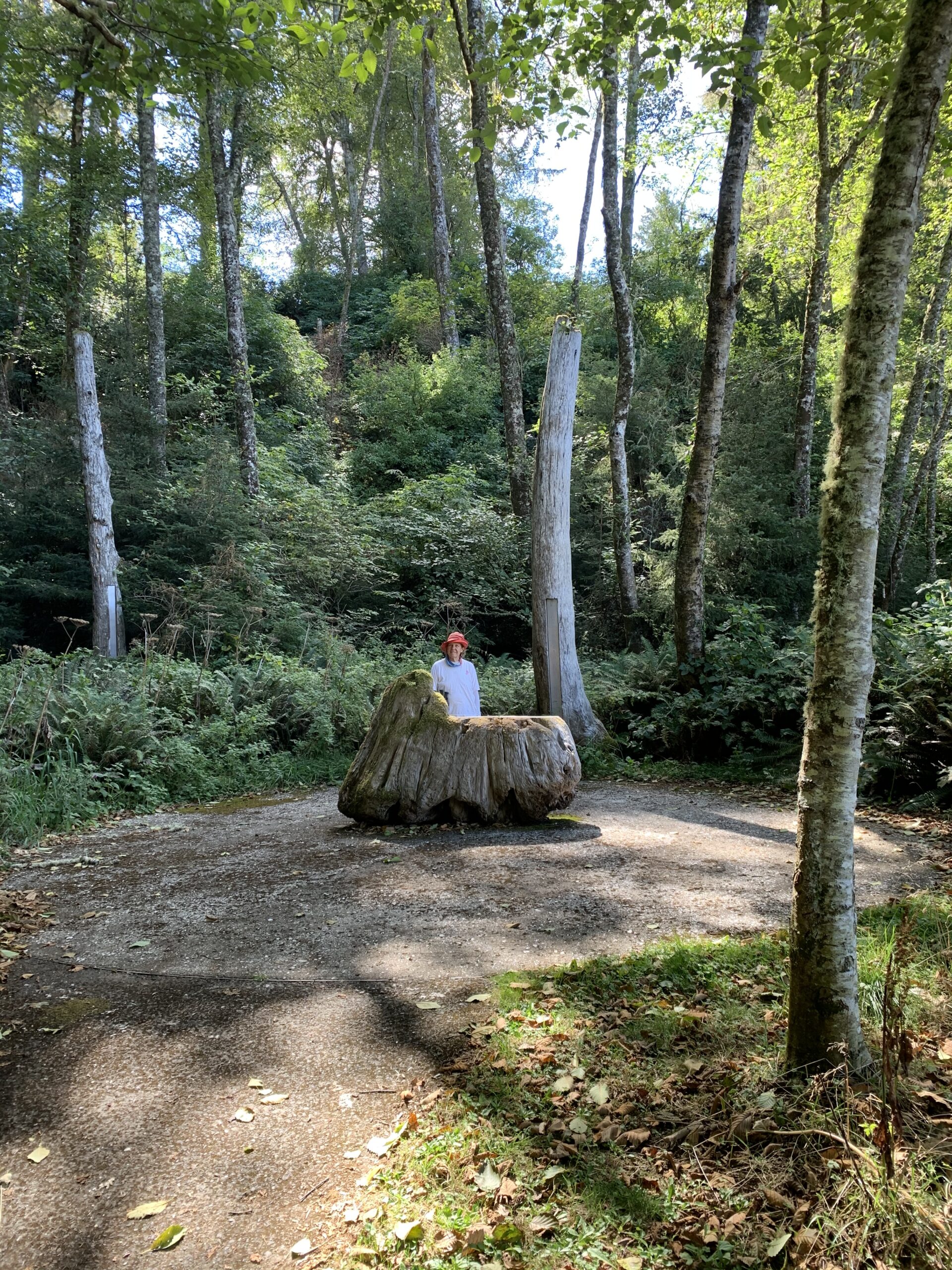
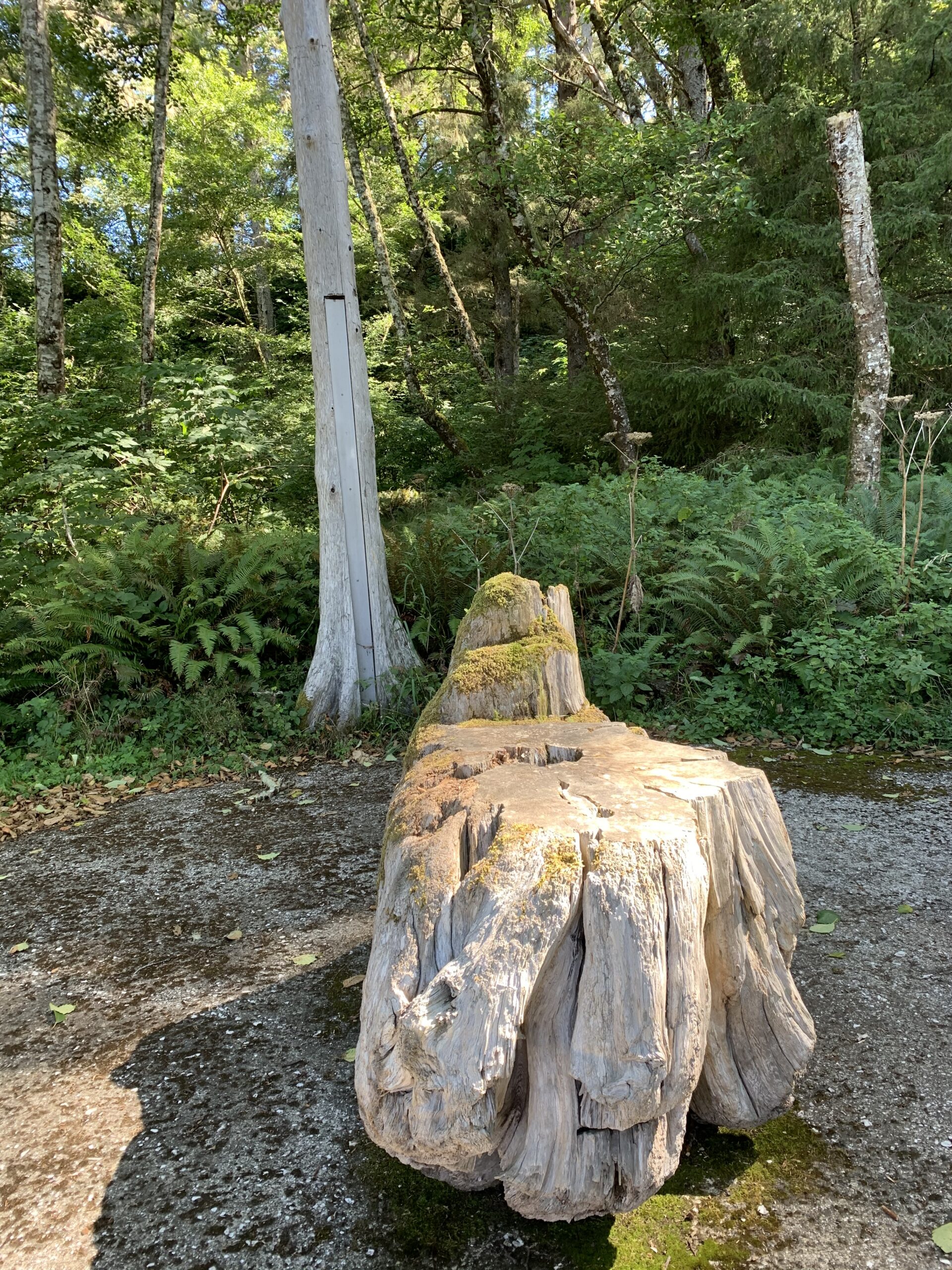
We need this prayer more than ever today!
We also visited the other parts of the Confluence installation at Cape Disappointment.
The Fish cutting table
It has a Chinook creation prayer incised on it about cutting the fish in the right direction in order to enable the creation of humans.
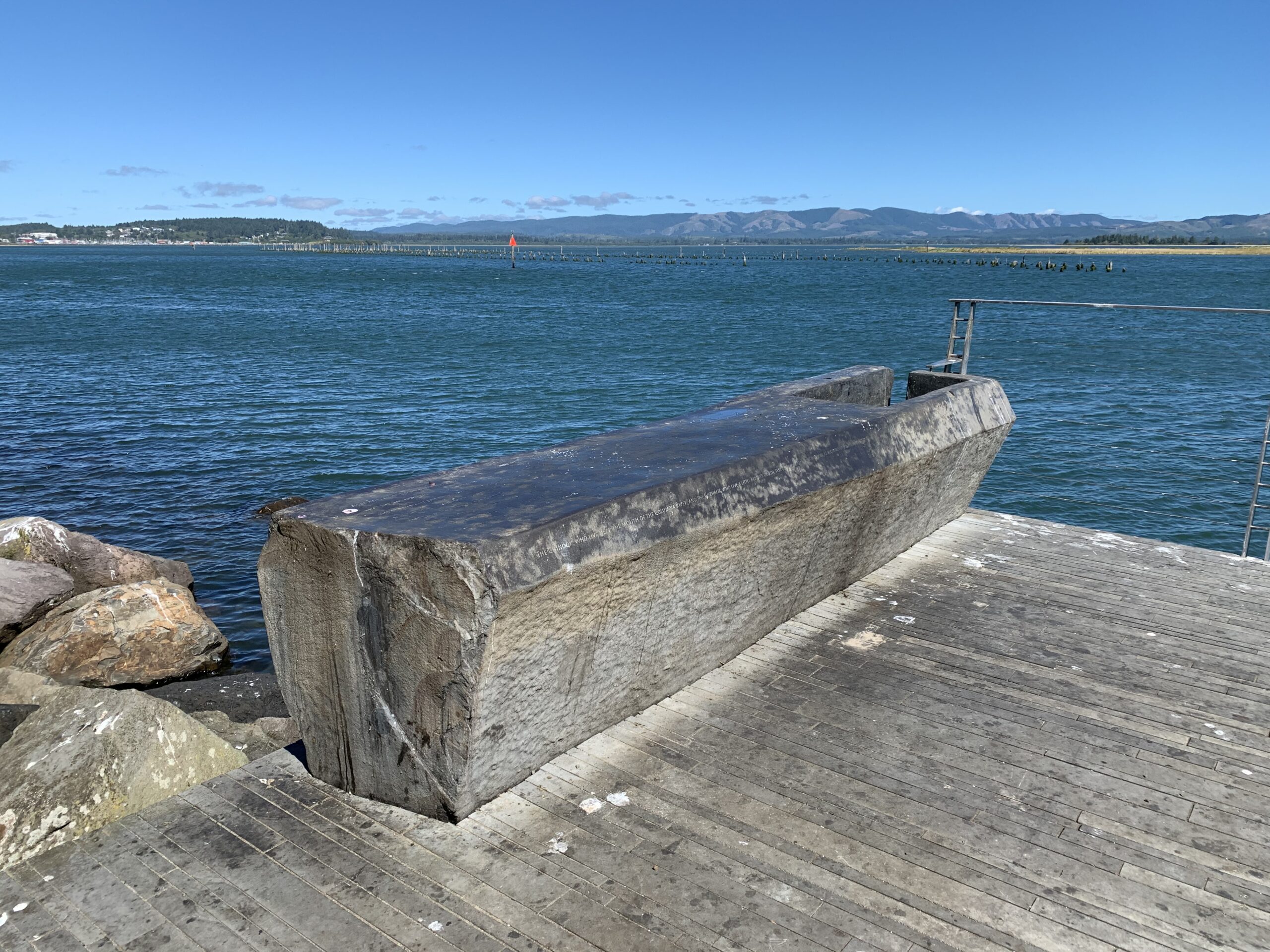
cutting table 2008
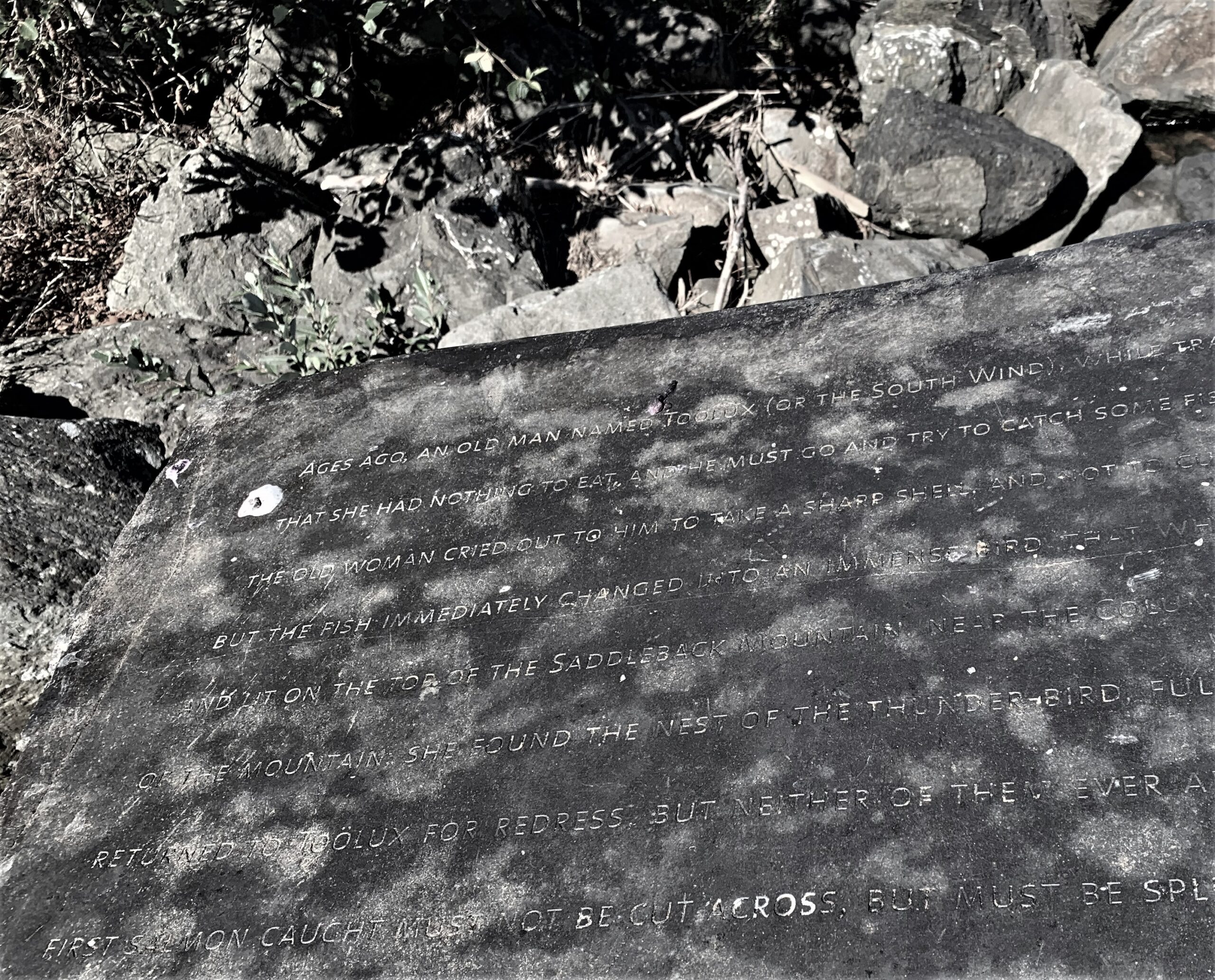
detail of creation prayer on fish cutting table 2020
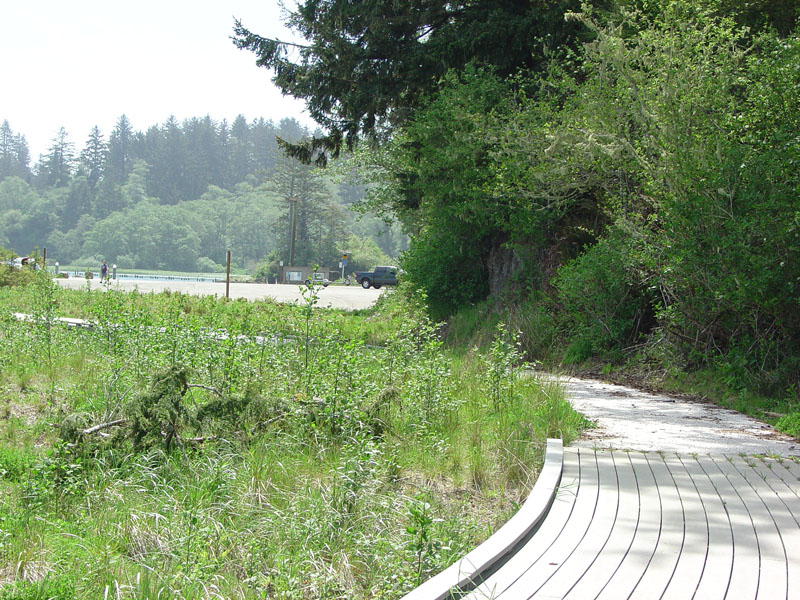
path to estuary 2008
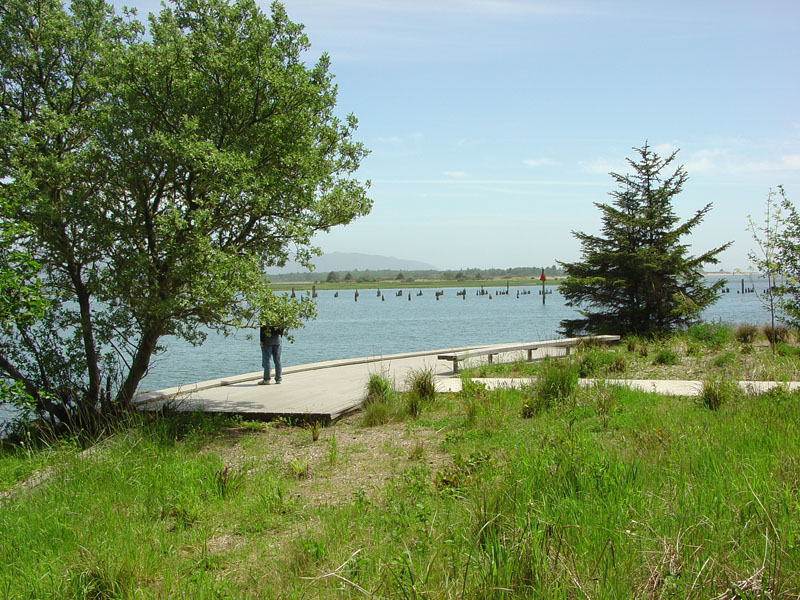
Estuary view 2008
and the view over the estuary, the path between them also grown up significantly.
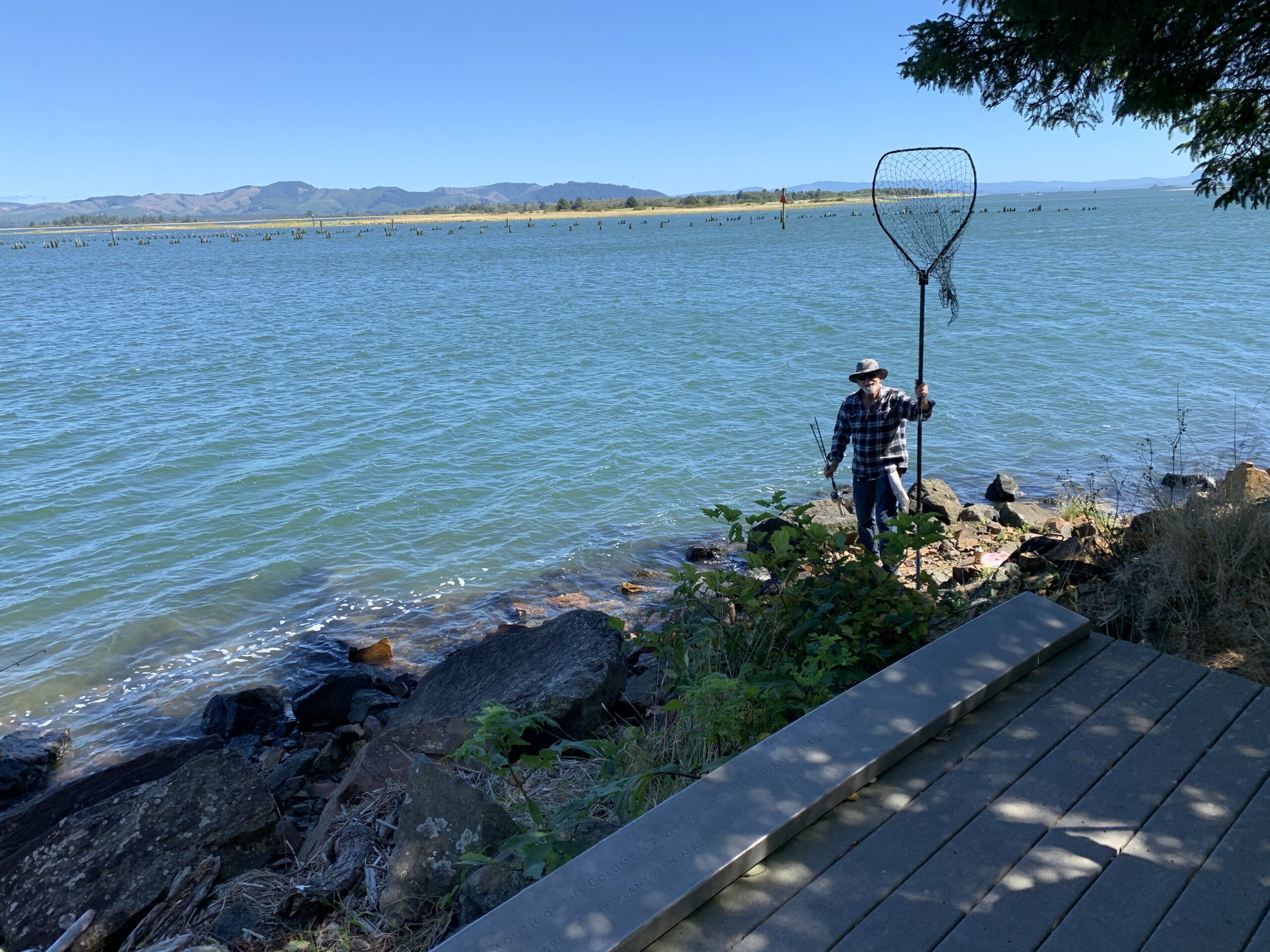
Estuary 2020
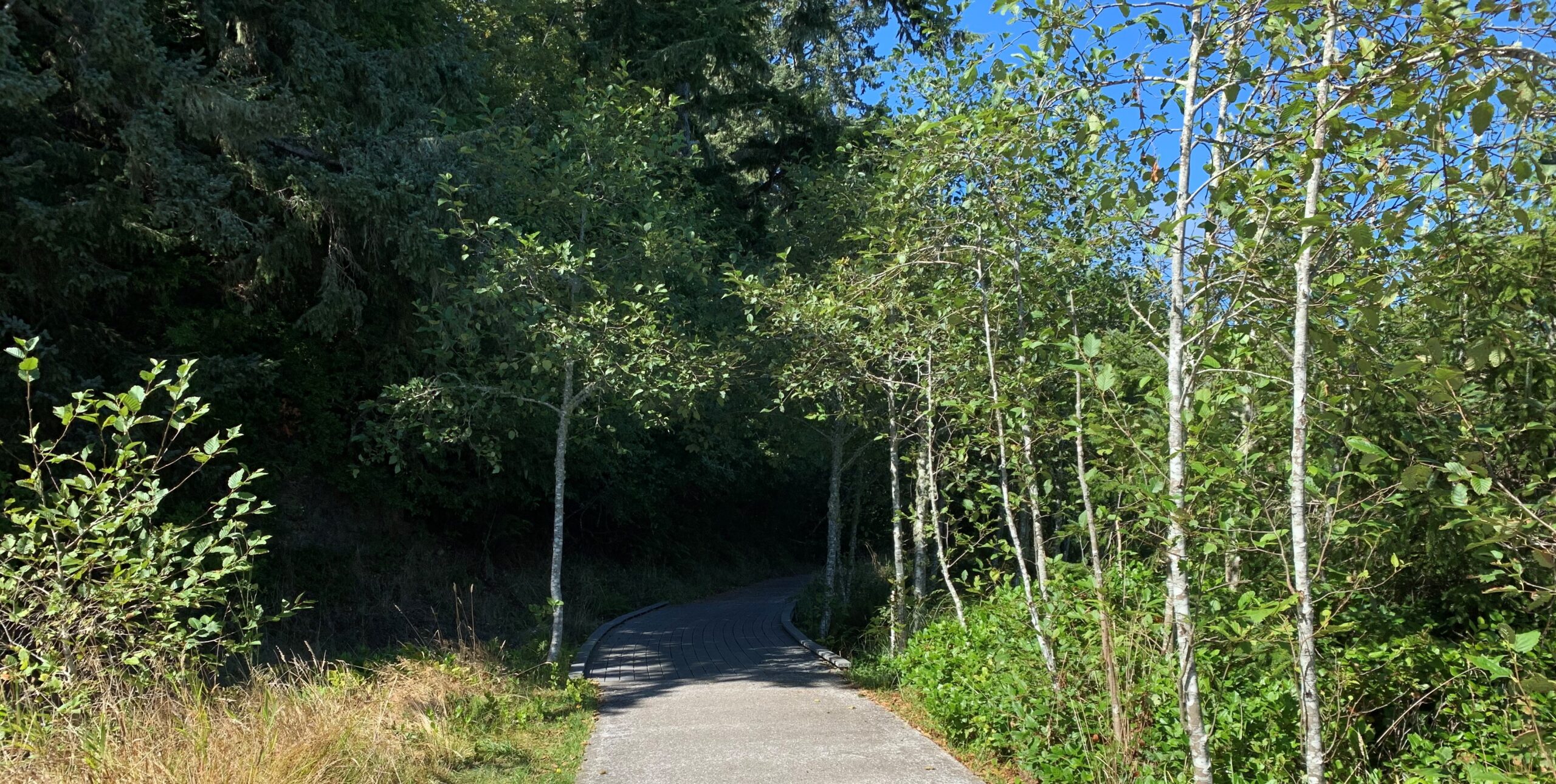
The path to the estuary with trees surrounding it 2020
This entry was posted on September 12, 2020 and is filed under a green future?, Art and Ecology, Uncategorized.
Climate Calamities and Mt Rainier (Tahoma)
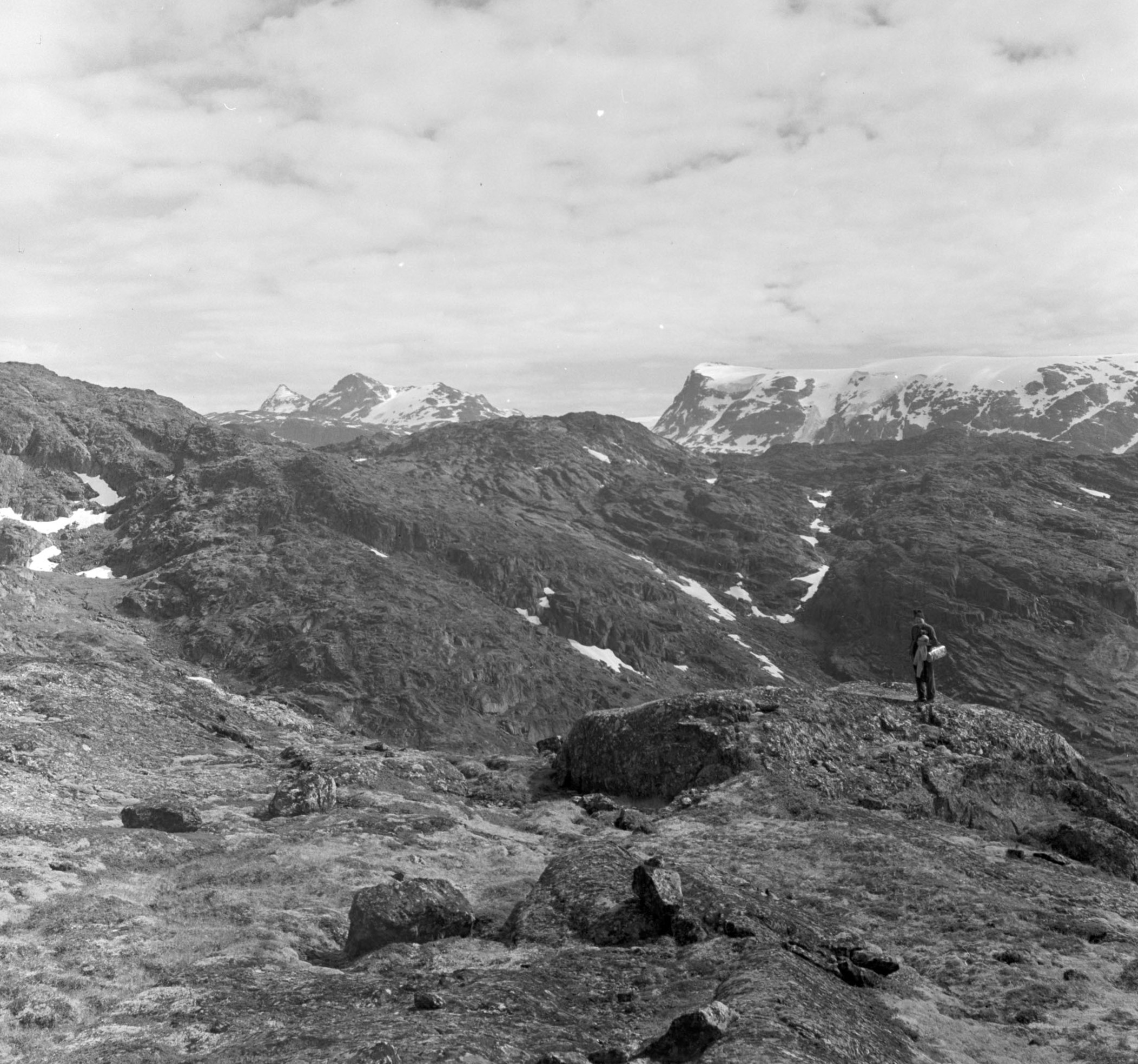
Rutherford Platt; Rutherford Platt standing on rocky landscape, heavy clouds above; Jul-54; image; cellulose acetate; 6 x 6cm (2 3/8 x 2 3/8 in.); North America
I wanted to announce the launching of my new website Climate Calamities.
I am inspired by two different impulses: my father Rutherford Platt’s career as a naturalist and explorer, particularly in the Arctic. His writings such as This Green World, Our Flowering World, and the River of Life, are filled with the wonder of nature. He was a self taught naturalist and his great desire was to share his knowledge with the general public. I deeply appreciate what he did and want to honor it on my new blog as a starting point.
The second impulse is, as seen in the name, the current situation for the planet.
I feel ever more urgently that we are looking at the end of life as we know it within the lifetimes of our grandchildren and maybe sooner. As I look at newborn babies, and then at the predictions for 2030 2040 I think of them as children and teenagers.
Today we are all suffering from the Covid 19 pandemic in many different ways, immediately, with death of family members, with the excruciating service of front line workers, of the anxiety about our own health, with fear for exposure, and fear of travel. And of course for parents there is a whole other layer of anxiety about their children, the schools, their future.
I see the virus and the spread of the virus as a manifestation of climate change: as we destroy animal habitats the viruses they carry will ever more frequently be passed to us. Many people say this is only the first pandemic and not the worst.
Recently I read Octavia Butler’s book Parable of a Sower, it is a dystopian view of the future ( set in 2025! written in 1993). I am planning to write about all the books I have been reading about climate change on my new blog.
Meanwhile we have the forest fire season, the virus, and the immediate opening or not opening of schools.
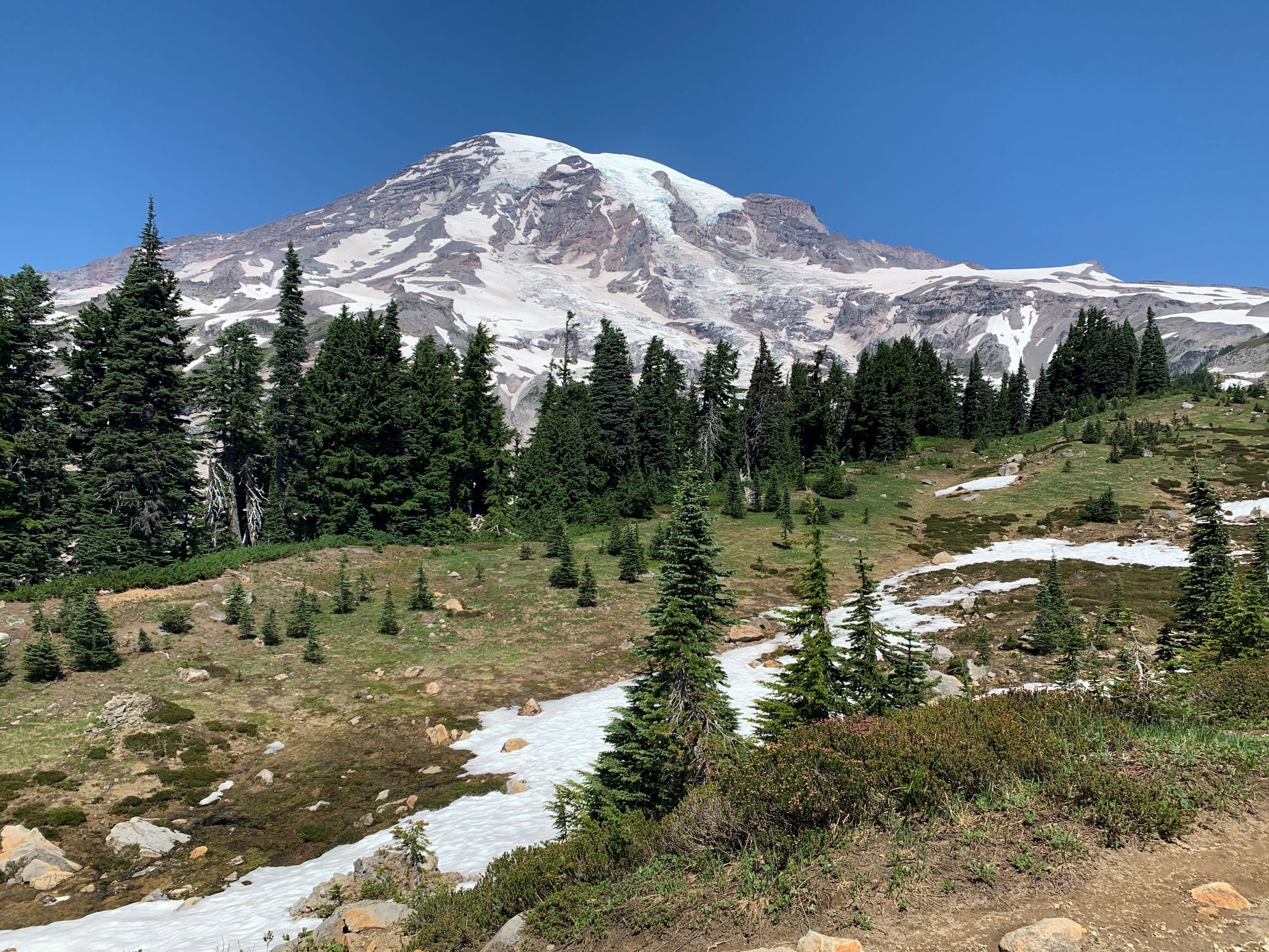
The book I am reading now follows my recent trip to Mt Rainier, TAHOMA AND ITS PEOPLE A Natural History of Mount Rainier National Park by Jeff Antonelis-Lapp
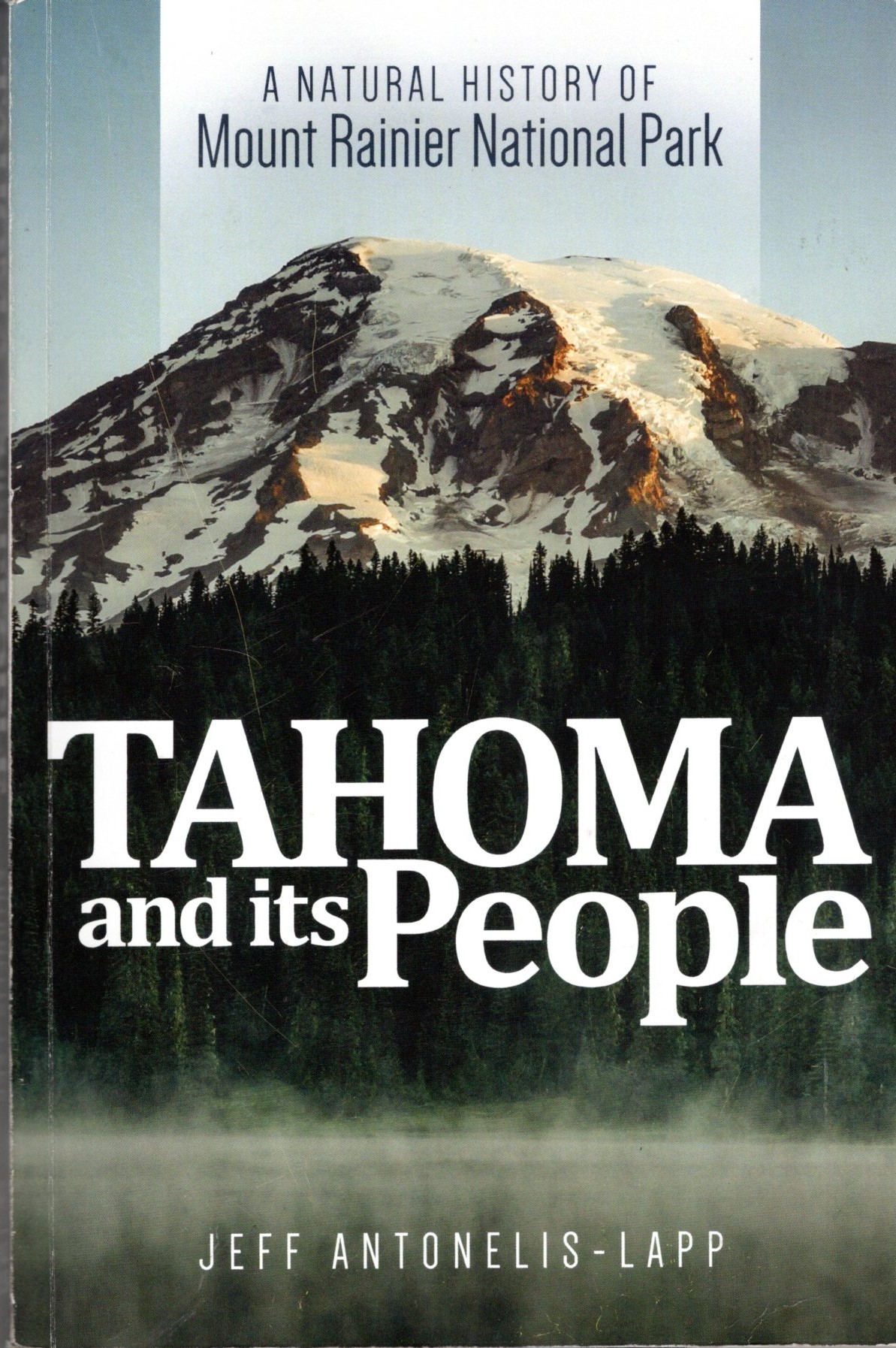
It has clarified for me exactly what I saw on the trip ( and didn’t see) as a result of the European races massive destruction of the ecosystems here in the Northwest starting in 1851. In such a short time we have destroyed ecosystems on an unimaginable scale.
The book elaborates on the glaciers ( I hadn’t realized that there are many different glaciers composing the mountain), the meadows, the trees, the wild flowers, the birds, the creatures, the water systems, and much more, all of them threatened, destroyed, or partially saved through massive efforts.
In particular the wildflowers we saw in the meadows had to be carefully re established and maintained! 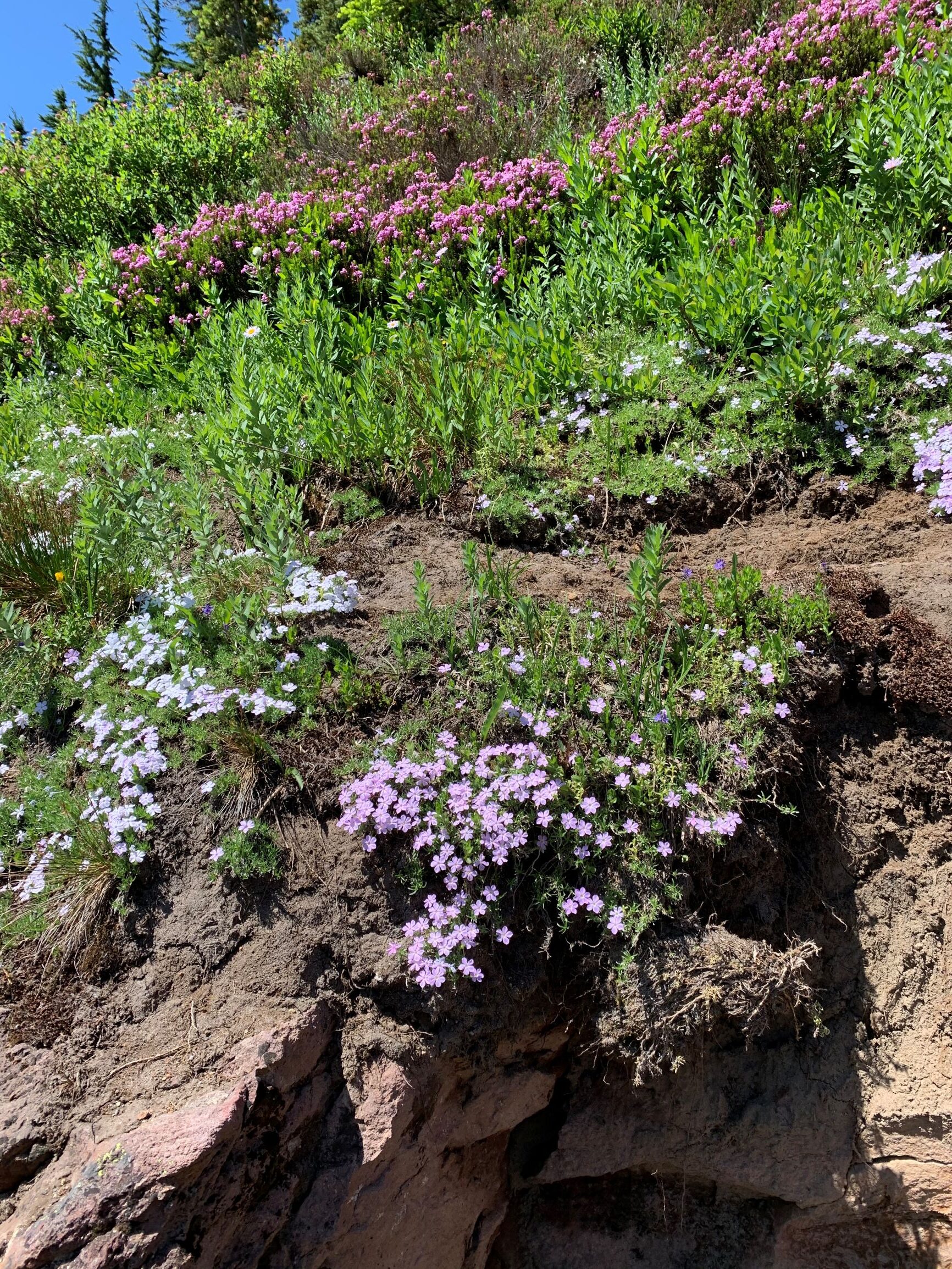
He also writes about the Nisqually River and its incredible lahars, outburst floods from the glacier.
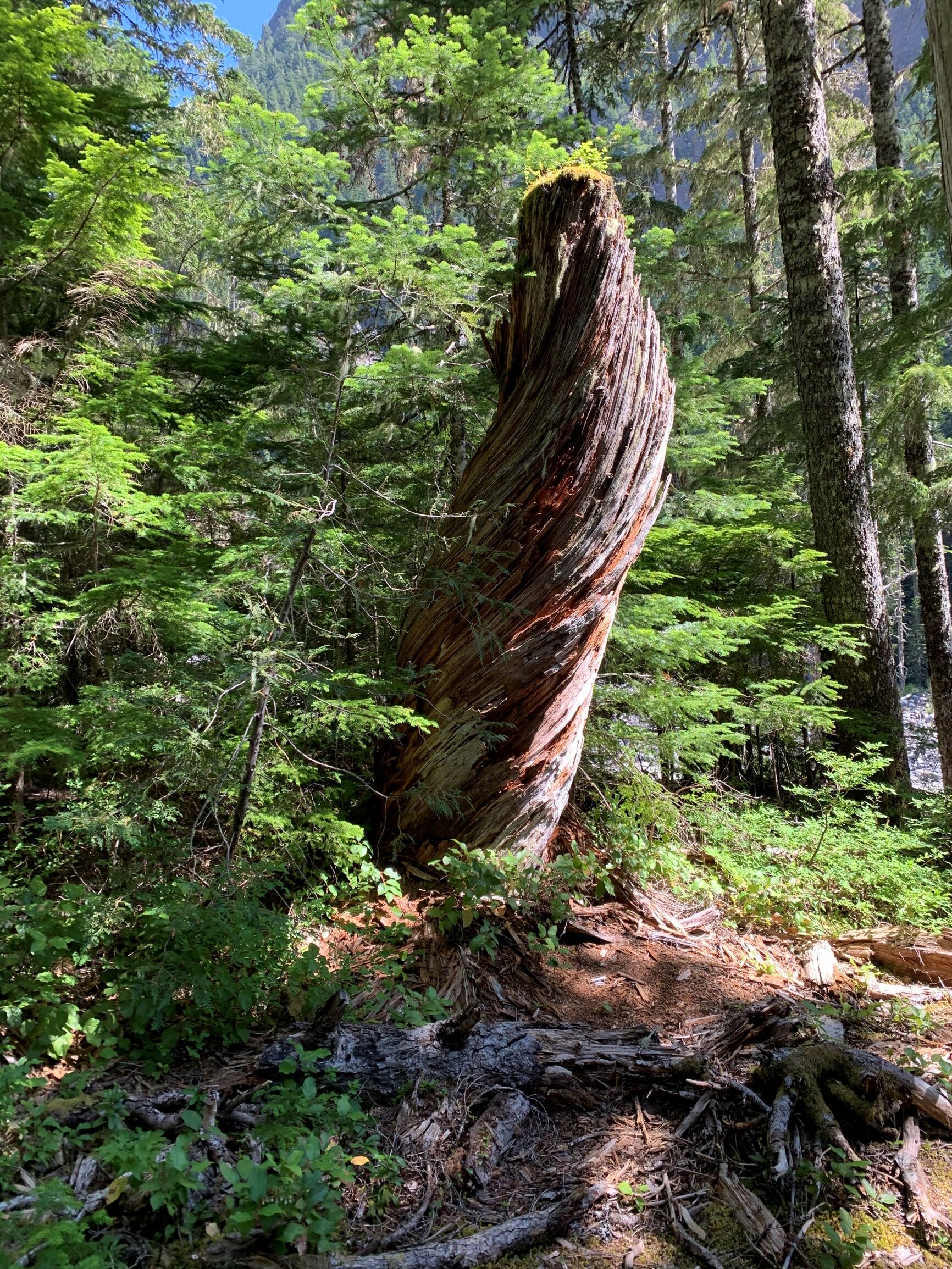
We were baffled by this twisted tree. A huge force led it to twist, or it grew that way?
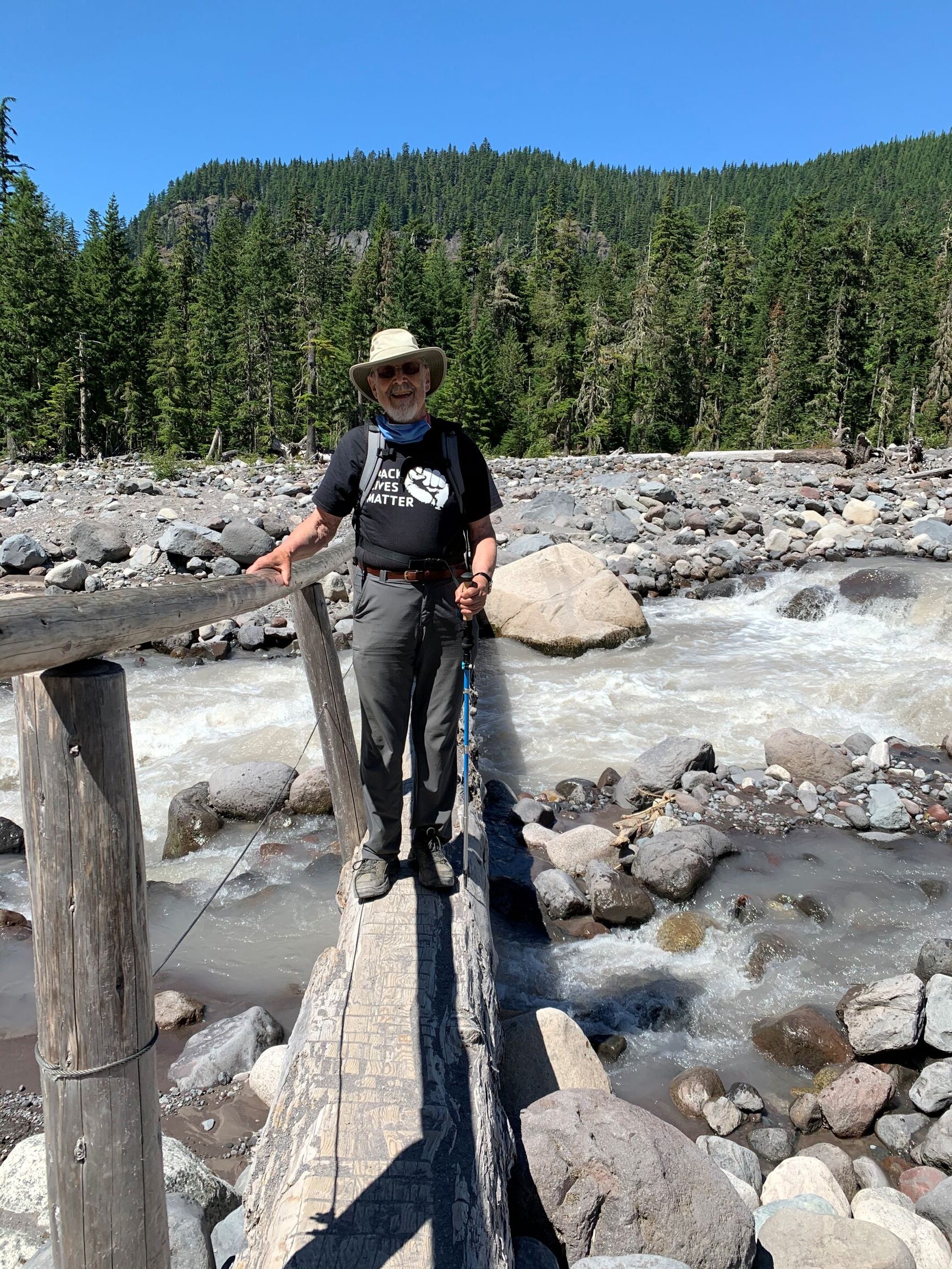
The bridge across the Nisqually. You can see how wide the river’s bed is as a result of huge lahars.
That is why we saw a huge wide channel with random dead trees standing in it. 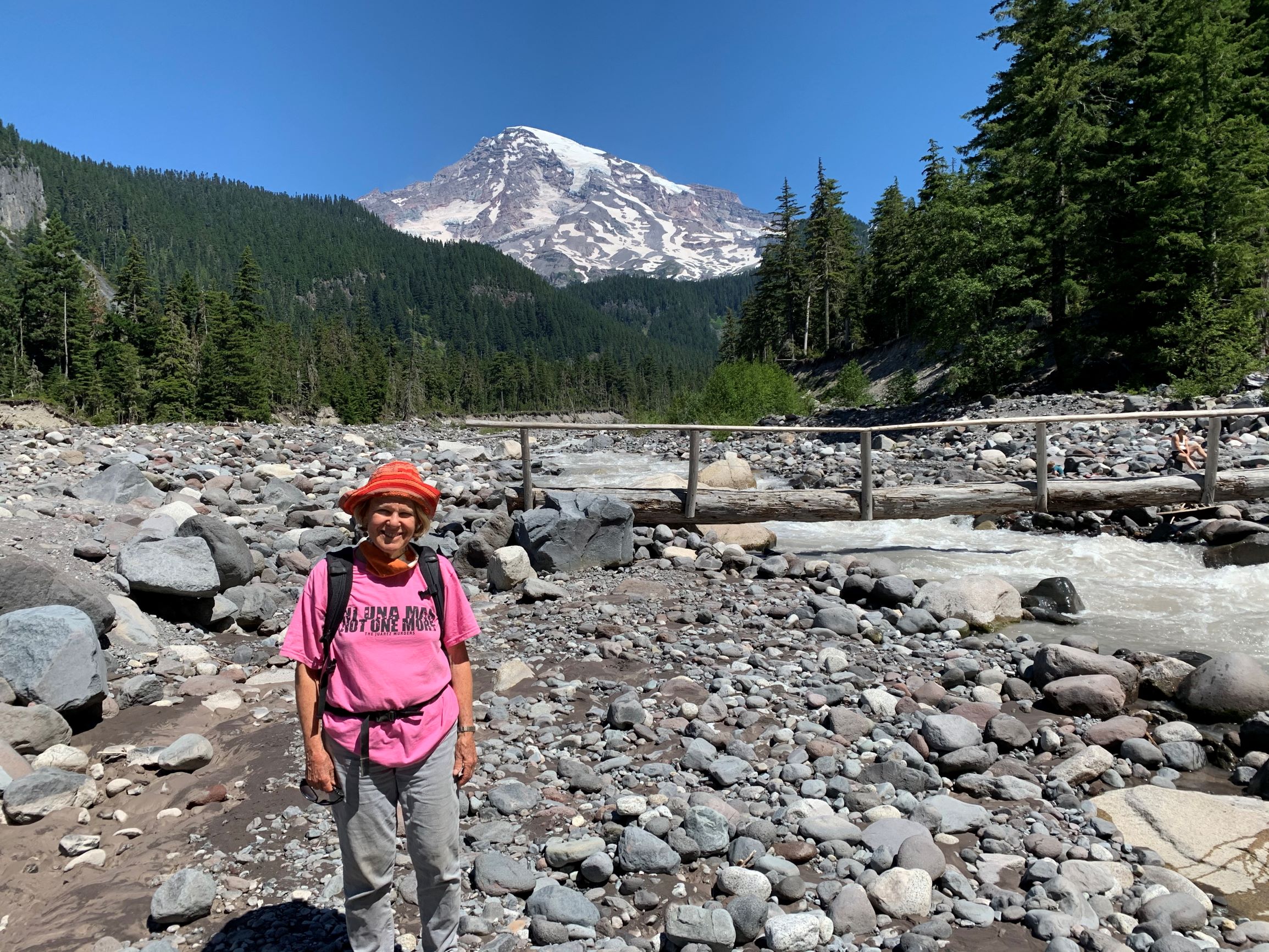
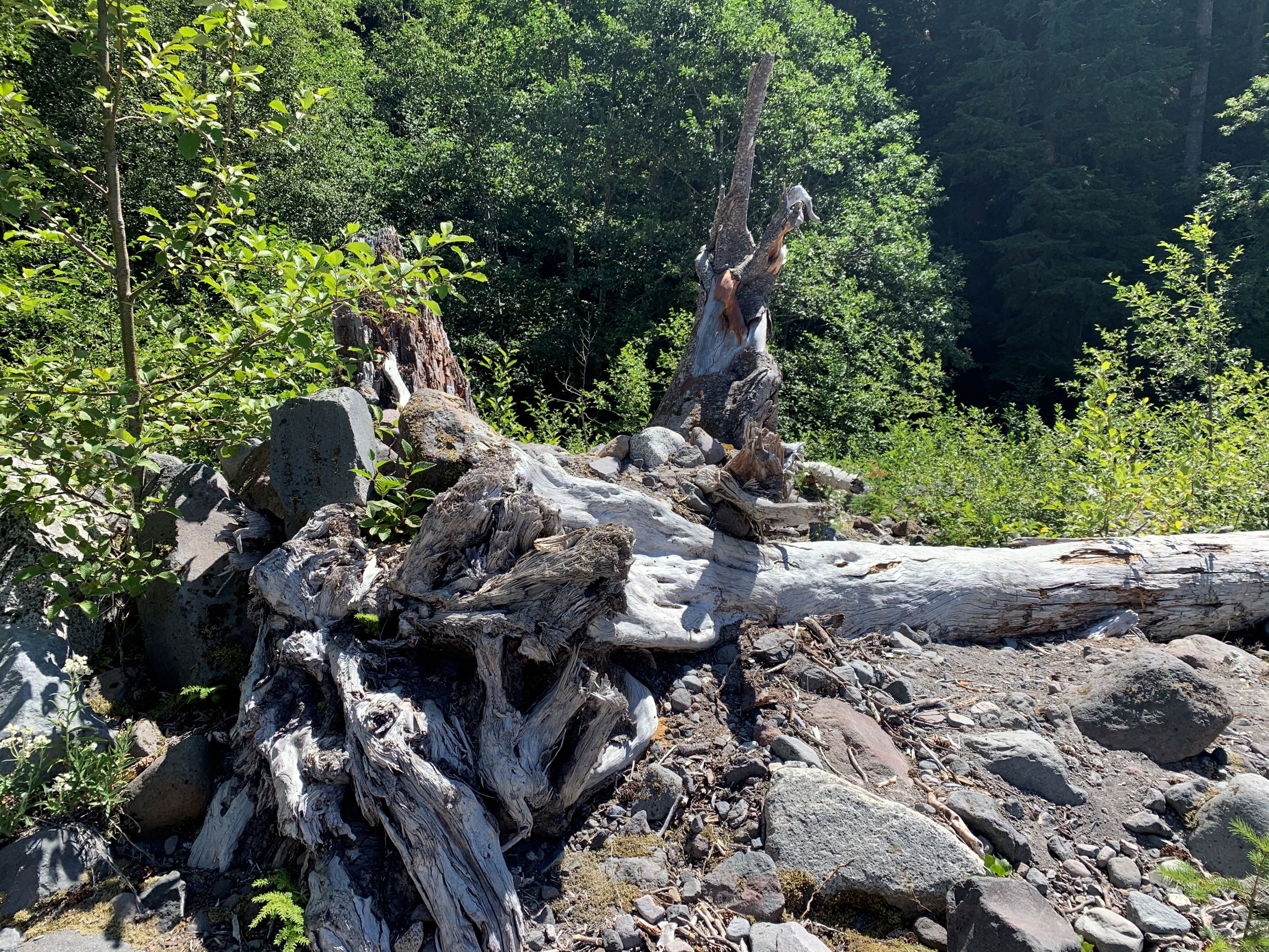
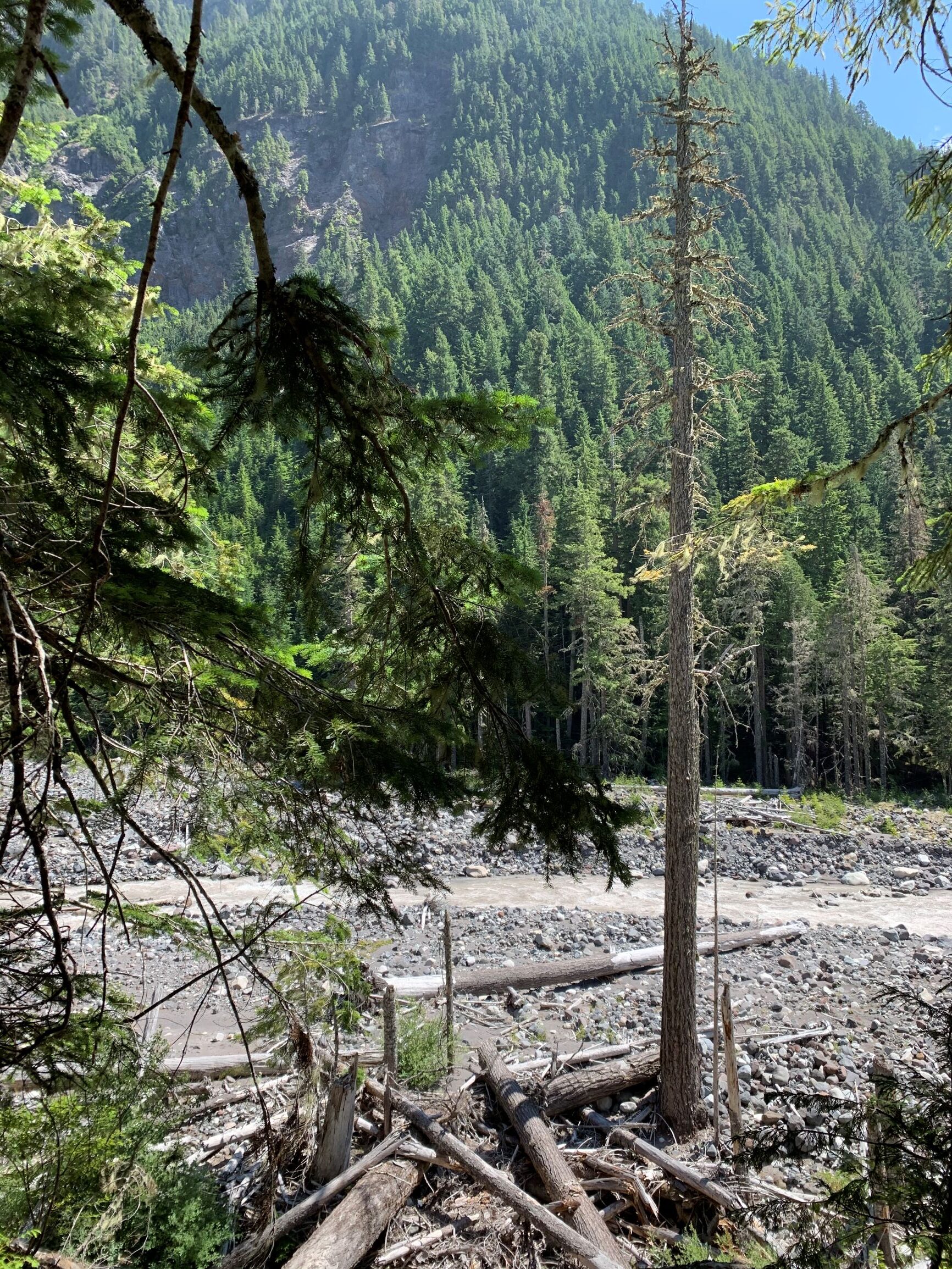
The Narada Falls were explained on a sign as falling between two layers of rock, the lava from the mountain and the underlying, much harder granite.
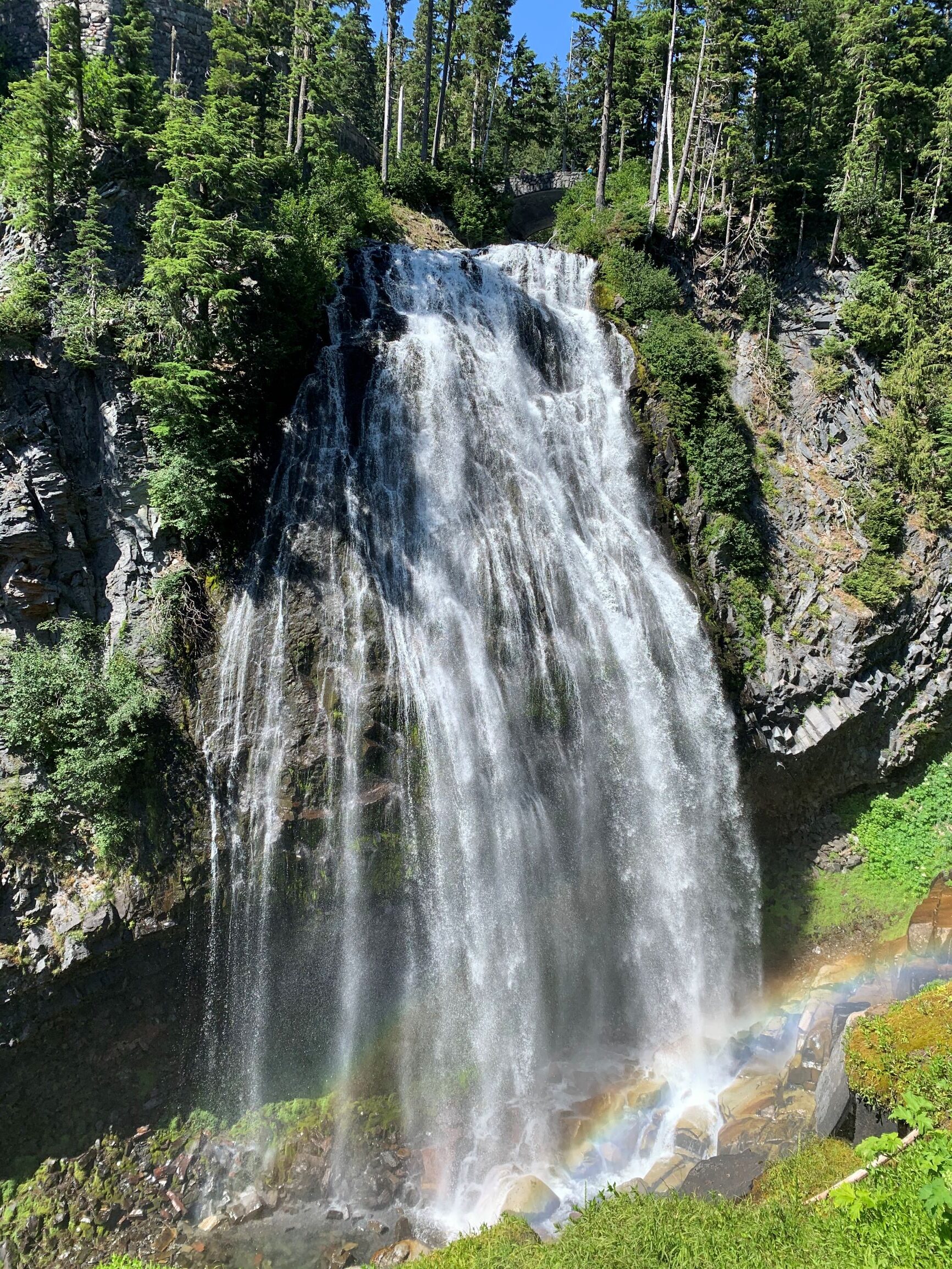
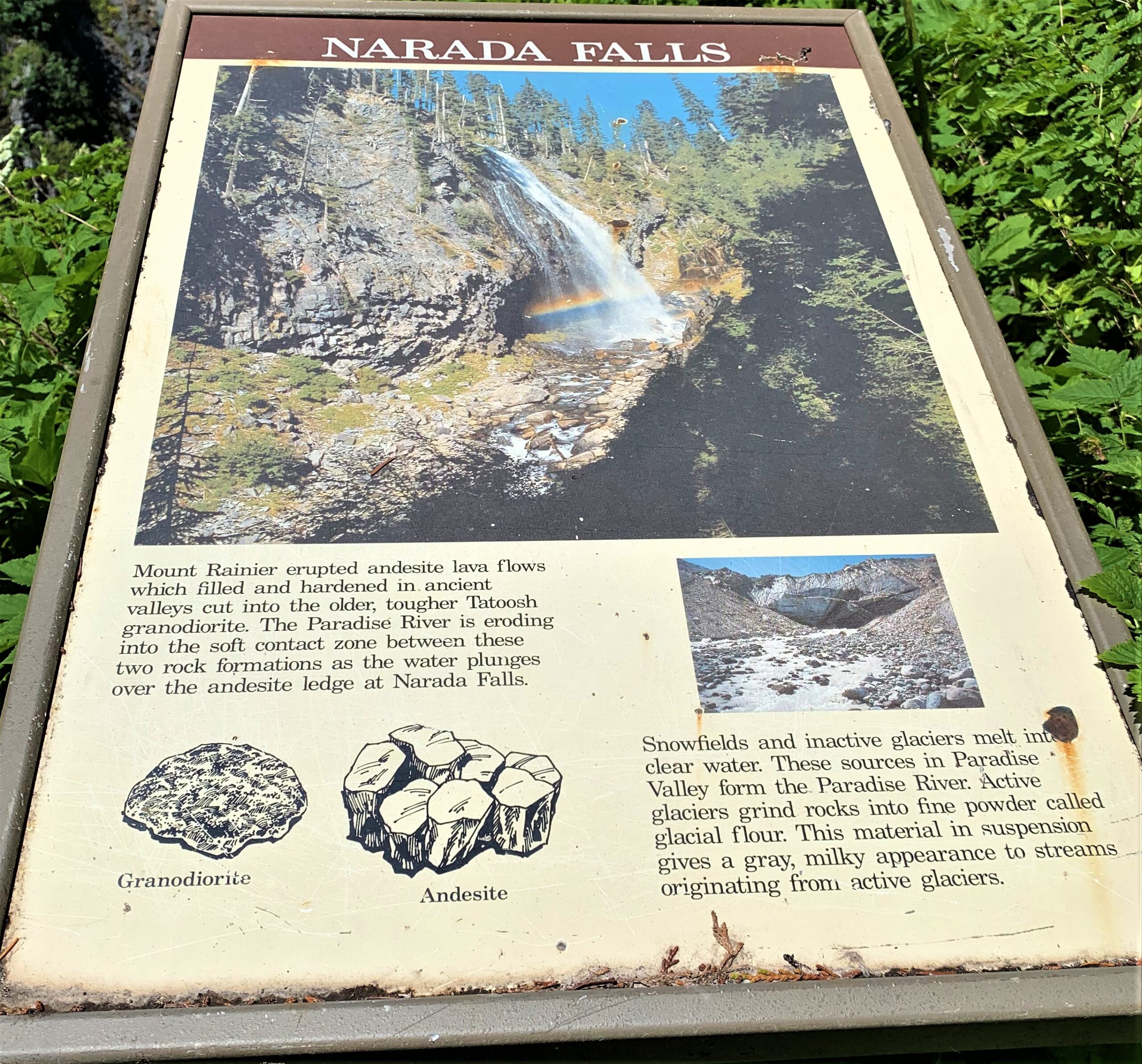
and the deep woods around the Wonderland Trail. Not as deep as they used to be, and many ecological balances are disturbed by warmer winters, leading to infestations of pine bark beetles among other changes. We heard about pine bark beetle damage at Crater Lake four years ago as a result of warmer winters. The Clark’s nutcracker, the iconic bird of these forests, is disrupted in its key functions by pine bark beetle damage.
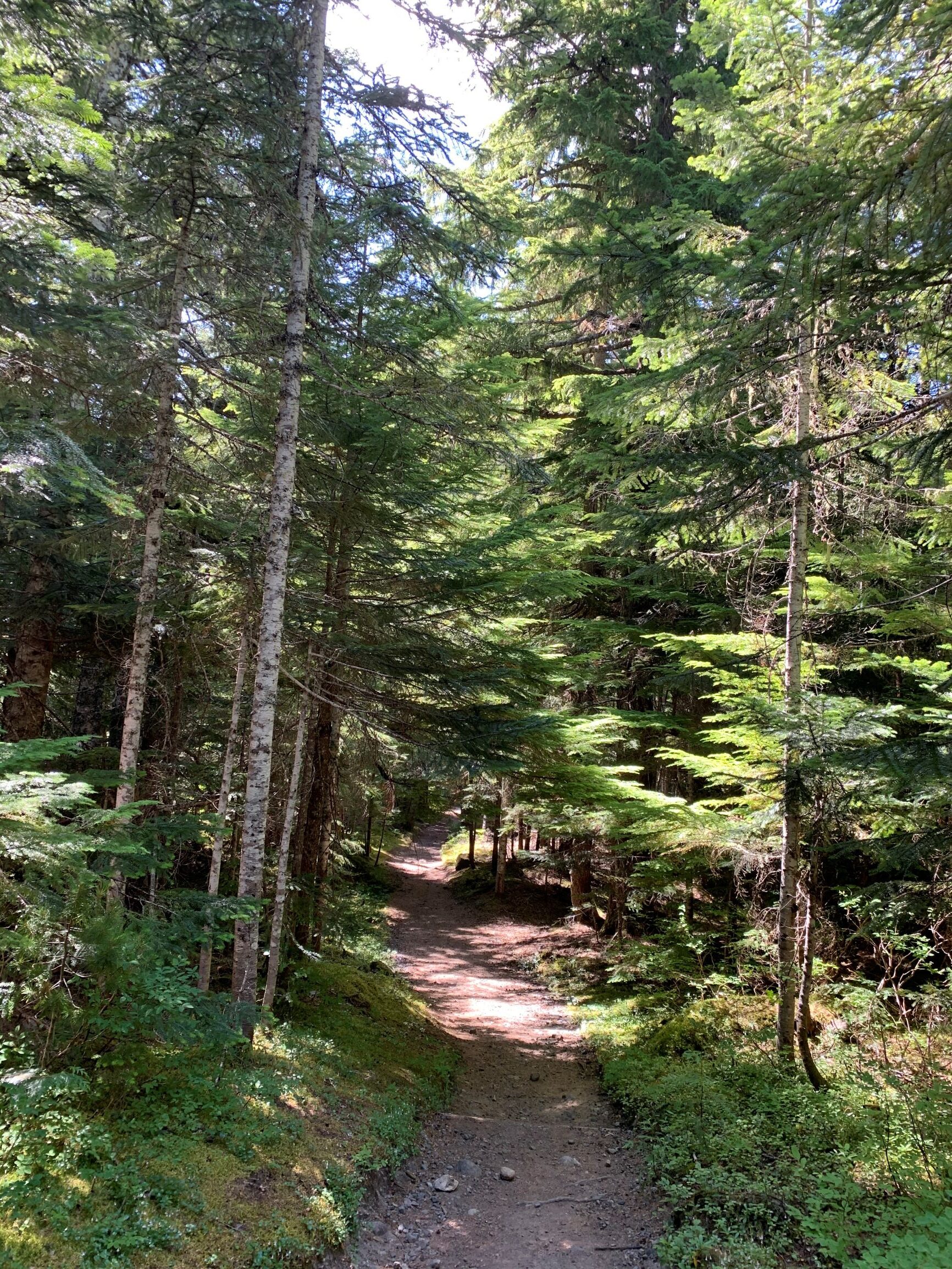
Our landlords at the Stone Creek Lodge showed us photos of ground water flooding in the winter behind their lodge. This is a result of climate change as well, more rain in the winter. And they mentioned that they had mosquitoes for the first time this year. But it was a wonderful place to stay. They couldn’t have been more gracious hosts.
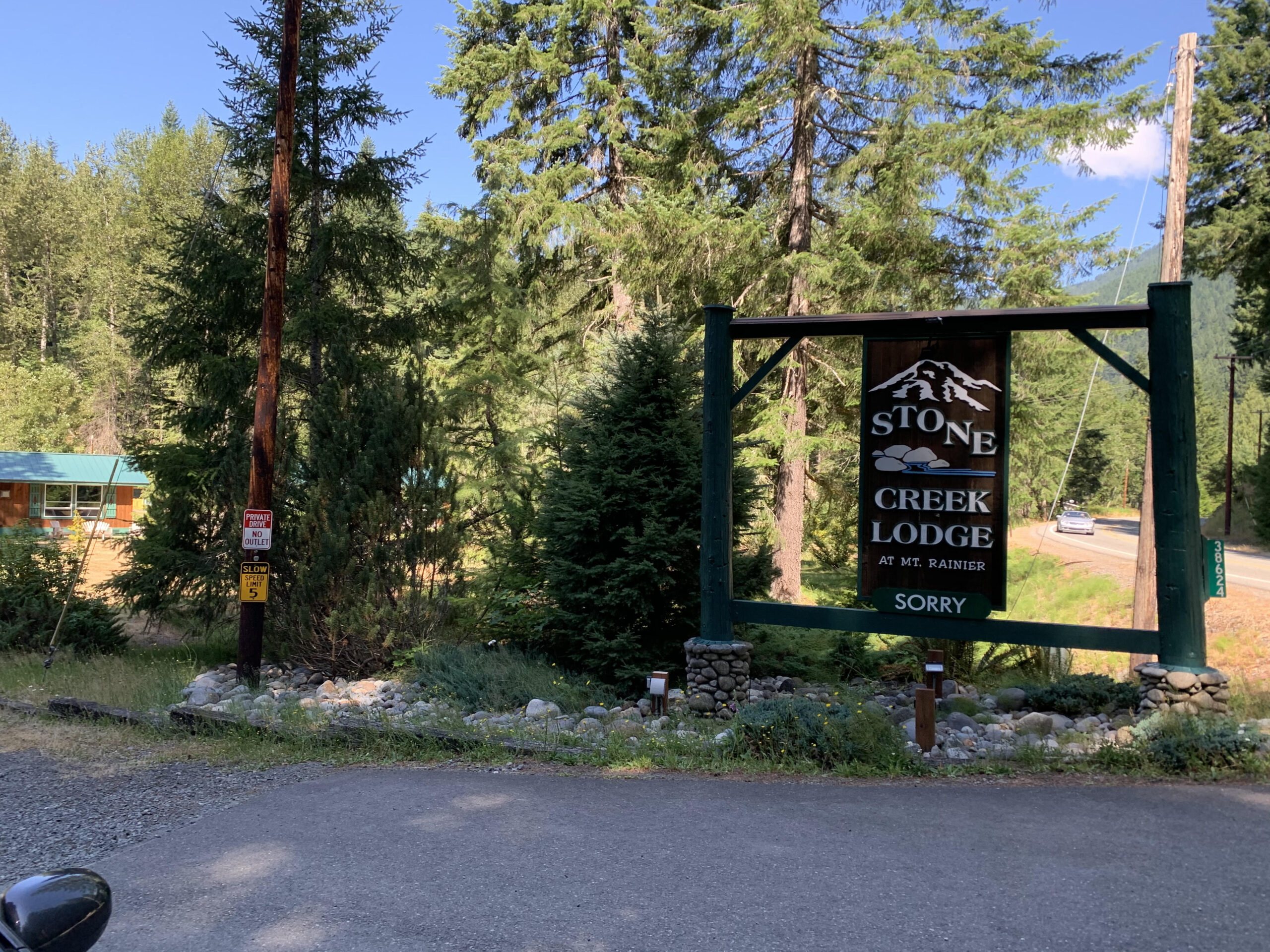
Jeff Antonelis-Lapp’s book includes ancient Indigenous histories, recent cultures of Indigenous peoples as they found so many natural resources there.
He basically circles the mountain going to each entrance, and speaks of the special features of each part of the mountain, its ancient history, its native history, its current state.
The tribal groups have been essential to present day efforts at restoration especially in the Nisqually delta, near the home of the famous Billy Frank at Frank’s Landing. So when you go to Mt Rainier or even when you just gaze on it from Seattle, remember its long long history geologically, and its present state, threatened by climate change.
But above all feel uplifted by its majesty. 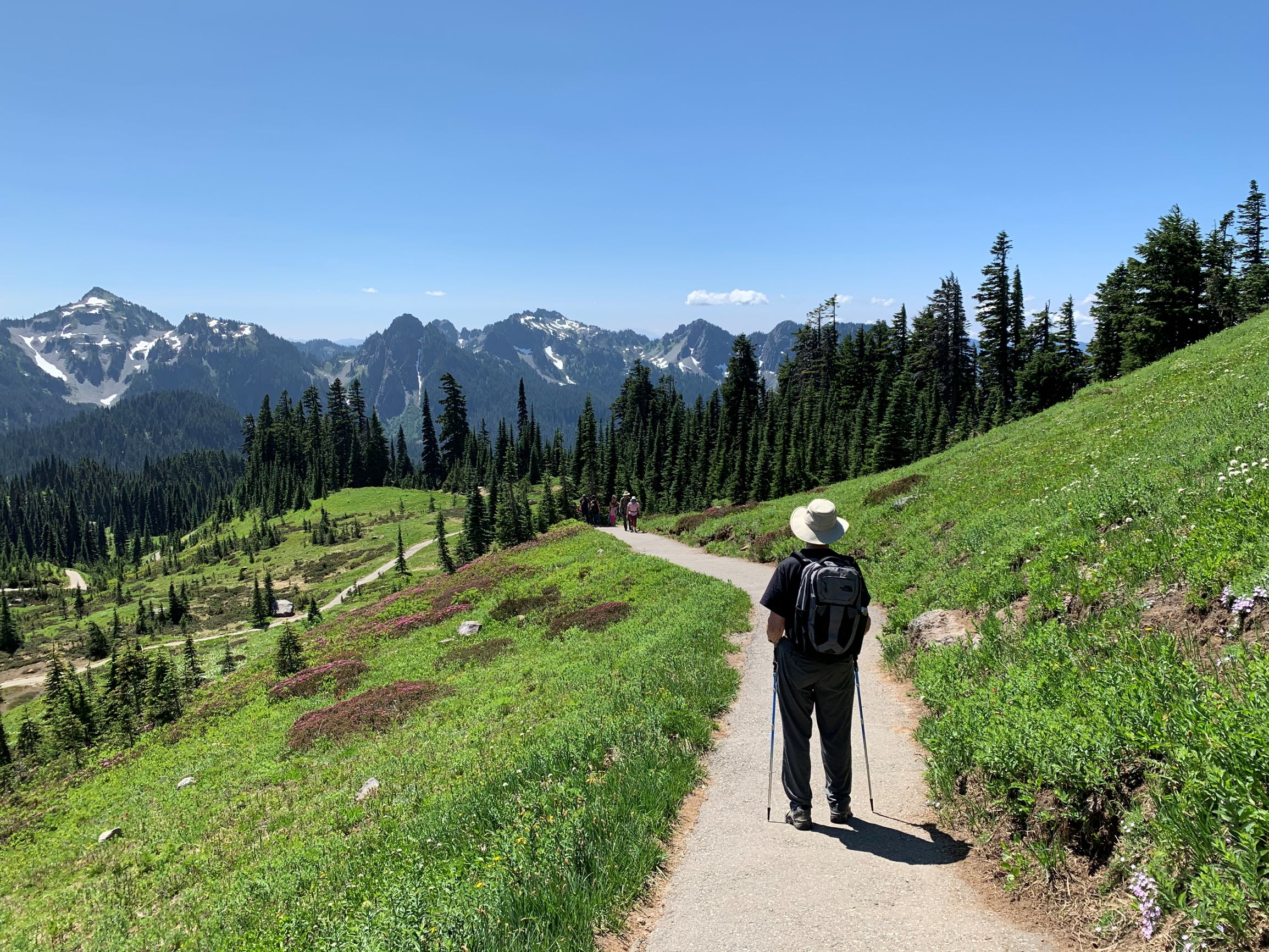
We could easily see that there was less snow on the glaciers of Mt Rainier than even two years ago when we were at Sunrise.
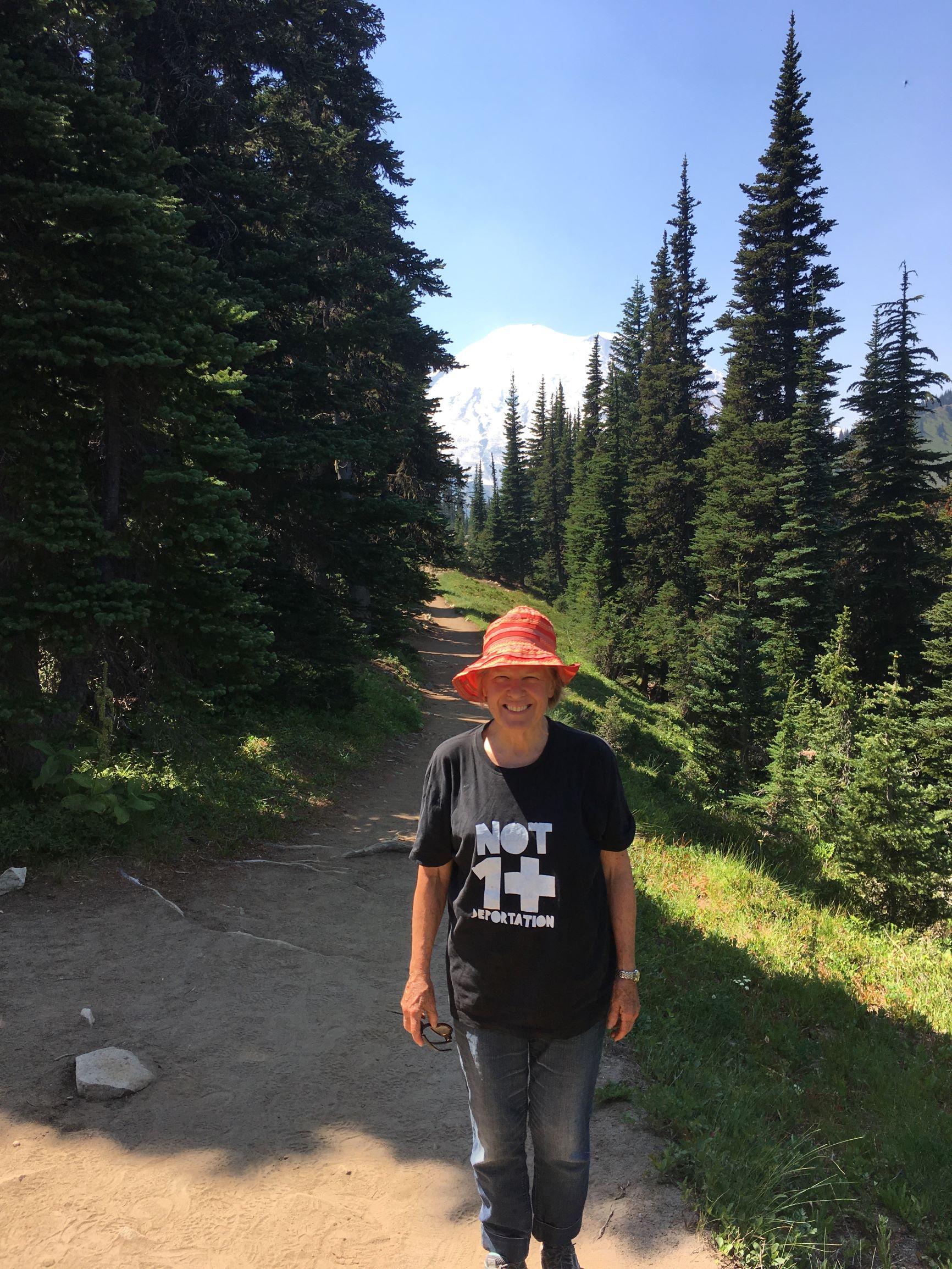
We know that the Greenland glaciers are melting very very fast. And today ferocious wild fires are burning in California and a huge hurricane is headed for the Gulf Coast of the US. Climate Calamities are here.
Go to my new blog Climate Calamities soon for more reporting on that topic. I am so inspired by remembering my fathers trips to the Arctic in 1947 and 1954 to follow the situation today.
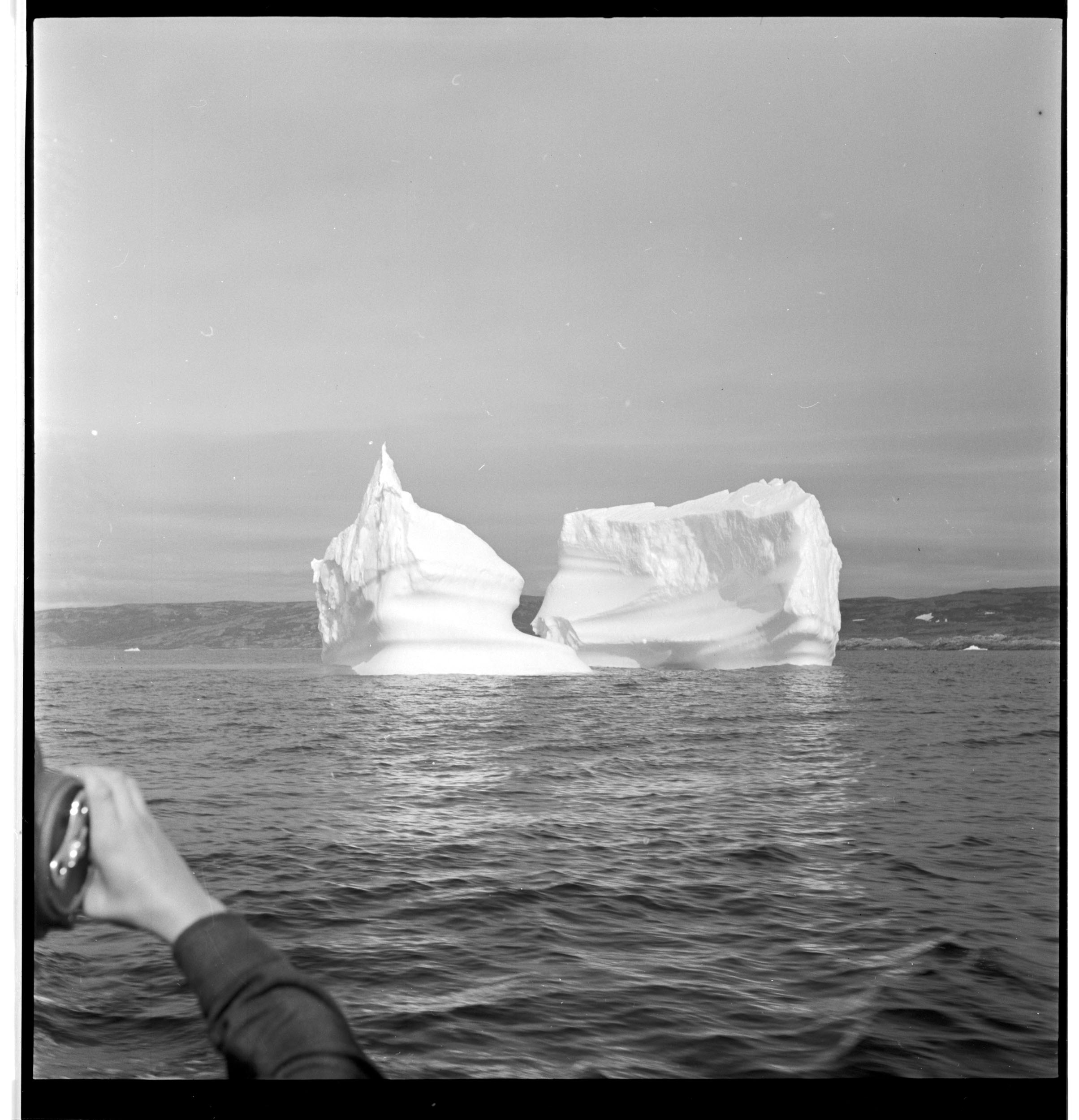
Rutherford Platt; Icebergs; Jul-54; image; cellulose acetate; 6 x 6cm (2 3/8 x 2 3/8 in.); North America
This entry was posted on August 26, 2020 and is filed under ecology.

